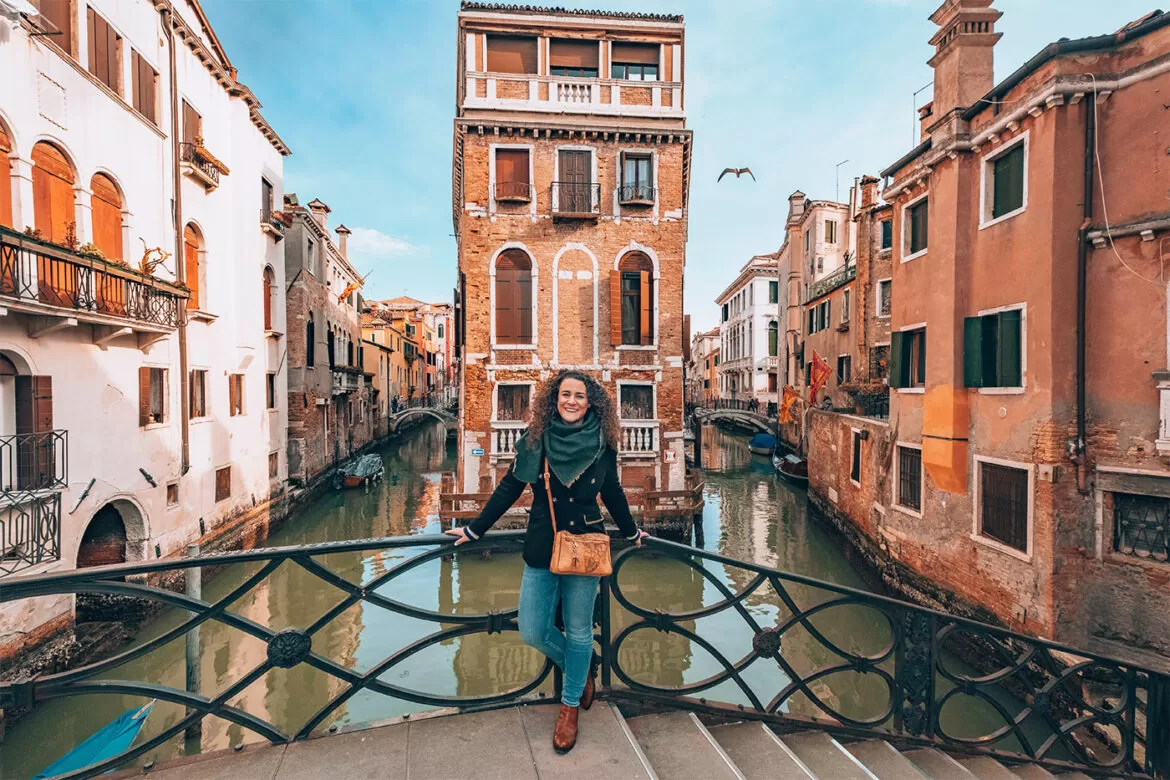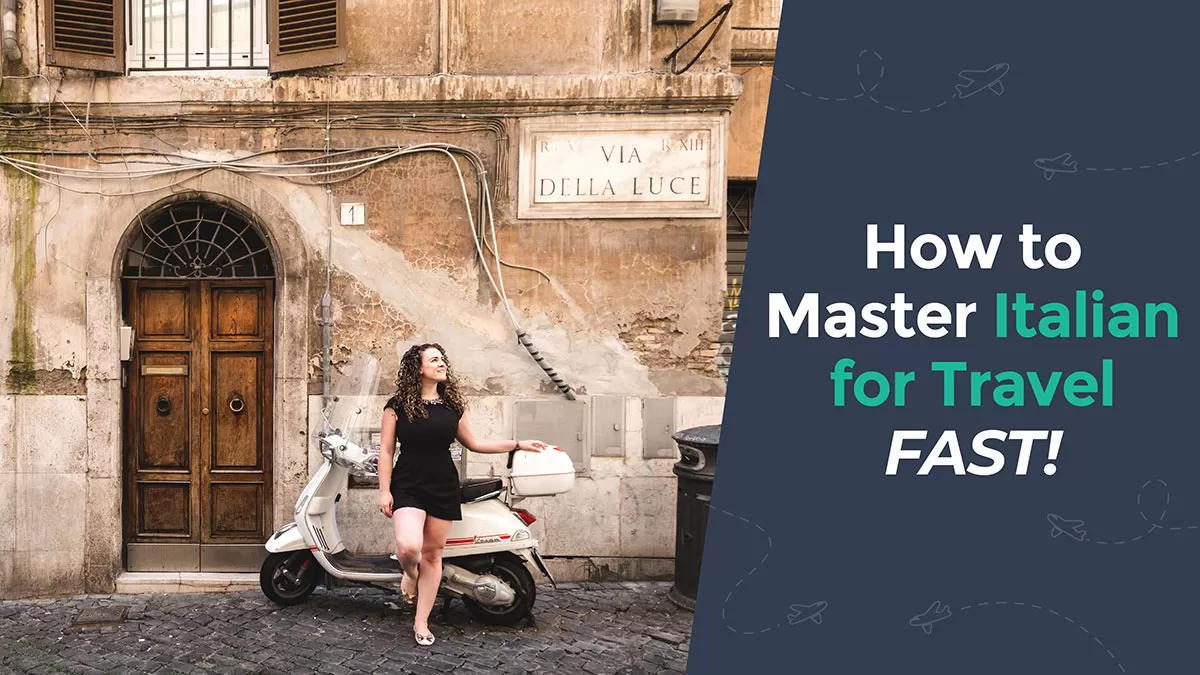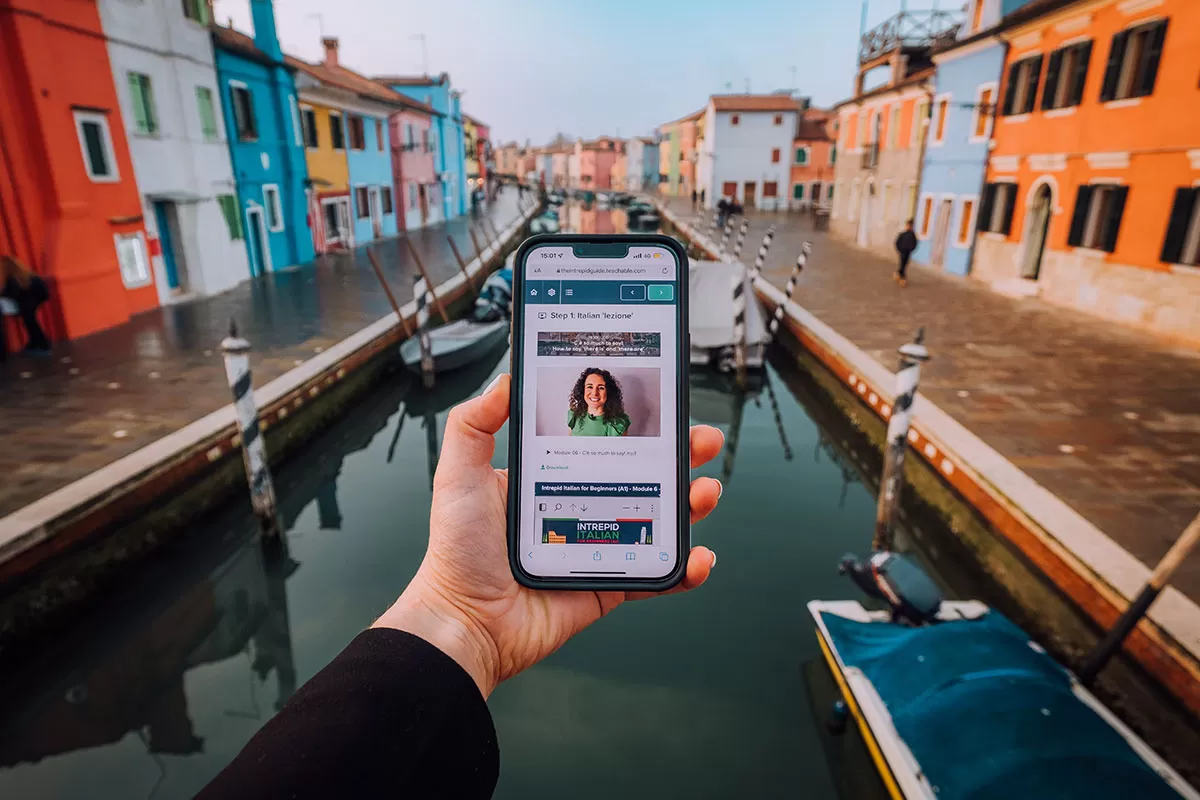Whether it’s your first time visiting Venice, or it has captivated you during the course of numerous trips, I’m going to show you another side of Venice in this guide to surprising things to do in Venice.
Truman Capote said: Venice is like eating an entire box of chocolate liqueurs in one go. There is no better way to describe Venice. It’s decadent, draws you in and leaves a lasting impression. The external beauty of the opulent palazzi (palaces) that line the canals are matched only by their stunning interiors with ceiling frescos, intricate decoration, and lavish furniture.
Then, tucked away behind these impressive facades is a labyrinth network of calli, a local term for the typical narrow streets that exists only in Venice.
In this Venice travel guide, I’ll share with you the best things to do in Venice, top tours for seeing tourist attractions a bit differently, the best hotels in Venice plus fascinating tidbits that go unseen that will help you plan the perfect Venice itinerary that will ensure you have a wonderful trip that you’ll remember for years to come.
Andiamo! (Let’s go!)
History of Venice
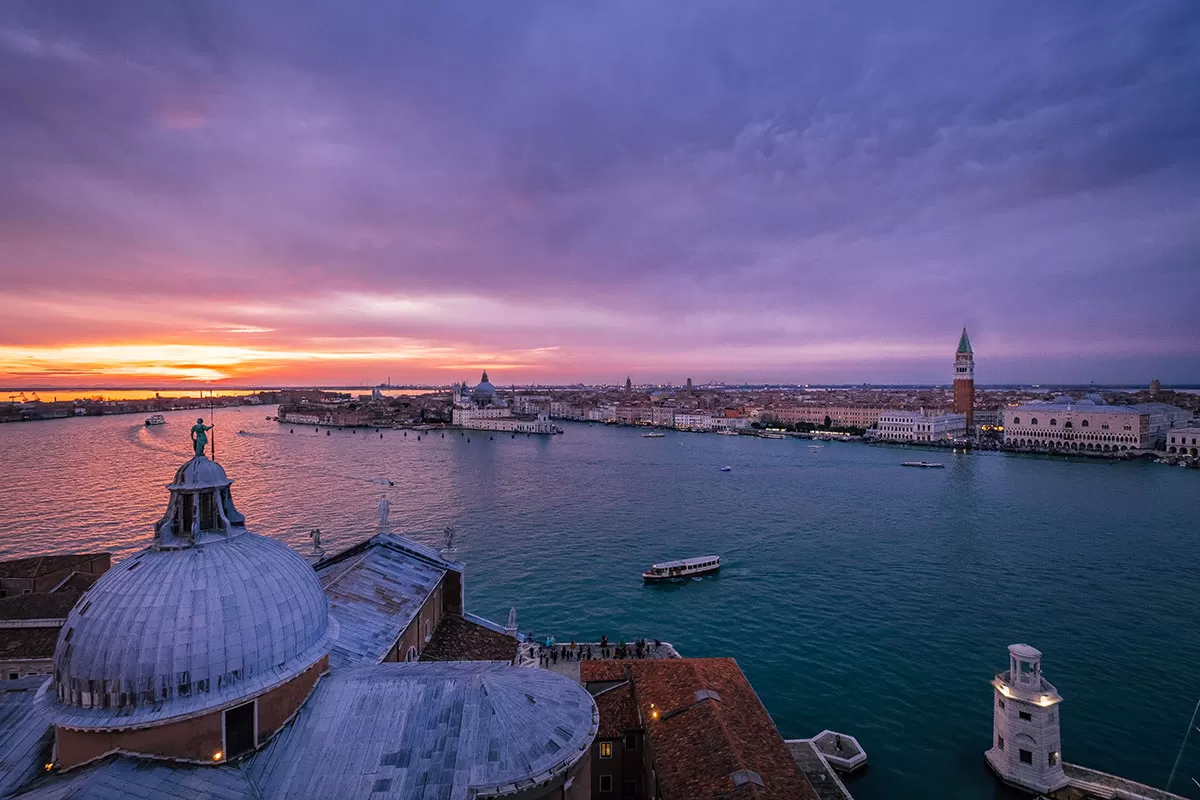 Venice really is a world unto its own. Venetian is its own language which not only influenced standard Italian but even English and other languages. Words such as ciao, ghetto, carnival, and quarantine, all originated in Venice and literally sailed around the world. For more on that check out my guide to everyday words that come from Venice.
Venice really is a world unto its own. Venetian is its own language which not only influenced standard Italian but even English and other languages. Words such as ciao, ghetto, carnival, and quarantine, all originated in Venice and literally sailed around the world. For more on that check out my guide to everyday words that come from Venice.
Along with Genoa, Pisa and Amalfi, Venice was one of four Maritime Republics whose merchants and fleets dominated the whole of the Mediterranean Sea. In fact, the Regatta (or “Palio”) is an ancient rivalry between the four Italian Maritime Republics
But of all of these, the Republic of Venice was the largest and longest-lasting. It expanded onto the mainland where it soon became the most powerful state of Italy. That all changed in 1797 when Napoleon invaded and conquered Venice.
Venice kept its independence until the mid-1800s when it was annexed to the Lombardo Veneto kingdom by the Austro-Hungarian empire.
Venice’s origins date back to the 5th century when the residents of the inland areas of Veneto sought refuge on the lagoon in order to escape the Barbarian invasions.
Until the 8th century, the city was under Byzantine rule, then when it was controlled by an oligarchic government it developed its wealth and influence. In 1200, it reached the height of its power, thanks to trade between the Mediterranean and the East.
How is Venice built?
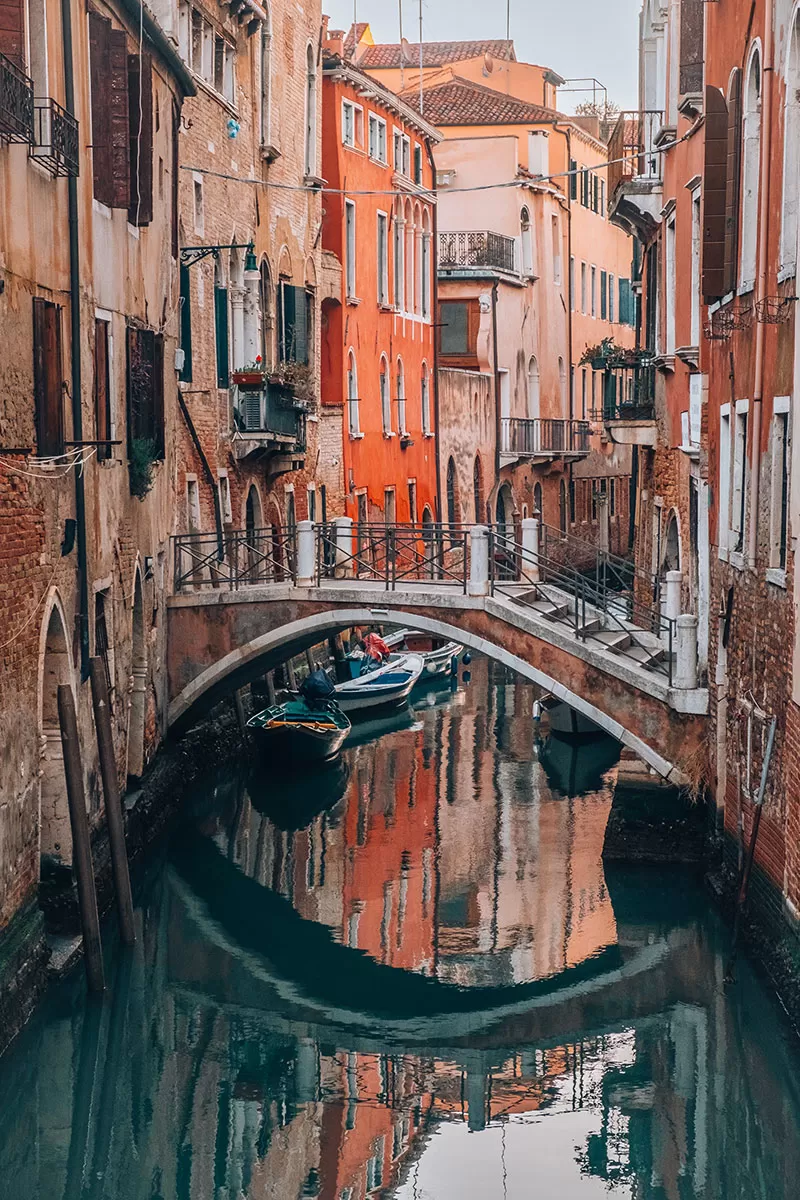 So, how was this floating city built in a marshy lagoon full of nothing but sand and silt?
So, how was this floating city built in a marshy lagoon full of nothing but sand and silt?
To make the islands of the Venetian lagoon habitable, early settlers drained areas of the lagoon, dug canals, and shored up the banks so they could build a solid foundation.
Once the canals were dug, they drove thousands of large, closely-spaced wooden stakes (or pilings) through the water, sand, and mud where they finally rested on the harder clay beneath.
Since there was no forest, all this wood was imported from Montenegro, Slovenia and Croatia. Many of these stakes were made from water-resistant alder wood.
Then, once the stakes were levelled off in the ground, wooden platforms and then stone is placed on top. It’s on top of this that the buildings of Venice are built.
Still today, wooden pilings are used when maintenance work is carried out. This is because once the wood is submerged in almost-zero-oxygen conditions, the wood is not only preserved, but it petrifies into a stone-like state thanks to the flow of mineral-rich water in the immediate vicinity.
The depth of each canal varies, but most are only 1.5 to 2 metres deep. The entire Grand Canal, which runs through the heart of Venice, is deeper with an average of 5 metres. Much deeper still is the Canale della Giudecca – which separates the main part of Venice from the island of Giudecca, this is around 12 to 17 metres deep.
Watch my Unique things to do in Venice video guide
1. Explore the world’s first Ghetto with a local
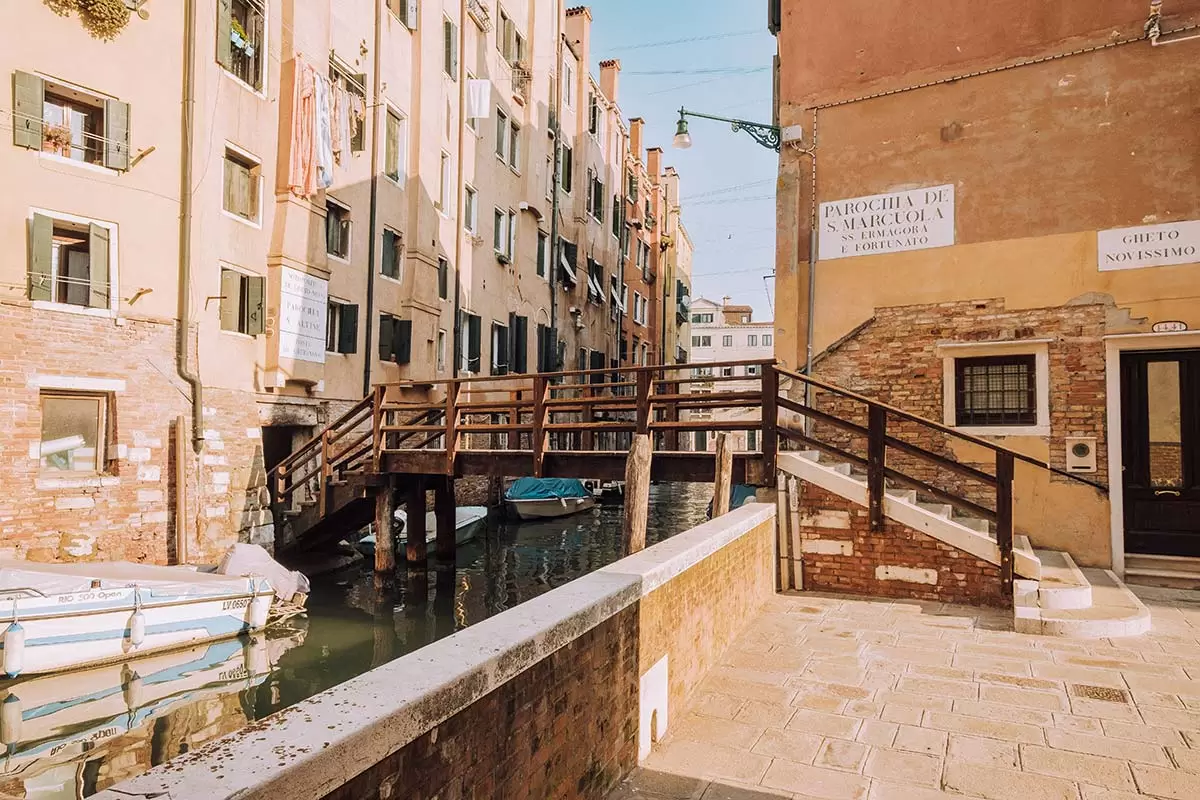 Venice is divided into six neighbourhoods called sestieri. This term comes from the Italian word for ‘sixth’ which is ‘sesto’. A sestiere is the same as a ‘quarter’ in any other European city which is one-fourth of a Roman encampment. Located in the north of the island is the sestiere (the singular form of sestieri ) of Cannaregio and it is here that the world saw its first ghetto.
Venice is divided into six neighbourhoods called sestieri. This term comes from the Italian word for ‘sixth’ which is ‘sesto’. A sestiere is the same as a ‘quarter’ in any other European city which is one-fourth of a Roman encampment. Located in the north of the island is the sestiere (the singular form of sestieri ) of Cannaregio and it is here that the world saw its first ghetto.
I highly encourage you to join this dedicated Ghetto walking tour of this area which is led by one of its locals, Lucia. There is so much Venetian history in this one sestiere that I recommend you join this tour first then spend the rest of the day wandering around and let it all sink in.
There are several reasons why this area is so special. First, the term ‘ghetto’ originated here from the Venetian term for ‘foundry’. During the 1500s, there were copper foundries in the area called ‘getto’ (pronounced je-toh), in Italian it’s called ‘gettata’ (pronounced jet-ta-ta) which cast molten metal.
At the time, the Cannaregio Canal was the main entry point into the heart of Venice. As the main thoroughfare, the area grew to form a population primarily made up of the working class housing and manufacturing.
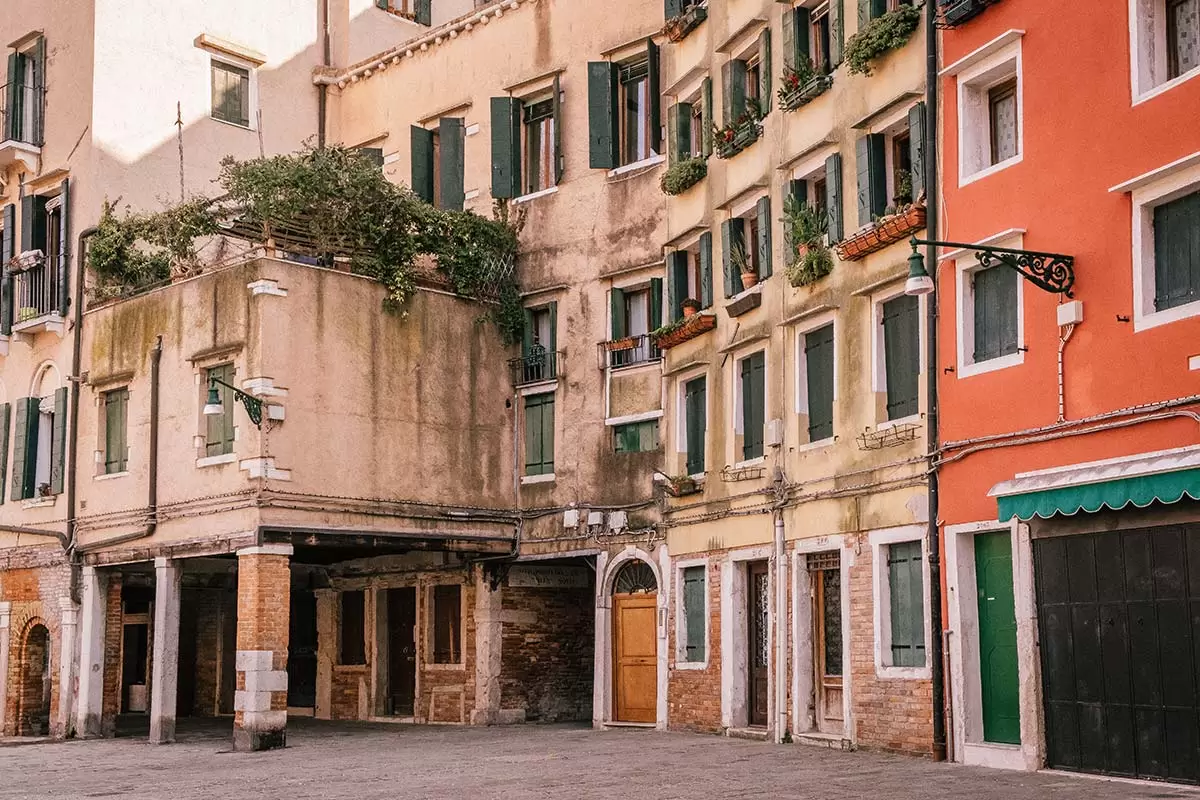
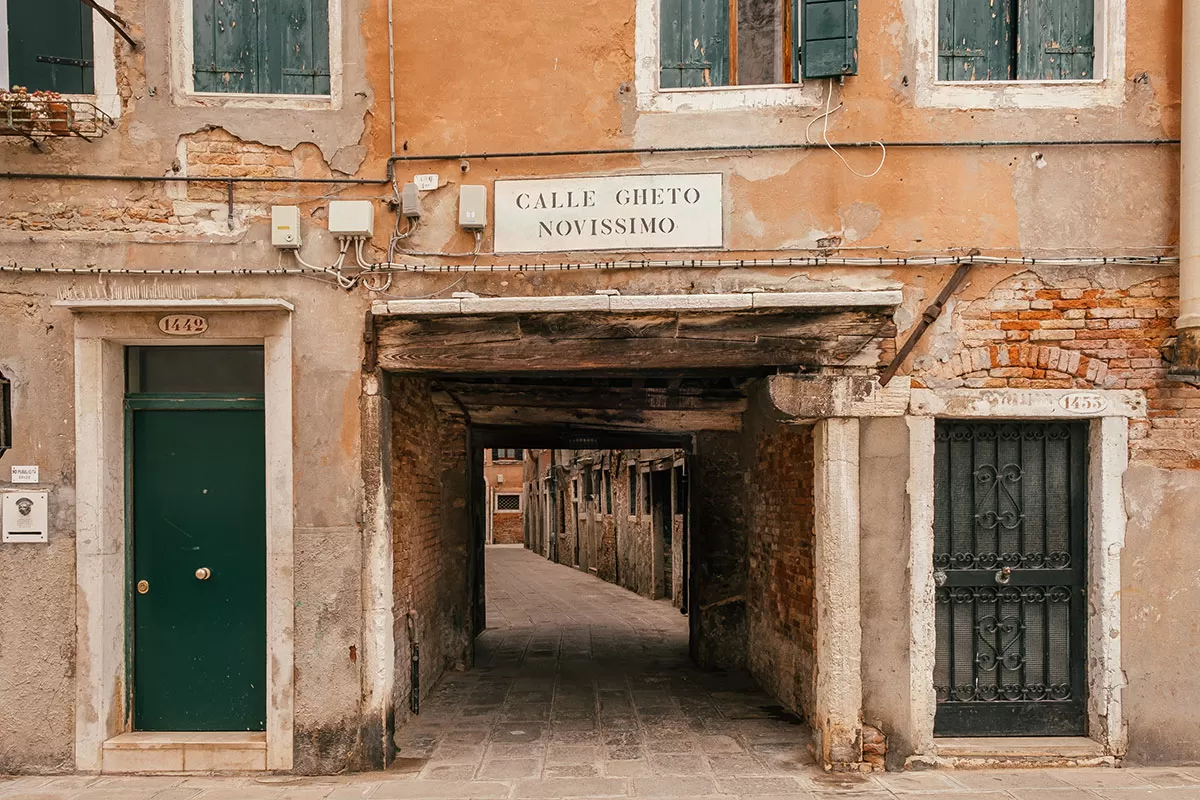 From 1516, the Jewish community were obliged to live in a confined area of the city and wear a sign of identification. This was done in exchange for which the Jew community was granted the freedom to practice their faith and receive protection from enemies elsewhere in Europe.
From 1516, the Jewish community were obliged to live in a confined area of the city and wear a sign of identification. This was done in exchange for which the Jew community was granted the freedom to practice their faith and receive protection from enemies elsewhere in Europe.
The first Jews to observe this law in Venice were the Ashkenazim, from mid-eastern Europe. With the combination of their guttural pronunciation and the Venetian term “geto”, formed the word “ghetto’. A term that is still used today to refer to this part Venice.
This “Ghetto” was enclosed by guarded gates and no one was allowed to leave from sunset to dawn. To enforce this, the surrounding canals were patrolled by boats of the Christian guards who discouraged violations. This is how the world’s first ghetto came to be.
During this time, however, Jews held successful positions in Venice such as physicians, money lenders, and merchants and were allowed to leave the confines of the Ghetto from early morning till sunset.
These restrictions on the Jewish community remained in place for some 270 years, until Napoleon Bonaparte conquered the Venetian Republic in 1797. Napoleon put an end to the Jewish segregation and gave them equal rights and the choice to live in any place of their choosing.
Then, during the 16th century, the term “ghetto” spread throughout Europe and began to refer to the tragic episodes of racism during World War II in the early 1900s.
Today, the Jewish Ghetto in Venice is a lively and popular district of the city where the religious and administrative institutions of the Jewish community and its five synagogues still persist.
Called “scole”, there are 5 synagogues located here in the Venetian ghetto that was established between the early-sixteenth and mid-seventeenth centuries. Each synagogue represents a different ethnic group that sort refuge here in exchange for religious freedom. These include the German, Canton, Italian, Levantine and Spanish “scole”.
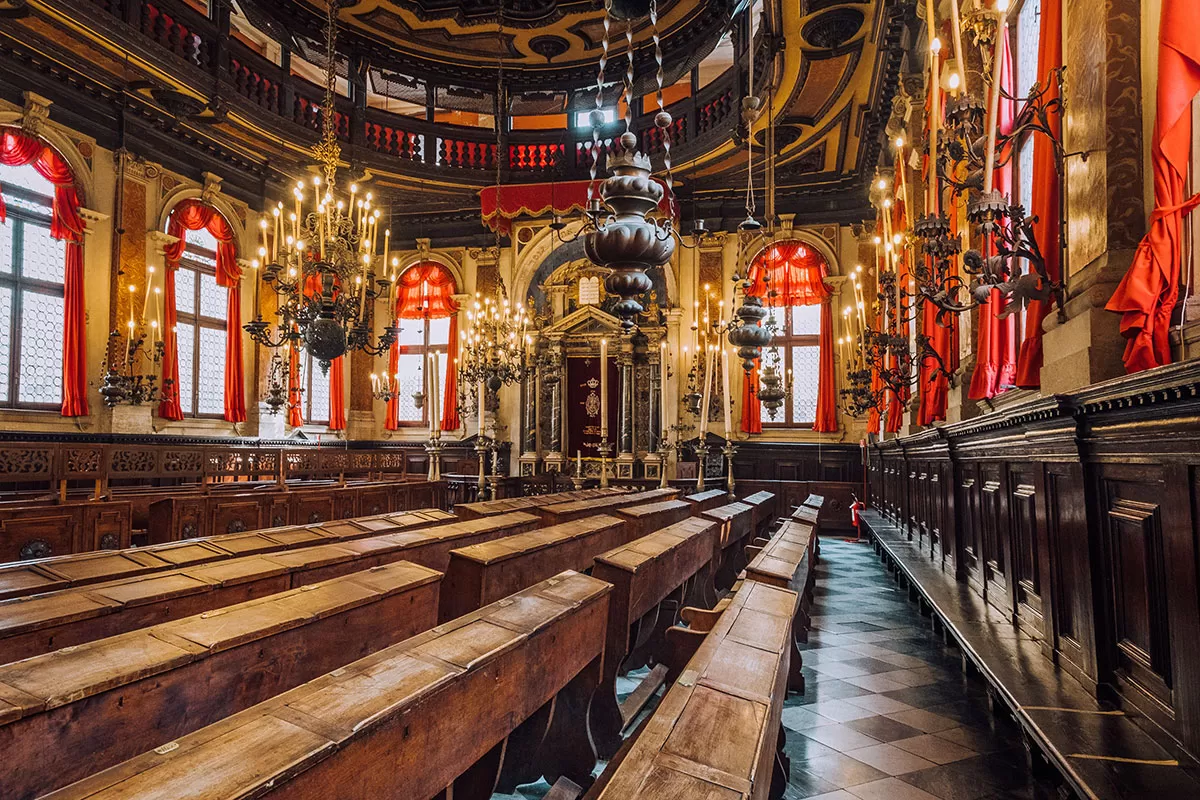 What’s interesting is that from the outside, you wouldn’t know there was a synagogue inside, this, sadly, was due to the fact that these religious buildings weren’t allowed to stand out or be obvious to any non-Jewish person visiting the area. They had to be discrete.
What’s interesting is that from the outside, you wouldn’t know there was a synagogue inside, this, sadly, was due to the fact that these religious buildings weren’t allowed to stand out or be obvious to any non-Jewish person visiting the area. They had to be discrete.
To visit inside, you must book a private tour that includes the Spanish synagogue and the Cohanim midrash. Bookings can be made through the Jewish Museum of Venice.
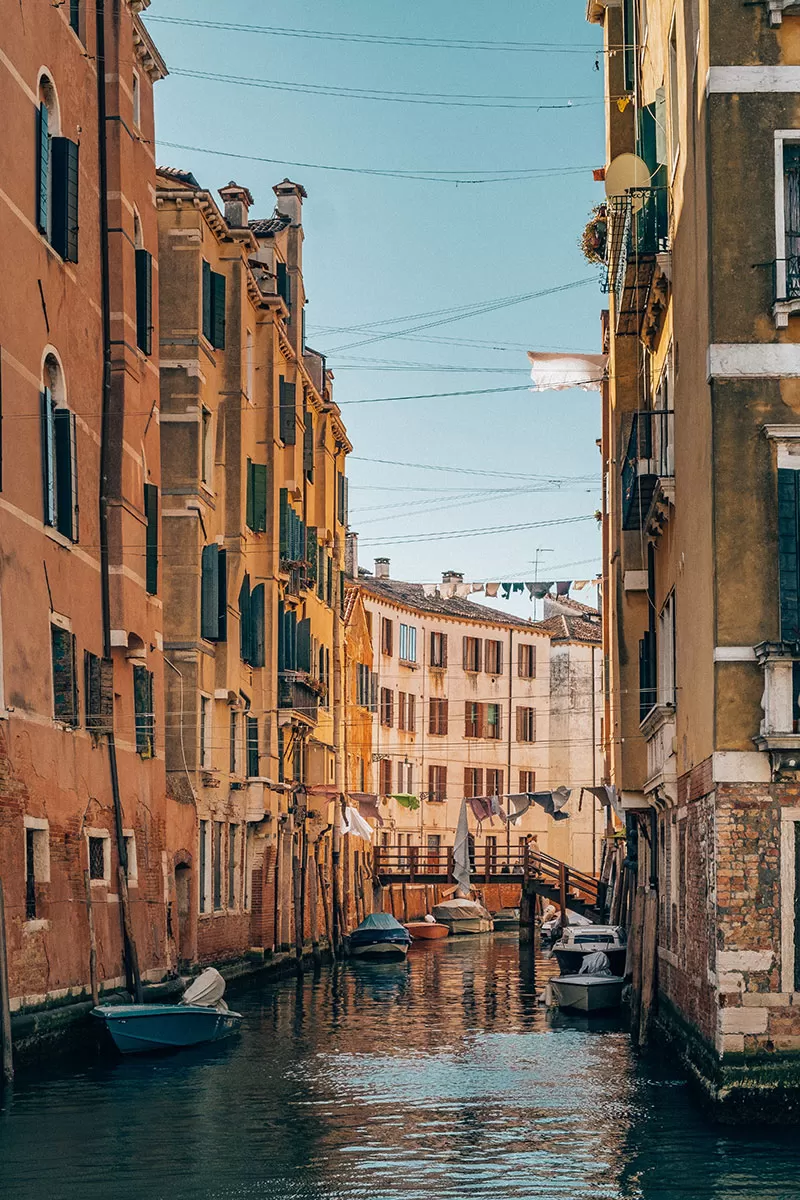 One more interesting tidbit is that the world’s first lending bank is located here. What not many people know is that Jews were essentially forced to be money lenders, because, since the Middle Ages, the Catholic Church considered lending money and earning interest to be sinful.
One more interesting tidbit is that the world’s first lending bank is located here. What not many people know is that Jews were essentially forced to be money lenders, because, since the Middle Ages, the Catholic Church considered lending money and earning interest to be sinful.
Here in the world’s first ghetto were three stalls where you could pledge an object in exchange for a cash loan. These three banks, red, green and black, survived until the end of the Republic (1797). Fortunately, today you can still see one of these stalls, Banco Rosso (Red Bank). Its name derives from the red receipt that customers received when they received a loan. It is widely believed that the banking term ‘to be in the red’ derives from this ancient Venetian bank.
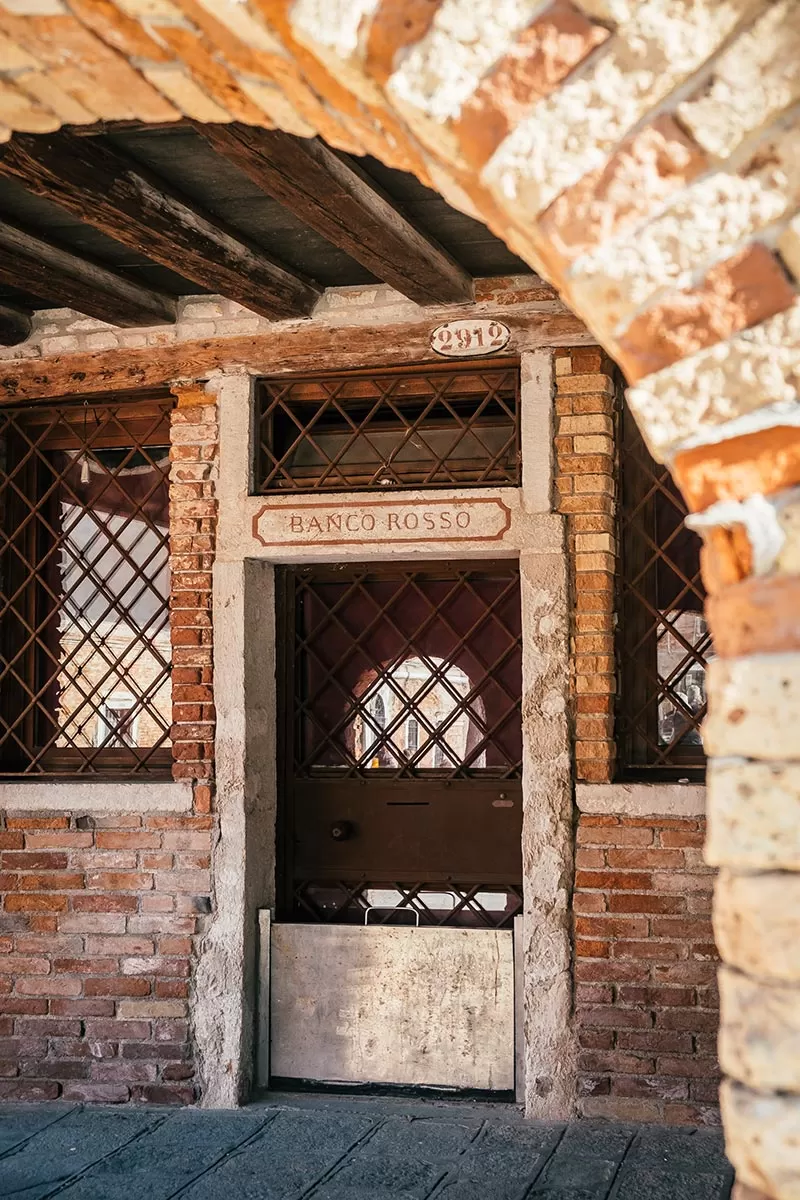 Jewish money lenders are documented in Venice as early as the 14th century but their regulation took place during the 1500s when the Ghetto was established; the state itself encouraged the activity of these banks, in order to have fewer poor people to care for.
Jewish money lenders are documented in Venice as early as the 14th century but their regulation took place during the 1500s when the Ghetto was established; the state itself encouraged the activity of these banks, in order to have fewer poor people to care for.
As you can see, there’s a lot to see and learn in this one area alone. To experience it properly, I recommend joining this tour.
2. See the statues at Campo dei Mori
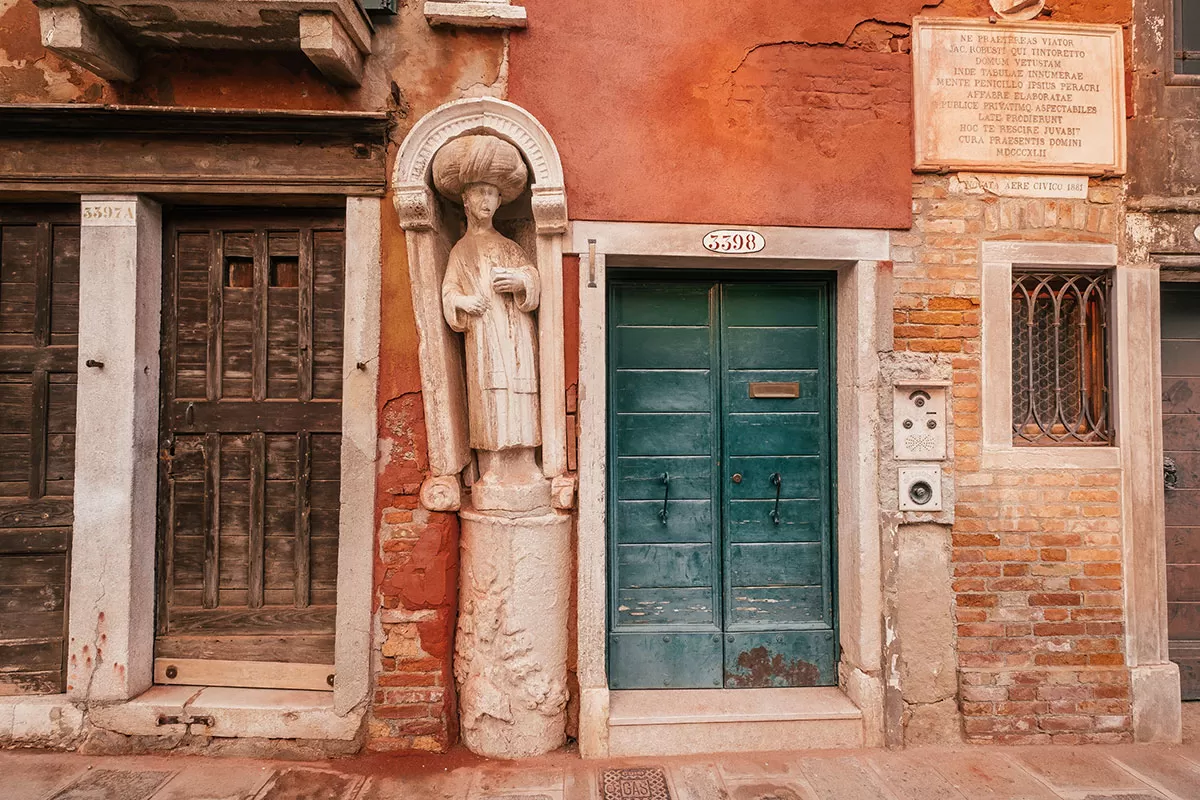 Campo dei Mori is a square named after three statues set in the ancient walls that surround the area. The three statues are of three oriental men (or Moors), who were brothers. Named Rioba, Sandi and Afani, they were part of the Mastelli del Cammello family who built the entire area. A fourth statue is located elsewhere on the quay.
Campo dei Mori is a square named after three statues set in the ancient walls that surround the area. The three statues are of three oriental men (or Moors), who were brothers. Named Rioba, Sandi and Afani, they were part of the Mastelli del Cammello family who built the entire area. A fourth statue is located elsewhere on the quay.
The three brothers were called Mastelli (meaning ‘bucket or tub’ in Italian) because they “had thousands of tubs of gold coins”. Of the three statues, the most notable is of Sior Antonio Rioba, who lost its nose and was replaced with a piece of iron. From then on, a legend grew that rubbing his nose would bring luck.
According to the legend, one of the brothers’ activities was in banking where he is said to have defrauded a devout Venetian woman. She then prayed to Santa Maria Maddalena to curse the three merchants and as a result, the Mastelli brothers turned into these stone statues as a warning to anyone who saw them.
A short distance away, there is a bas-relief on the façade of Palazzo Mastelli (on Rio della Madonna dell’Orto) which shows a turbaned man wearing oriental clothing and leading a camel, this refers to the family’s spice trade.
3. See where Tintoretto was born at Casa del Tintoretto
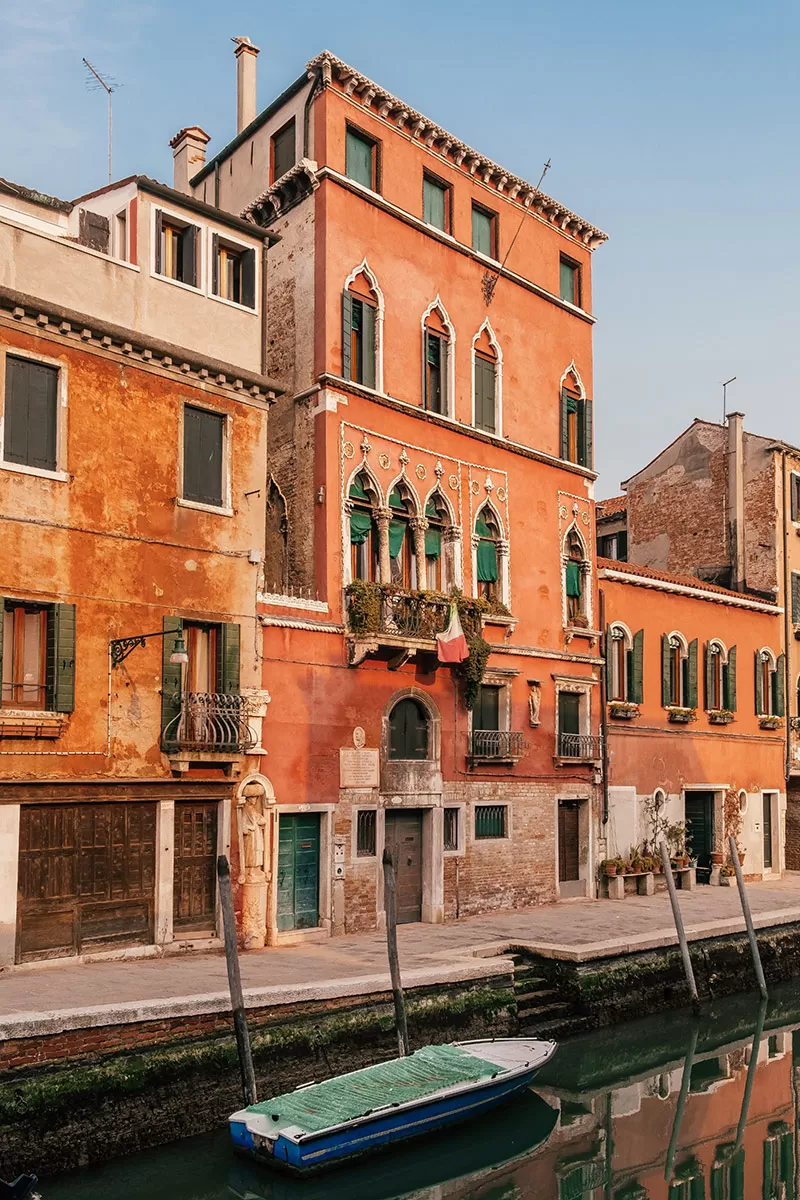 On the same quay as Campo dei Mori, at the foot of the bridge, is a large 15th-century pink Gothic house that was the home of the painter Tintoretto.
On the same quay as Campo dei Mori, at the foot of the bridge, is a large 15th-century pink Gothic house that was the home of the painter Tintoretto.
In 1518, Jacopo Robusti, aka Tintoretto was born here. Tintoretto’s father, Battista Robusti, was a fabric dyer. It was from this profession that he derived the nickname with which the artist became famous all over the world. The Italian verb “tintare” means “to tint” or “to dye”.
The house was given to Tintoretto by his father-in-law, Marco Vescovi, and the painter lived there until his death in 1594.
There is a plaque placed on the facade says:
Do not ignore, hiker, the ancient house of Jacopo Robusti, called il Tintoretto. From here for everywhere diffused countless paintings, publicly and privately mirable, masterly made with fine ingenuity by his brush. You will please learn this for the solerce of the current owner. 1842
4. Private guided tour inside the Doge’s Palace, St. Mark’s Cathedral with exclusive balcony access
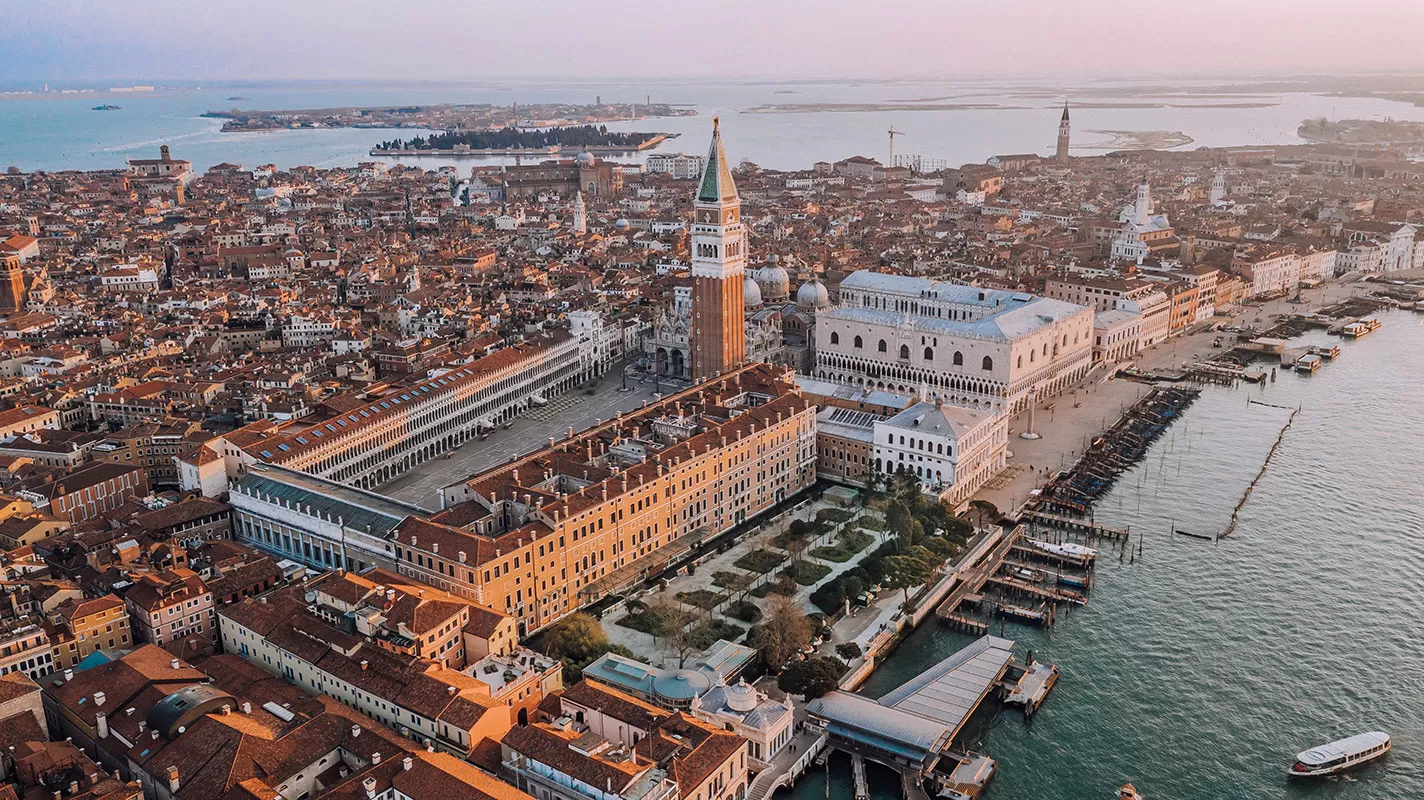 No trip to Venice would be complete without exploring the Doge’s Palace called Palazzo Ducale in Italian. As one of the city’s most famous landmarks and tourist attractions, it’ll always encourage large crowds and long queues to enter the Palace. Skip the fuss and the stress and book yourself this private guided tour like I did.
No trip to Venice would be complete without exploring the Doge’s Palace called Palazzo Ducale in Italian. As one of the city’s most famous landmarks and tourist attractions, it’ll always encourage large crowds and long queues to enter the Palace. Skip the fuss and the stress and book yourself this private guided tour like I did.
There’s no better way to see the Doge’s Palace than through the eyes of a local who can bring to life the long history of his important building.
The Doge’s Palace was the seat of Venice’s government for over seven centuries. This masterpiece of Gothic architecture has survived storms, crashes and conspiracies. It was only outdone by Casanova, the notorious seducer who escaped from the attic prison!
A doge the head of state, but for all his importance, he lived like a prisoner in a gilded suite inside the palace, unable to leave without permission.
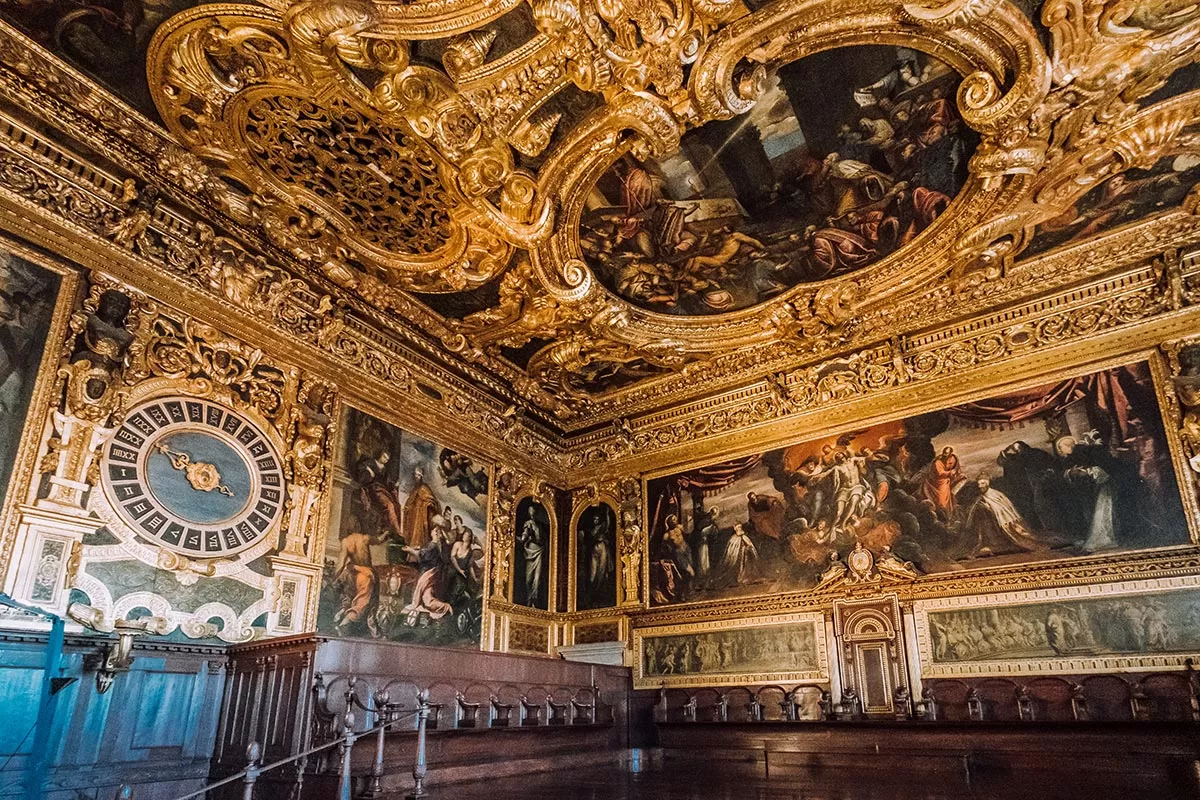
Senate Chamber inside the Doge’s Palace
In 1577, a fire destroyed the original palace. Antonio da Ponte restored its previous grandeur using white Istrian stone and Veronese pink marble. The colonnade is made up of medieval capitals depicting important Venetian guilds.
Don’t be fooled but the lovely arcaded loggia that runs along the ‘piazzetta’ (Italian: little square), it was between the ninth and 10th columns from the left that death sentences were read!
The most spectacular areas of the Doge’s Palace are located on the top floor. Climb Sansovino’s impressive 24-carat gold leaf stucco-work staircase called Scala d’Oro (Golden Staircase) and you’ll be led into rooms filled with gorgeous propaganda.
When you enter the Sala delle Quattro Porte (Hall of the Four Doors) designed by Palladio, take a moment to imagine the ambassadors who awaited ducal audiences here under these lavish paintings of Venice’s most talented artists – Giovanni Cambi, Titian and Tiepolo.
One of the most interesting rooms is the Sala dello Scudo (Shield Room), where you’ll see world maps displaying the impressive reach of Venetian power between 1483 to 1762.
Located in the colonnaded courtyard is the Scala dei Giganti (Staircase of the Giants) designed by Antonio Rizzo. Towering above at the top are the two muscular statues of Apollo and Neptune by Sansovino.
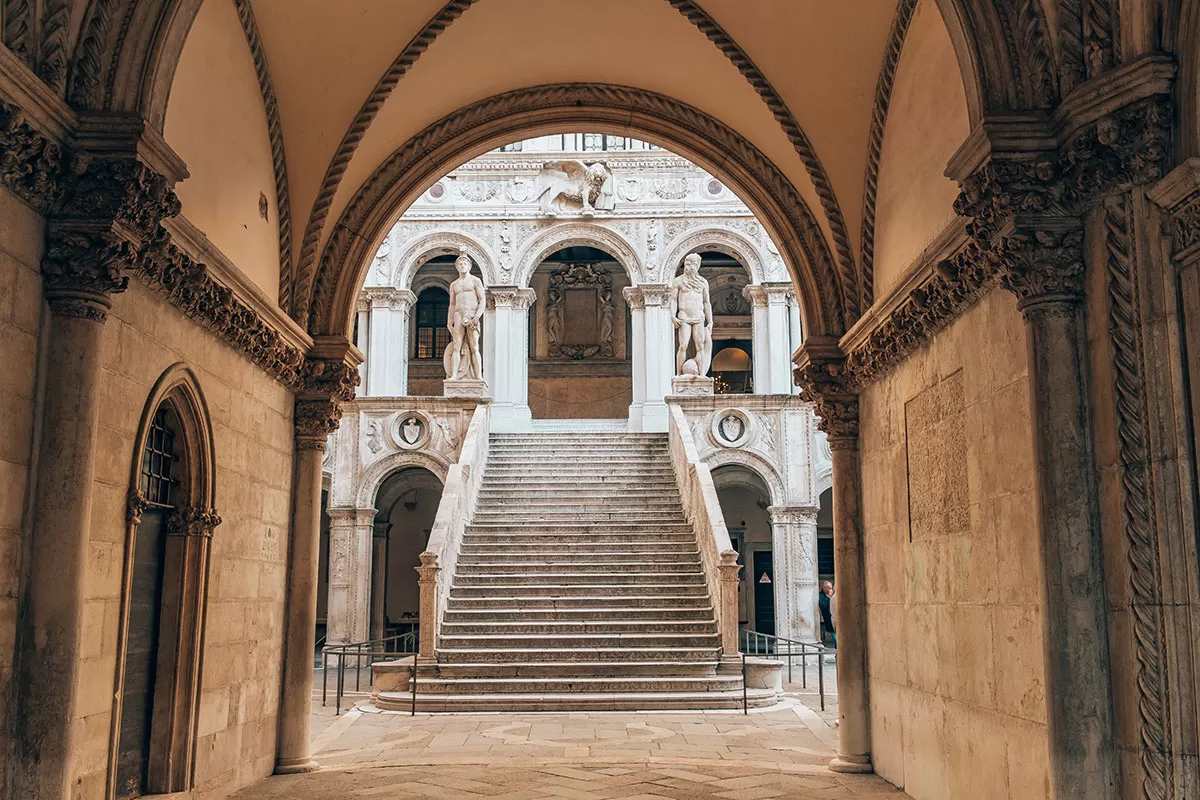 Perhaps the most important room is the epic Sala del Maggior Consiglio (Hall of the Grand council). It was here that all Venetian nobles gathered when they had to make important decisions, such as the election of a new Doge, or to start a war campaign against the Turks.
Perhaps the most important room is the epic Sala del Maggior Consiglio (Hall of the Grand council). It was here that all Venetian nobles gathered when they had to make important decisions, such as the election of a new Doge, or to start a war campaign against the Turks.
Foreign guests were brought here which is why the walls are covered with paintings representing the great battles and victories of Venice. At 52.7 meters long, 24.66 meters wide and 11.50 meters high, the Sala del Maggior Consiglio is the largest in the Doge’s Palace, covering over 1250 square meters.
Located at the head of the room is where the doge’s throne once stood. Behind it is one of the largest canvas paintings in the world. ‘Il Paradiso’ by Tintoretto stretches 22 by 7m and depicts Il Paradiso (heaven/paradise) that is crammed with 500 prominent Venetians, including several patrons of Tintoretto.
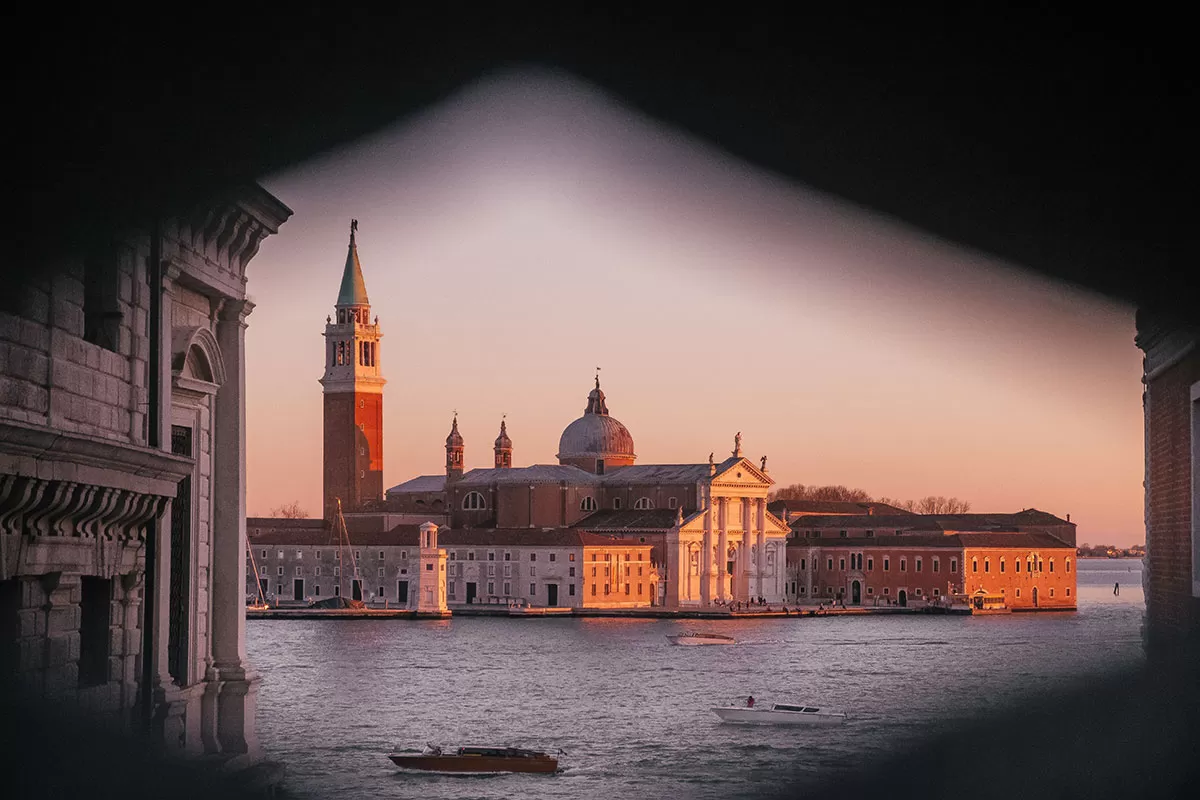
View from inside the Bridge of Sighs
The tour also gives you access to the famous Bridge of Sighs (Italian: Ponte dei Sospiri). This enclosed white limestone bridge was built in 1600 and passes over the Rio di Palazzo to connect the New Prison (Italian: Prigioni Nuove) to the interrogation rooms in the Doge’s Palace.
Fun fact: The Bridge of Sighs was designed by Antonio Contino, whose uncle Antonio da Ponte designed the Rialto Bridge.
The English name for the bridge was given by Lord Byron. In the 19th century, Byron translated the name from the Italian Ponte dei sospiri (literally: Bridge of Sighs) and interpreted it to mean that the prisoners would ‘sigh’ at their final glimpse of beautiful Venice through the windows of the bridge before being taken down to their cells.
However, in reality, the days of inquisitions and executions were over by the time that the bridge was built, and the cells under the palace roof were occupied mostly by small-time criminals. Also, very little could be seen through the window because of the thick stone grills covering them.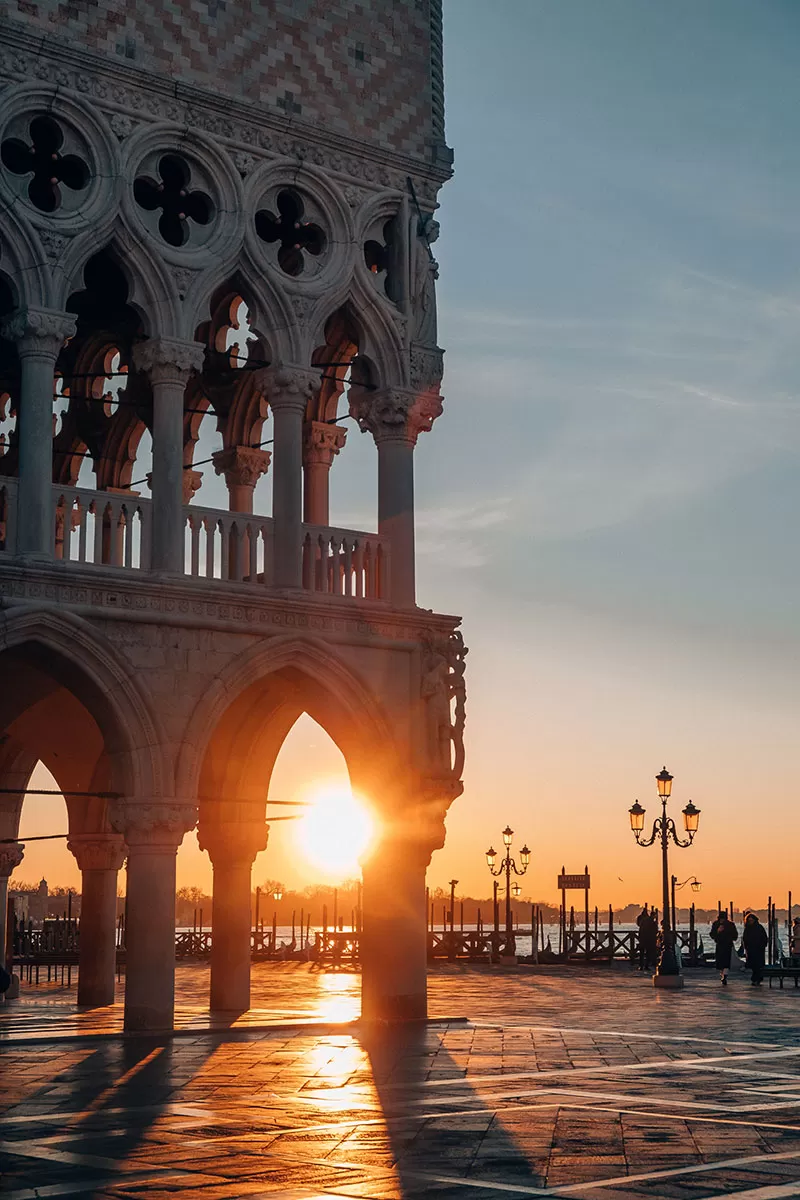
5. See the centuries-old mosaics inside St. Mark’s Cathedral
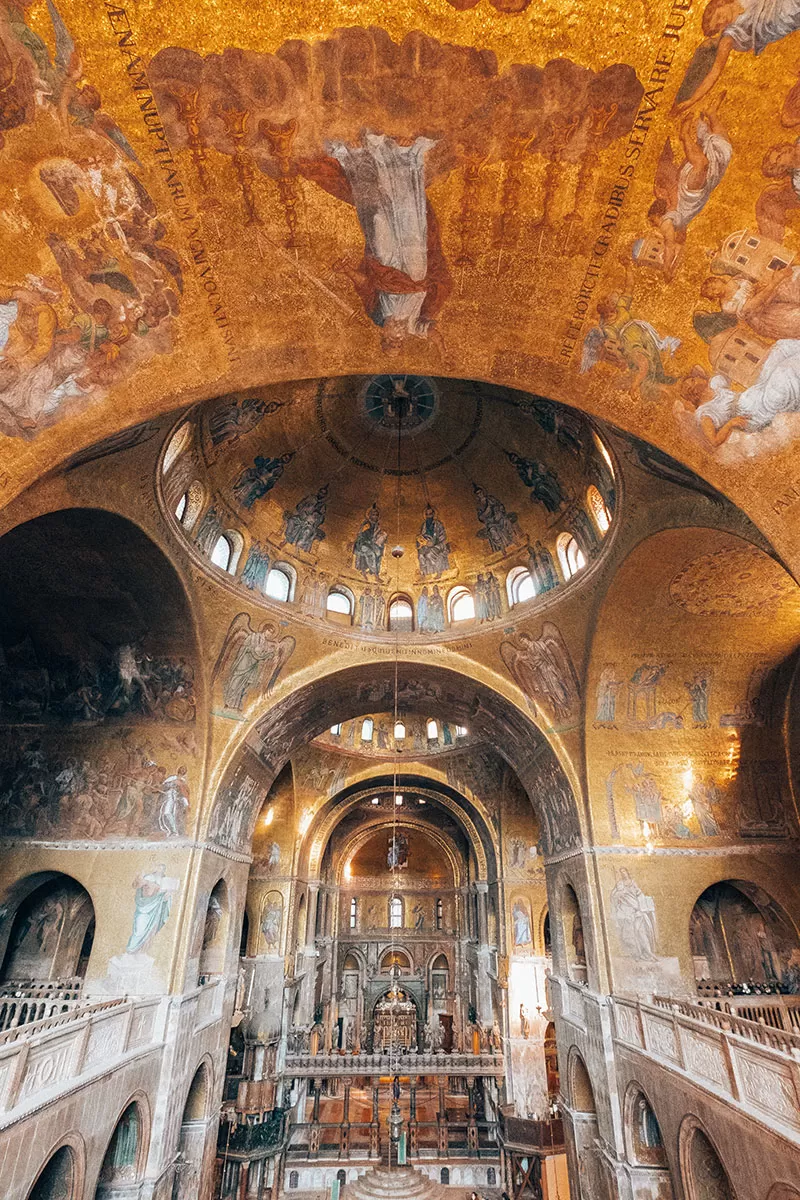 Included in your guided tour of the Doge’s Palace is St. Mark’s Cathedral (Italian: Basilica di San Marco). In AD 828, several crafty Venetian merchants allegedly smuggled St Mark’s corpse out of Egypt in a barrel of pork fat to avoid inspection by Muslim authorities. Venice then built a basilica around its stolen saint. In 932, the original building burnt down and was rebuilt with Venetian Byzantine architecture using a Greek cross layout, Byzantine domes, and walls clad in marble from Syria, Egypt and Palestine.
Included in your guided tour of the Doge’s Palace is St. Mark’s Cathedral (Italian: Basilica di San Marco). In AD 828, several crafty Venetian merchants allegedly smuggled St Mark’s corpse out of Egypt in a barrel of pork fat to avoid inspection by Muslim authorities. Venice then built a basilica around its stolen saint. In 932, the original building burnt down and was rebuilt with Venetian Byzantine architecture using a Greek cross layout, Byzantine domes, and walls clad in marble from Syria, Egypt and Palestine.
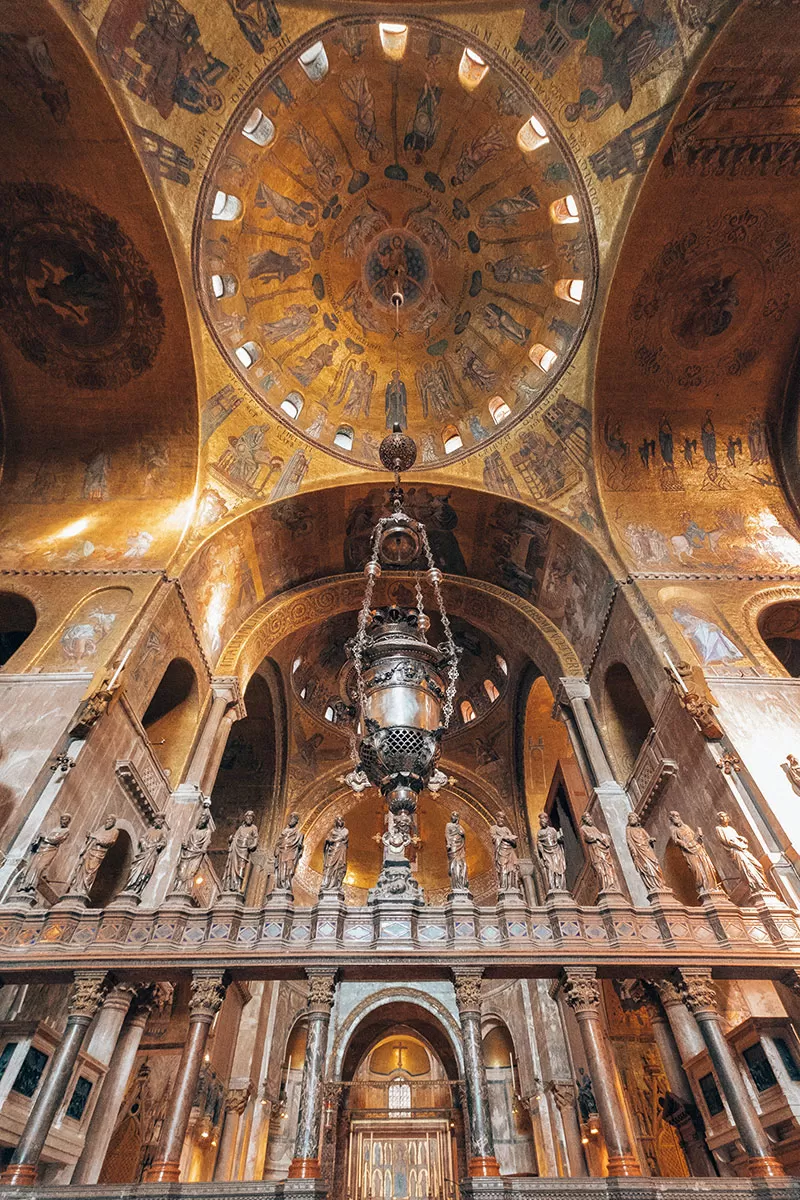 Incredibly, this church was the doge’s private chapel. It wasn’t until 1807 that it officially became Venice’s cathedral, replacing the less impressive Basilica di San Pietro in Castello.
Incredibly, this church was the doge’s private chapel. It wasn’t until 1807 that it officially became Venice’s cathedral, replacing the less impressive Basilica di San Pietro in Castello.
Located on the facade, is the basilica’s oldest mosaic, dating from 1270. Located in the lunette above the far-left portal, it depicts the stolen remains of St Mark’s body arriving at the basilica. This theme is replicated in three of the other lunettes, including the 1660 mosaics above the second portal from the right, showing turbaned officials recoiling from the hamper of pork fat containing the sainted corpse. Just inside the vestibule are the basilica’s oldest mosaics showing the Apostles with the Madonna.
Last but not least is access to the basilica terrace which gives stunning panoramic views over Venice. Book your private tour here.
6. Join a Murano Glass workshop with a Local Artisan
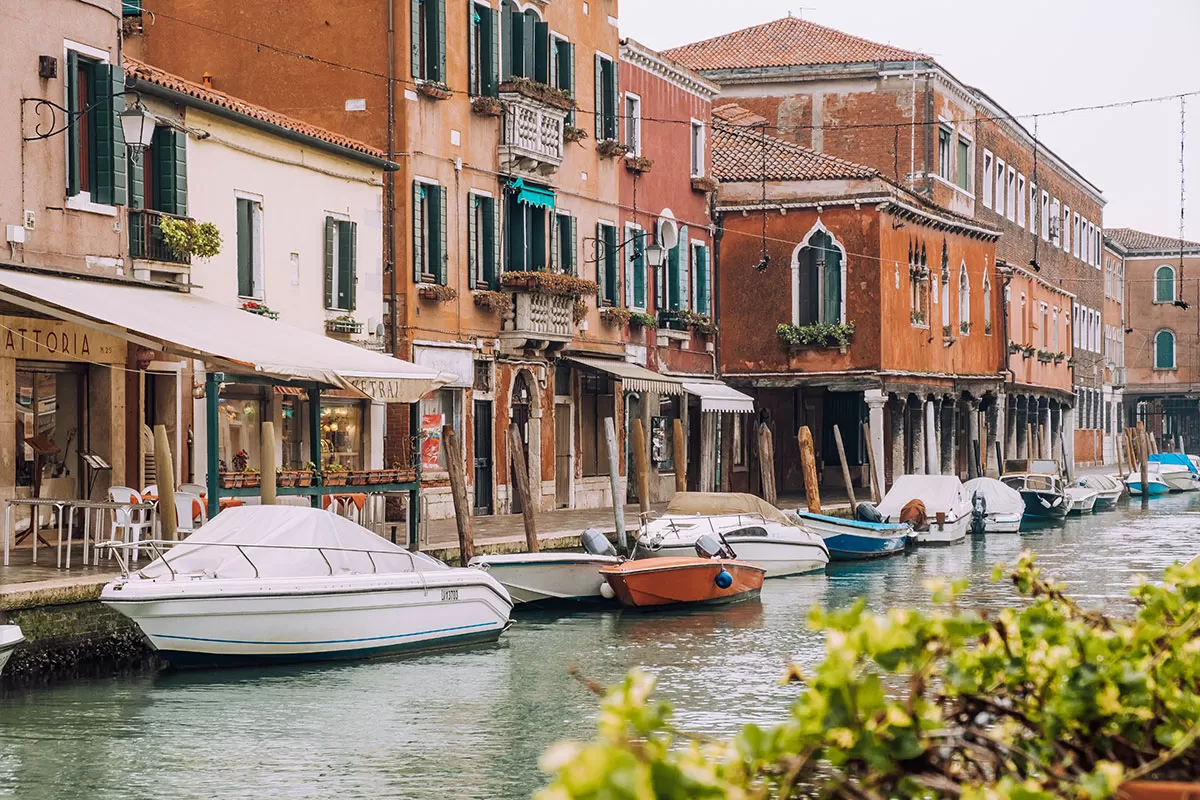
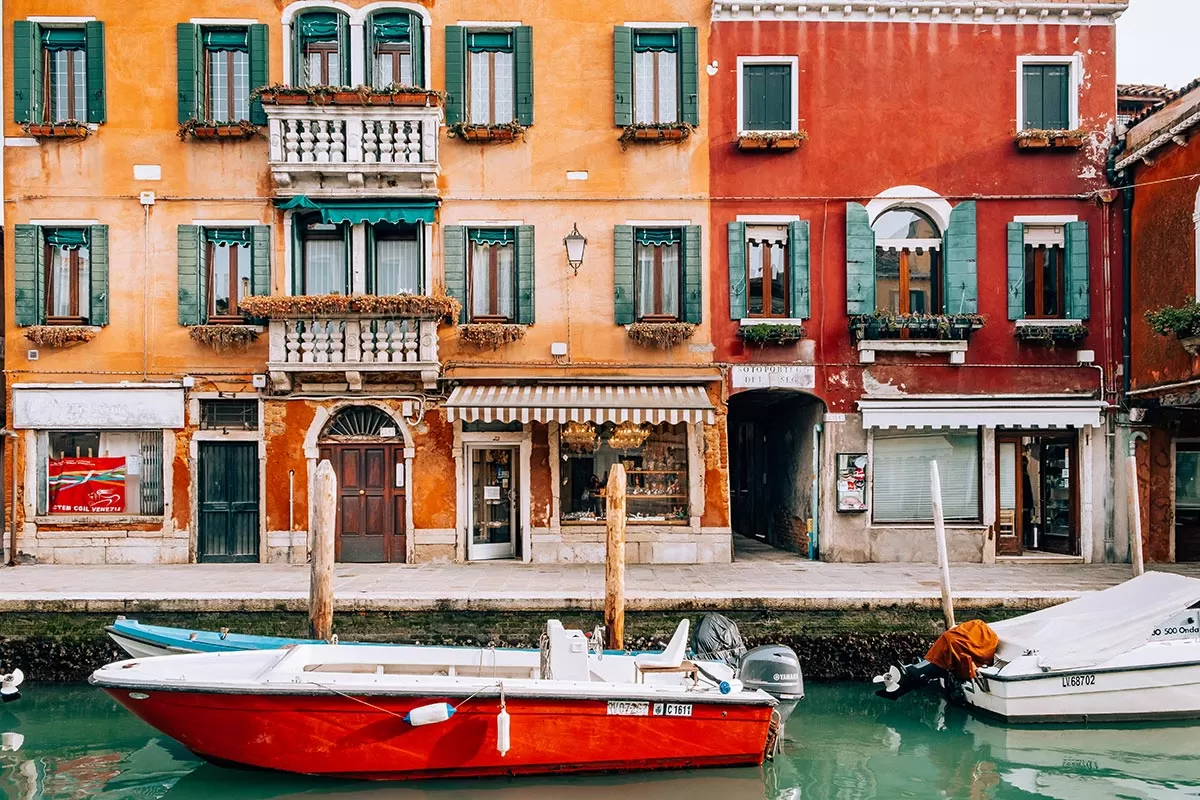 Murano glass is world-famous for its high quality, beautiful range of colours, and impressive craftsmanship. When the Venetian Republic feared fire and the destruction of the city’s mostly wooden buildings, it ordered glassmakers to move their furnaces to the island of Murano in 1291.
Murano glass is world-famous for its high quality, beautiful range of colours, and impressive craftsmanship. When the Venetian Republic feared fire and the destruction of the city’s mostly wooden buildings, it ordered glassmakers to move their furnaces to the island of Murano in 1291.
In the following century, Murano began exporting items such as glass beads and mirrors. Aventurine glass was invented on the island, and for a while Murano was the main producer of glass in Europe, eventually becoming known for its opulent chandeliers.
Glassmakers of Murano quickly became some of the island’s most prominent citizens. By the fourteenth century, glassmakers were allowed to wear swords, enjoyed immunity from prosecution by the Venetian state and married off their daughters into Venice’s most affluent families.
Even though glassmakers benefited from certain privileges, they were forbidden to leave the Republic. In spite of this, many of them took this risk and established glass furnaces in surrounding cities and farther afield — sometimes in England and the Netherlands.
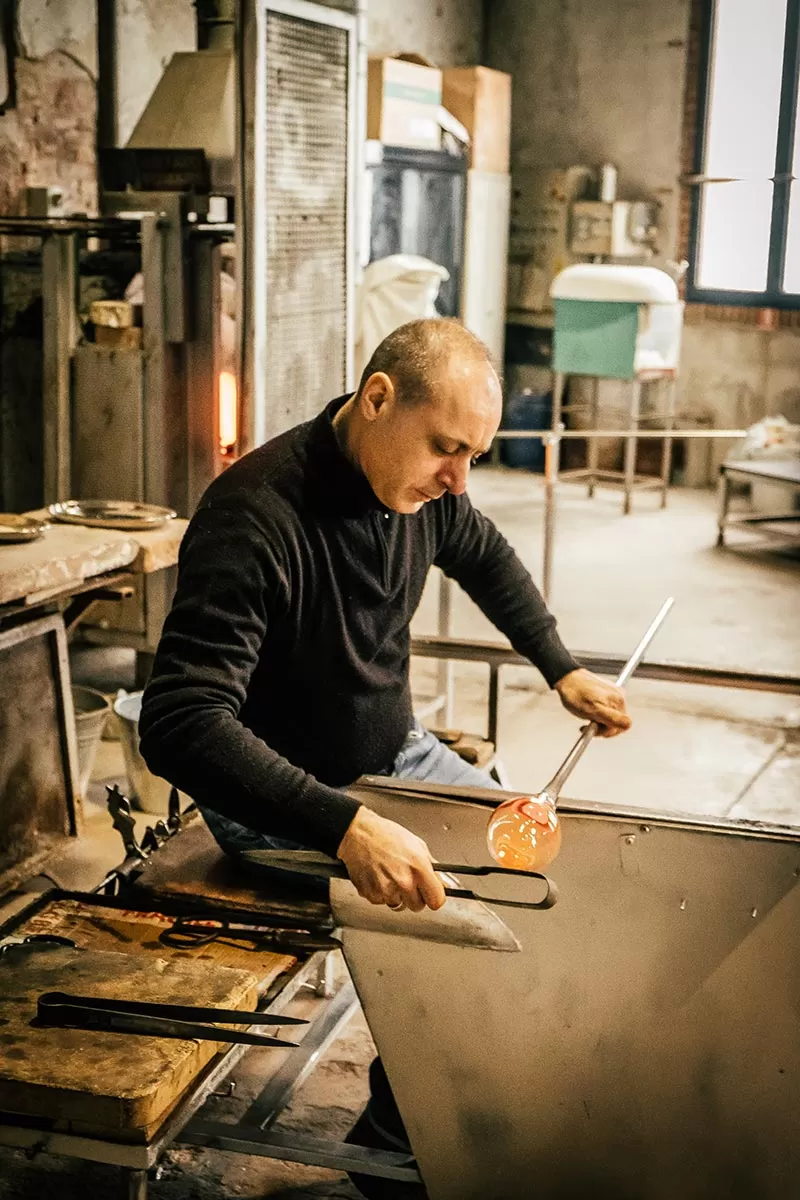
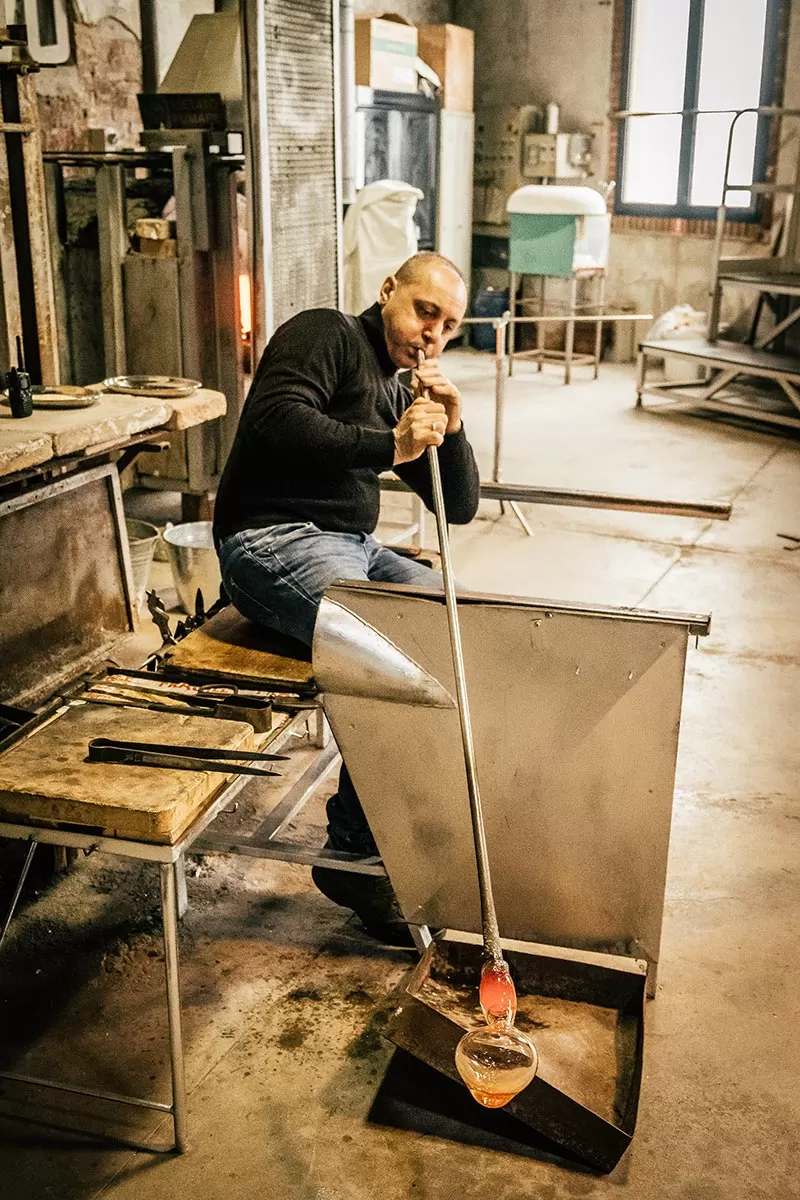
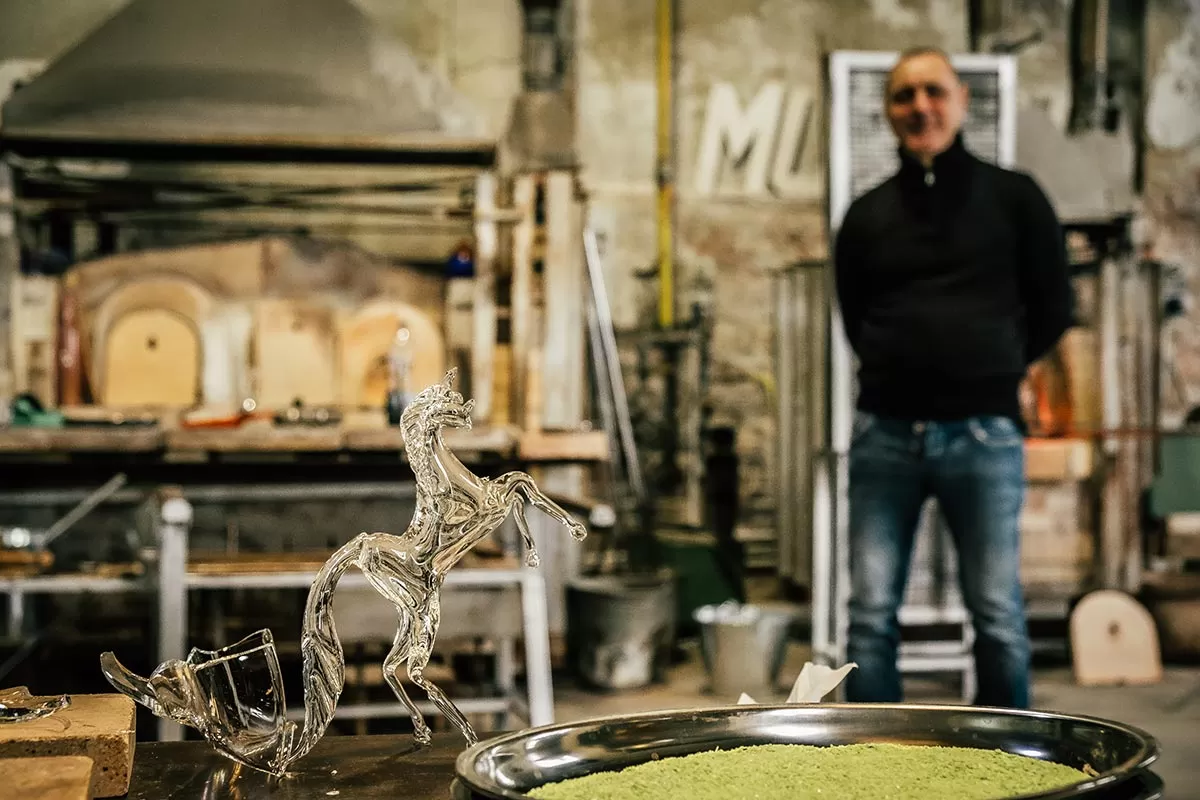 For centuries, Murano’s glassmakers held a monopoly on high-quality glassmaking. They developed or refined many technologies including optically clear glass, enamelled glass (smalto), glass with threads of gold (aventurine), multicoloured glass (millefiori), milk glass (lattimo), and imitation gemstones made of glass.
For centuries, Murano’s glassmakers held a monopoly on high-quality glassmaking. They developed or refined many technologies including optically clear glass, enamelled glass (smalto), glass with threads of gold (aventurine), multicoloured glass (millefiori), milk glass (lattimo), and imitation gemstones made of glass.
Today, craftsmen in Murano still adopt these centuries-old techniques. They craft everything from contemporary art glass and glass jewellery to Murano glass chandeliers and wine stoppers.
When you watch a demonstration of how glass is manipulated to form these elegant objects, the craftsmen make it look so easy. A better way to really appreciate what’s really involved is by getting hands-on experience, which is exactly what I did! I joined this workshop where I got one-to-one guidance in a private glass making session.
During this 90-minute workshop with one of the most renowned craftsmen of Venice, I learned the secrets of Murano glassmaking techniques. Whatsmore, I created a little memento that I can now take home and remember my experience by.
To learn more about the island’s glassmaking history, visit the Murano Glass Museum (Italian: Museo del Vetro).
7. See how Gondolas are made at Lo Squero di San Trovaso
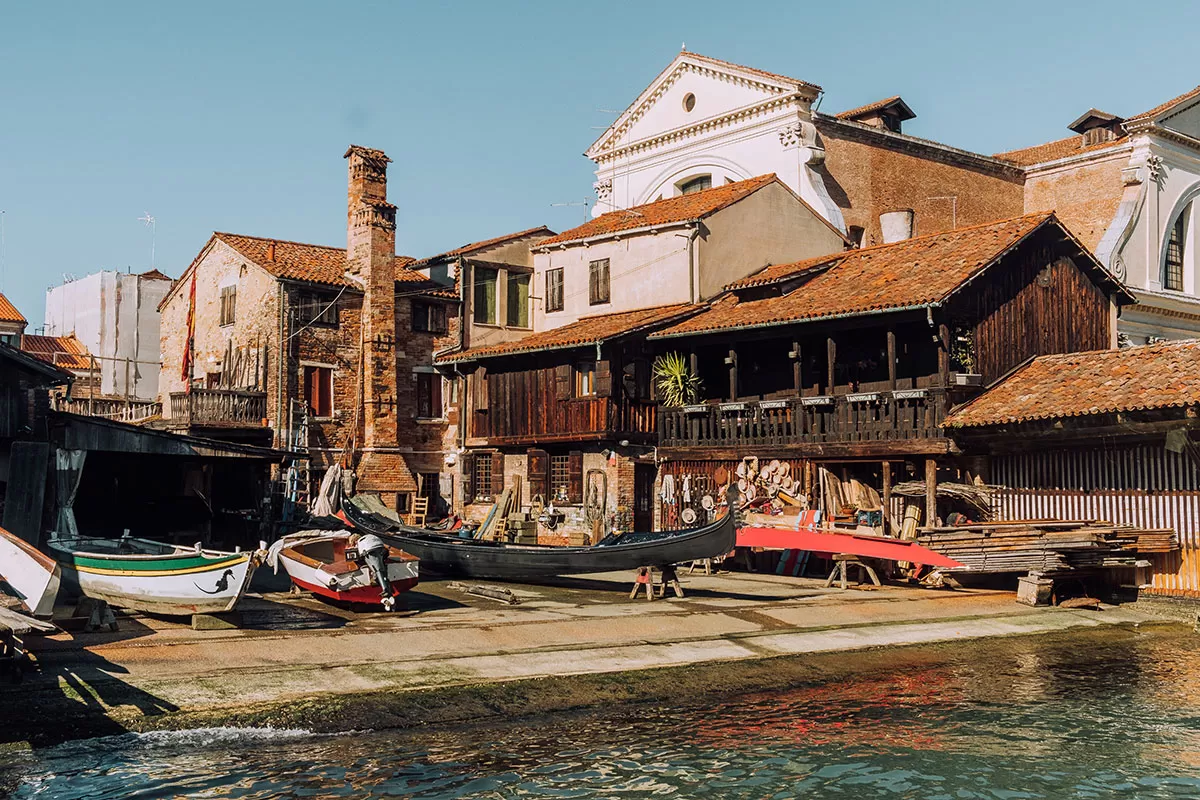 Venice wouldn’t be the same without its sleek iconic black vessels that glide along its canals. Thanks to a small group of artisans, traditional boatyards called squeri, keep this tradition alive.
Venice wouldn’t be the same without its sleek iconic black vessels that glide along its canals. Thanks to a small group of artisans, traditional boatyards called squeri, keep this tradition alive.
Lo Squero di San Trovaso is one of two remaining traditional boatyards in Venice that meticulously build these “simple” yet elegant vessels. Two of the main things that define a traditional squero from a generic boatyard is that there is a traditional mountain house made of wood and the ground slopes down directly into the water where the gondolas are released.
When this Squero opened in the 17th century, more than 10,000 gondolas were in circulation in Venice, which at the time, were the primary mode of transport. During its peak, there were around 60 boat builders who worked here.
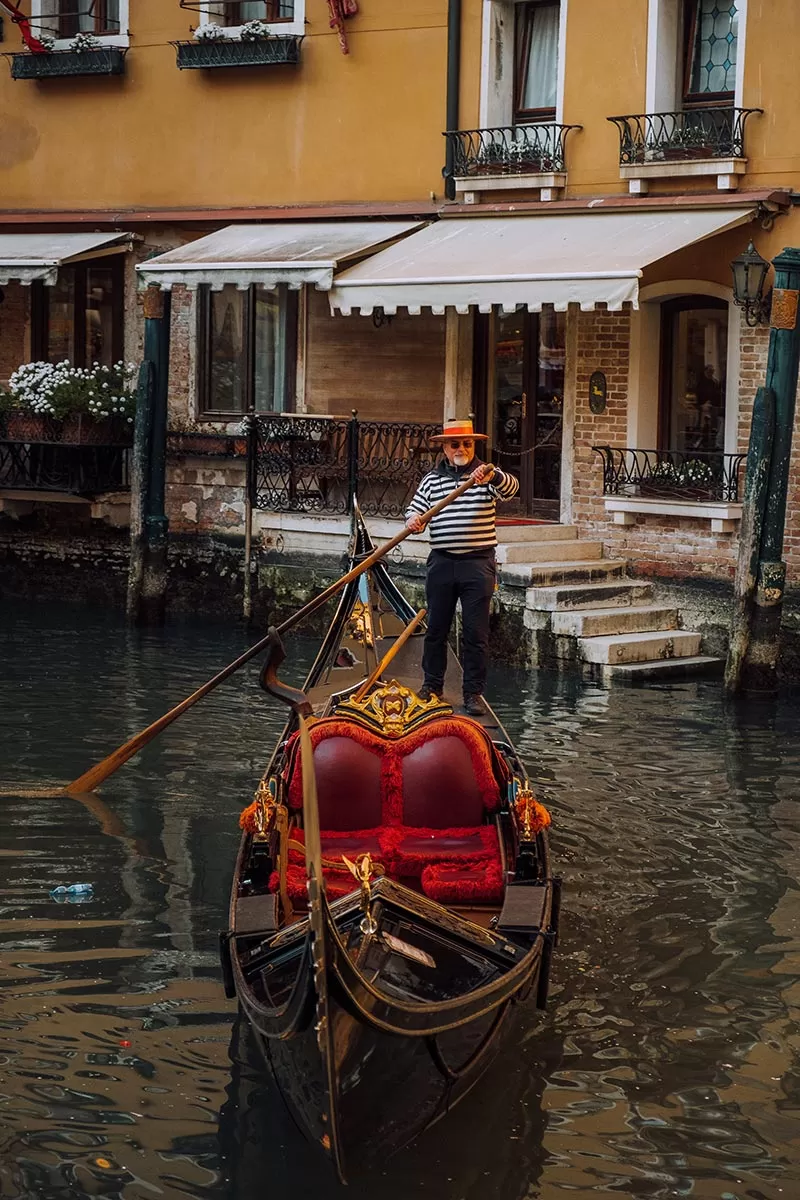 Today, there are only around 500 gondoliers and 250 substitute gondoliers that still navigate these waters, which are mostly hired by tourists wanting to take a romantic gondola ride around the city center. Although, you can buy your own gondola for personal, private use and do not need a license.
Today, there are only around 500 gondoliers and 250 substitute gondoliers that still navigate these waters, which are mostly hired by tourists wanting to take a romantic gondola ride around the city center. Although, you can buy your own gondola for personal, private use and do not need a license.
Lo Squero di San Trovaso makes one new boat built each year which costs upwards of €35,000, depending on its amenities. To make a gondola from scratch takes 3 full months.
There is no manual for making a gondola, every part of the process is made by heart and experience by the craftsman. Measuring 11 metres long and weighing around 500-600kg, each gondola is made up of 280 pieces, 7-8 types of wood, 7 coats of paint and lasts 50 years. Five times a year the bottom is cleaned to remove algae, once a year it receives a new coat of paint, and every 5 years the bottom is completely replaced.
Originally, Gondolas were covered by a roof and privately owned by the wealthy. By having a roof, no one could see who was inside and what previous items they passed and were transporting.
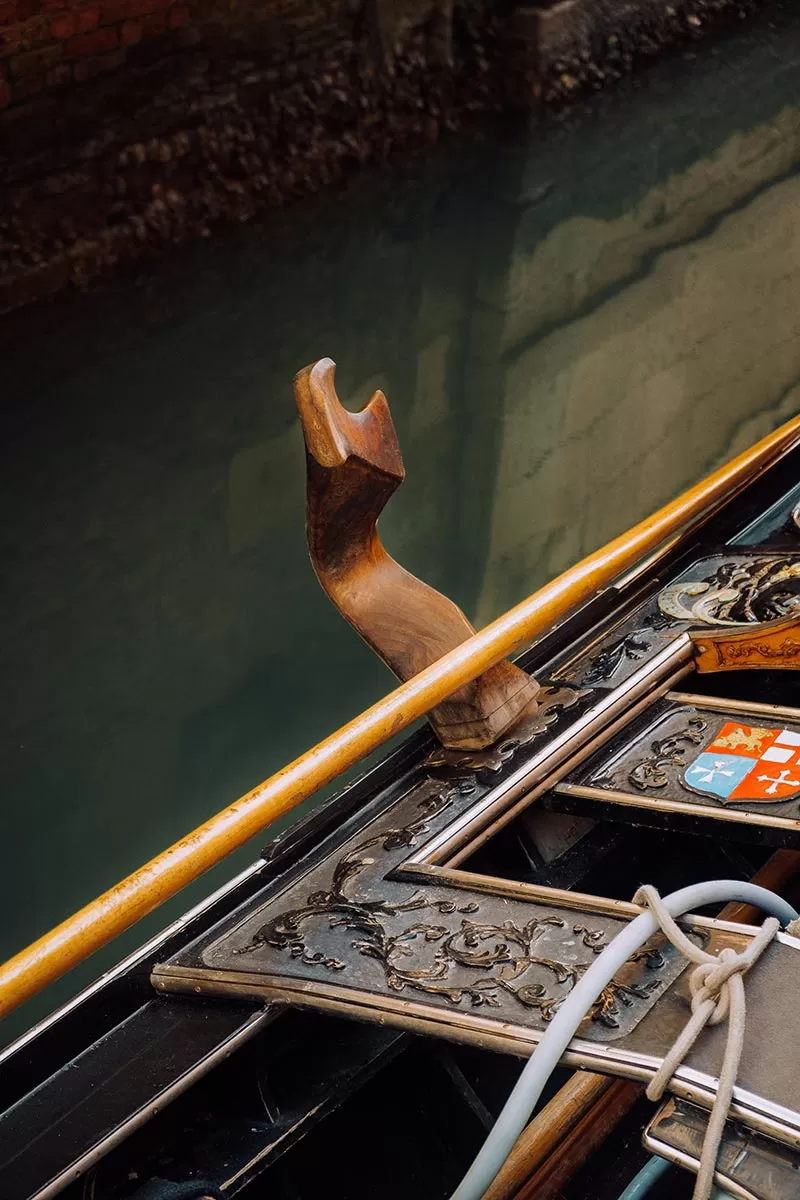
c
Made entirely by hand, a typical gondola is made up of nine different kinds of wood, several hundred parts, including a carved oarlock called la forcola and a weighted bow ornament known as a ferro della gondola that helps to counterbalance the weight of the gondolier who rows while standing on the boat’s stern. There’s no modern equipment on board a gondola, just the gondolier and his oar.
The forcola is quite a complicated object which has developed throughout the centuries for pure functionality. There are about 40 different types of forcola. Each forcola is a unique piece since it is specifically designed for its gondolier (rower of gondolas). The design is modified according to the gondolier’s height and rowing needs. There is even a rule that specifies that the external gondolier’s arm must not go over the chin.
Ferro della gondola
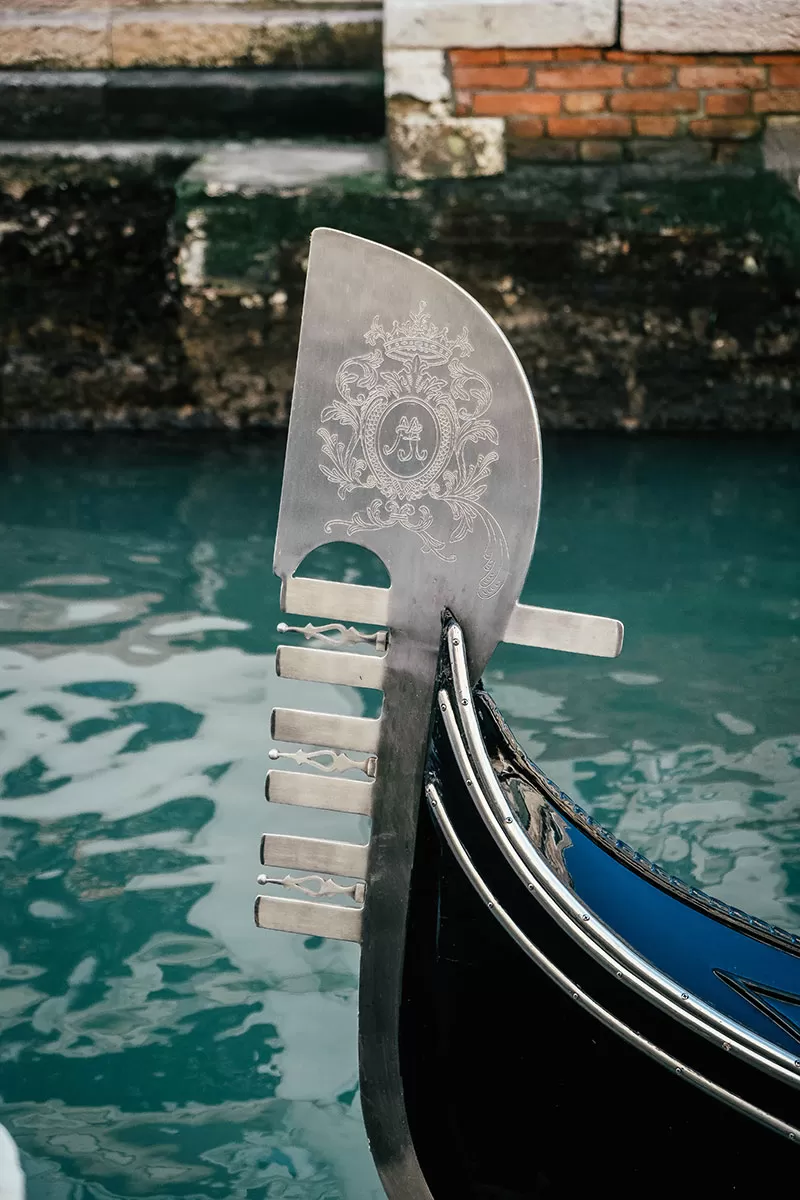 They say that the ornament on a gondola’s bow, called ferro della gondola (gondola iron), is a compact representation of the city of Venice itself. Its main purpose is to assist in collisions and create a counterbalance for the gondoliere so its weight will vary from gondola to gondola. However, there is a lovely story behind its design.
They say that the ornament on a gondola’s bow, called ferro della gondola (gondola iron), is a compact representation of the city of Venice itself. Its main purpose is to assist in collisions and create a counterbalance for the gondoliere so its weight will vary from gondola to gondola. However, there is a lovely story behind its design.
The six sestieri are symbolically represented by the six forward-facing prongs (San Marco, Castello, Cannaregio, San Polo, Santa Croce, Dorsoduro) and the island of Giudecca points backwards as this is a more recent island that wasn’t part of the Venetian Republic.
The ‘S’ shape represents the curves of the Grand Canal, and the small arch above the topmost prong represents the Rialto Bridge (Italian: Ponte di Rialto).
Then reigning over the 6 sestieri is the broadly curved top which represents the Doge’s Cap, the headdress that was only worn by the doge of Venice.
If you want to see how a Gondola is made, you can visit lo Squero di San Trovaso for a guided tour. It’s totally free, but booking is essential.
8. Learn to row a Venetian boat on the Grand Canal
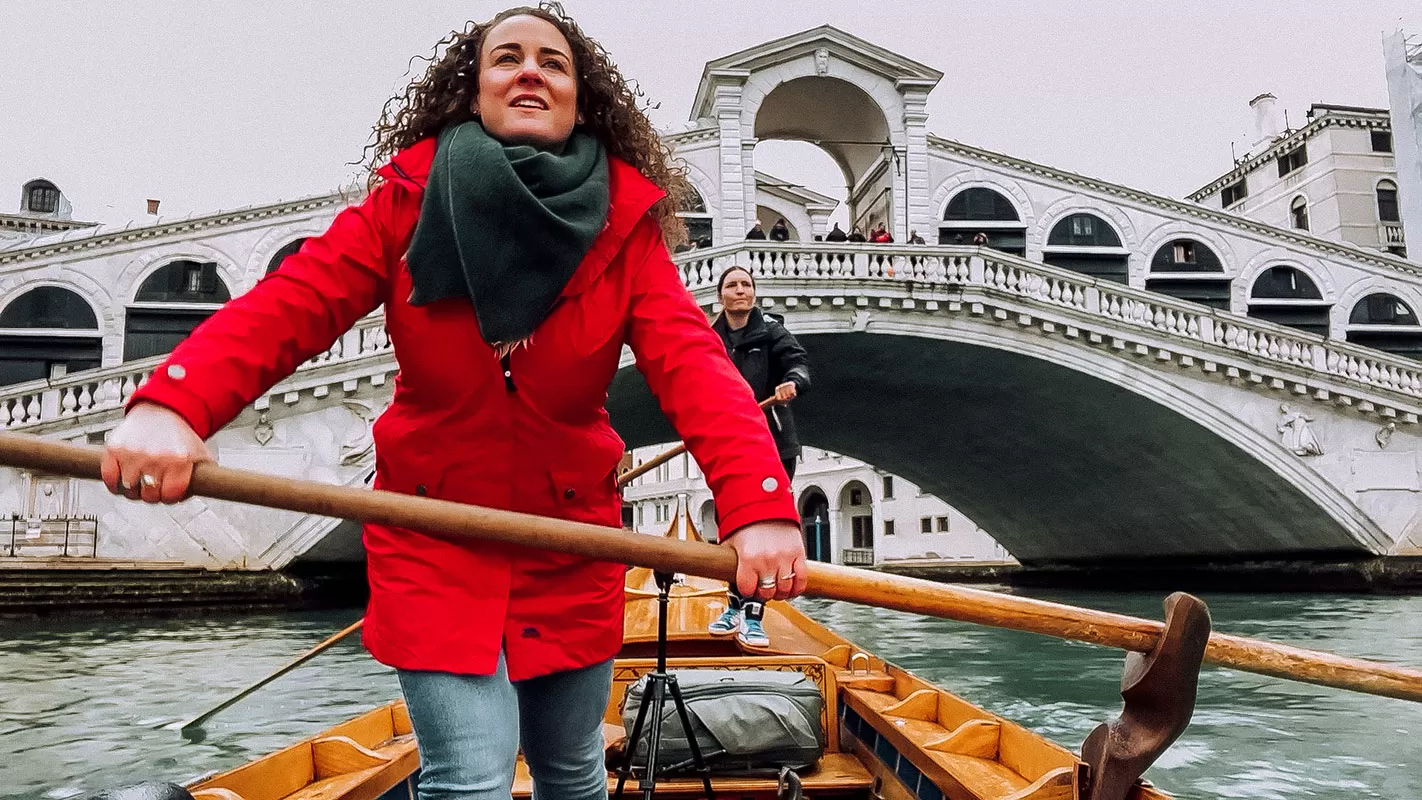 Once you see how gondolas are made, why not try your hand at Voga Veneta (Venetian rowing), that is, rowing standing up, and facing forward – a style that is native to Venice and made iconic by its gondoliers. This iconic technique means that the poppiere (rower) can see where they are going to avoid collisions and be able to navigate the narrow canals.
Once you see how gondolas are made, why not try your hand at Voga Veneta (Venetian rowing), that is, rowing standing up, and facing forward – a style that is native to Venice and made iconic by its gondoliers. This iconic technique means that the poppiere (rower) can see where they are going to avoid collisions and be able to navigate the narrow canals.
This kind of rowing is made possible thanks to la forcola, an exquisitely carved type of oarlock made from either walnut or cherry wood that has an open cradle that supports the oar. This open mouth is unique as it allows for quick movements and complex maneuvering to be able to navigate the narrow canals.
Row Venice is a non-profit organization of passionate women and expert vogatrici (female venetian rowers) who are dedicated to the preservation of the traditional Venetian ‘cultura acquea’ (aqueous culture).
There are a few different experiences you can book, I booked myself in for a rowing lesson along Canalasso, the ancient name for the Grand Canal! Book your lesson here.
9. Rooftop view over the Grand Canal at Fondaco de Tedeschi
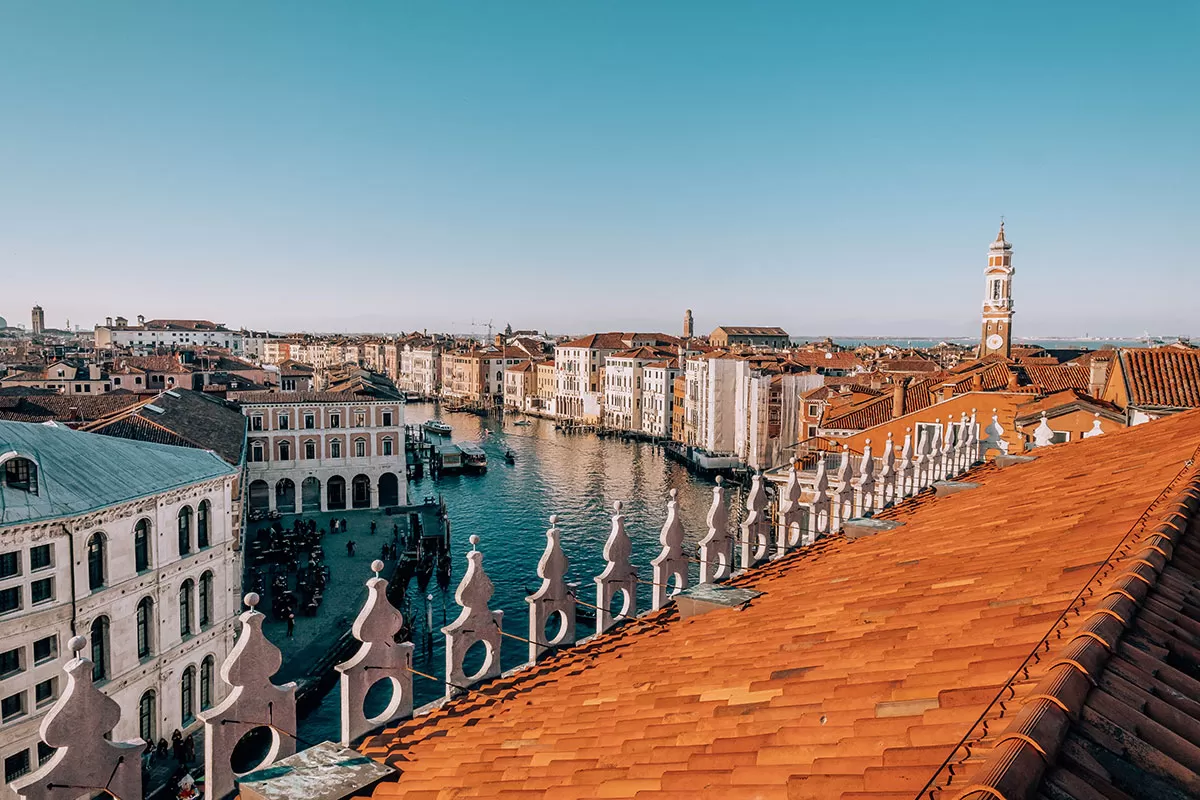
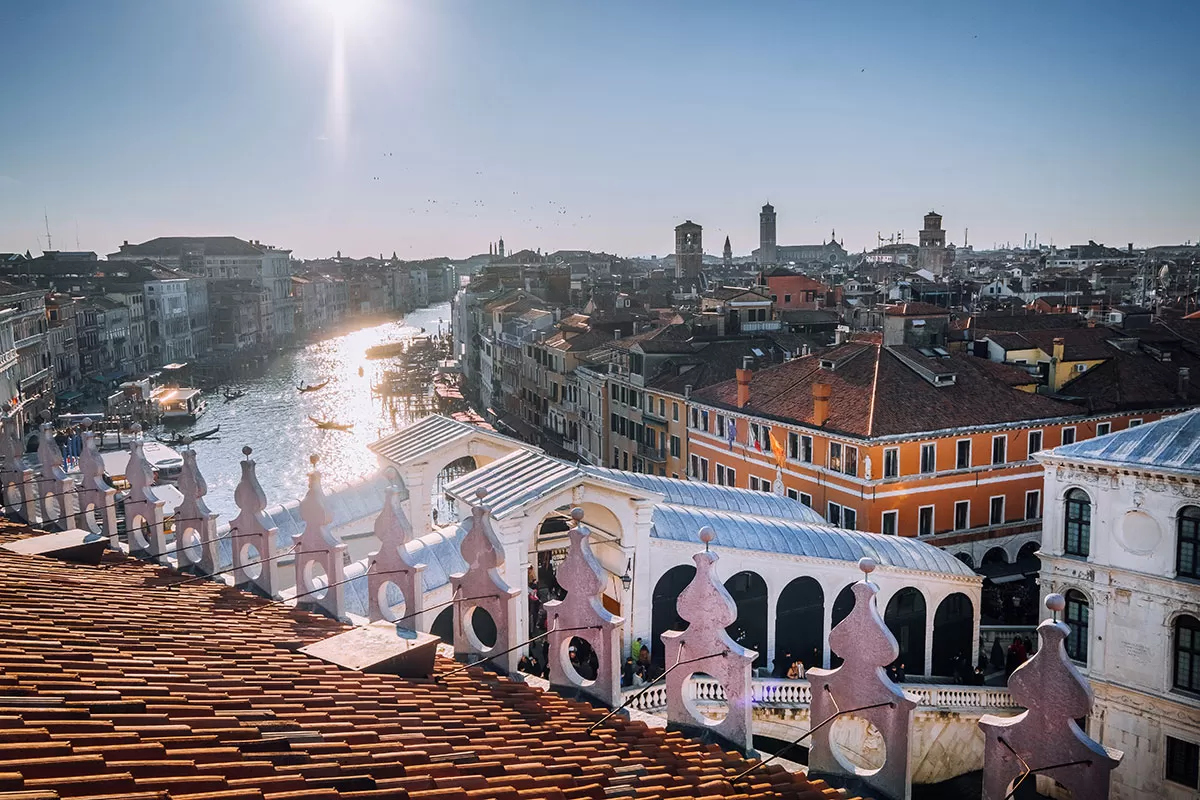 For a unique view of Venice’s main thoroughfare, head up to the rooftop terrace at Fondaco dei Tedeschi. This historic building in Venice is situated on the Grand Canal a few steps from the Rialto Bridge (Italian: Ponte di Rialto). From this large viewing platform, you get a stunning view of the iconic bridge below and can follow the curves of the Grand Canal.
For a unique view of Venice’s main thoroughfare, head up to the rooftop terrace at Fondaco dei Tedeschi. This historic building in Venice is situated on the Grand Canal a few steps from the Rialto Bridge (Italian: Ponte di Rialto). From this large viewing platform, you get a stunning view of the iconic bridge below and can follow the curves of the Grand Canal.
The building was once the headquarters and restricted living quarters of the city’s German merchants. The Italian word fondaco comes from the Arabic word funduq (فُنْدُق), meaning “storehouse” or “warehouse” and “Tedeschi” means “Germans”.
Today, this building houses a high-end department store selling luxury goods. Visiting the terrace is free but booking is essential and is open daily from 10:30 AM to 6:30 PM. Book your visit here.
10. Have a Spritz where it was invented at Osteria Antico Calice
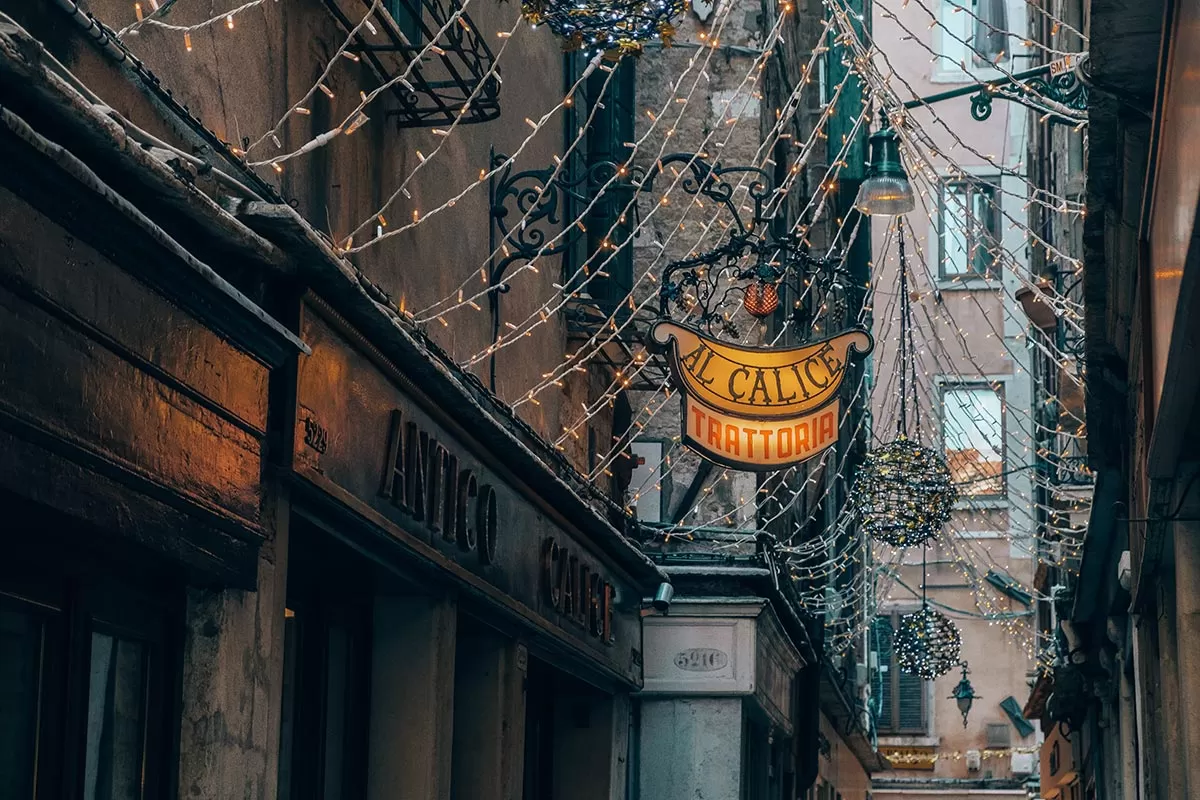 The same city that invented quarantine and the gondola, also gives us the famous Italian drink, the spritz. Many people in Venice and other places take credit for the invention of the Spritz, but the most accredited hypothesis is that this drink was born in the Osteria Antico Calice and it first consisted of half a glass of wine, drunk in a calice (goblet) standing at the bar.
The same city that invented quarantine and the gondola, also gives us the famous Italian drink, the spritz. Many people in Venice and other places take credit for the invention of the Spritz, but the most accredited hypothesis is that this drink was born in the Osteria Antico Calice and it first consisted of half a glass of wine, drunk in a calice (goblet) standing at the bar.
This was called ‘ombra’, which means ‘shadow’ or ‘shade’ in Italian but in Venetian was a slang term used to say ‘glass of wine’.
As a matter of fact, in the 1700s, wine merchants in Venice used to set up shop in the shadow of St. Mark’s bell tower moving their wares around during the day to keep out of the sun. This is how the colloquialism ‘prendere un’ombra‘ literally meaning ‘grab some shade‘ became ‘grab some wine‘.
Later on, during Austrian domination, the ombra was diluted with soda. The current name for Spritz comes from the German verb ‘spritzen‘, which means ‘to spray’. Over the years, several new variants were added: Aperol, Campari, and Select, creating the modern drink we know today. Still today in Venice there are many different ways in which Spritz is made, according to personal taste and inspiration.
11. Make your own Venetian Mask
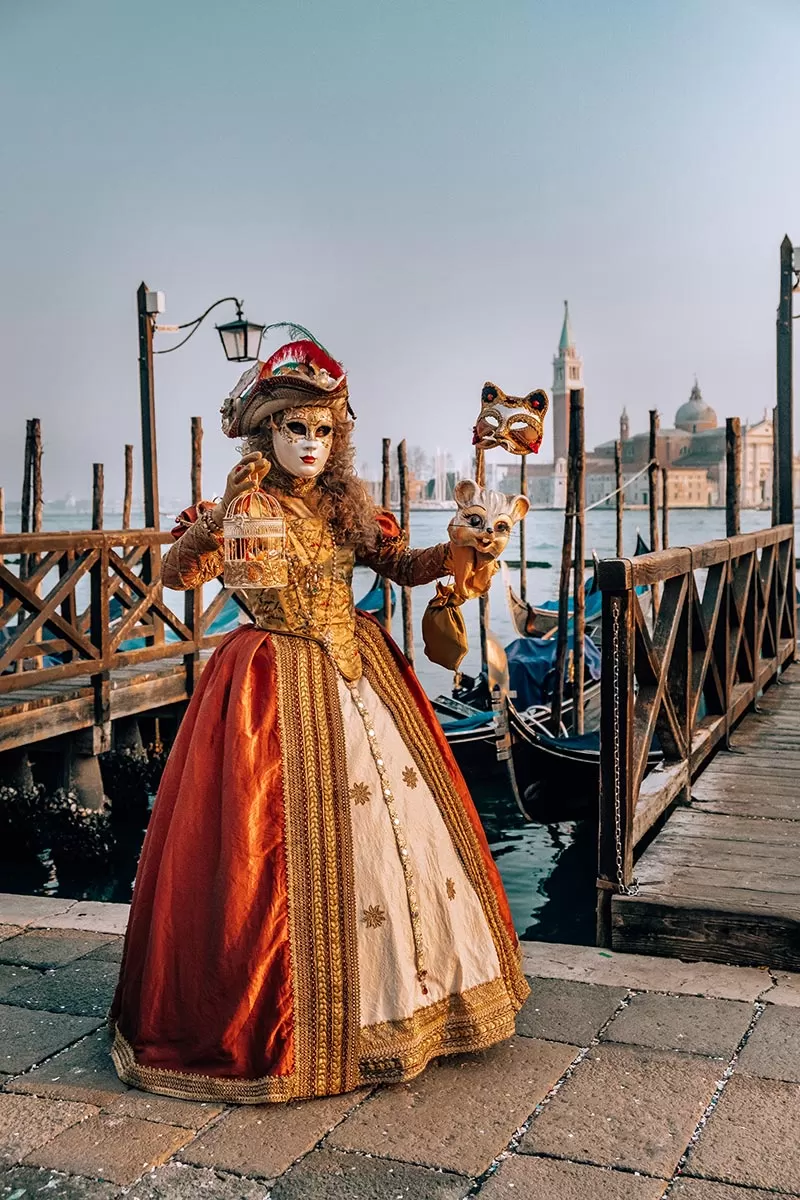 No matter what time of year you visit Venice, you’ll see countless Venetian masks displayed in shop windows. These were and are still primarily worn during one of Italy’s biggest events – Carnival.
No matter what time of year you visit Venice, you’ll see countless Venetian masks displayed in shop windows. These were and are still primarily worn during one of Italy’s biggest events – Carnival.
The term Carnival derives from the Latin carnem levare, literally “to eliminate meat” or carne vale, “farewell to meat”. Both refer to the giving up of meat and all bodily pleasures. This is celebrated with a great banquet on Shrove Tuesday, the day before Lent when a period of abstinence and fasting begins.
During Carnival, the wearing of masks and costumes guaranteed total anonymity. This created a sort of cancellation of social divisions and a way to hide differences between noble people and peasants.
Incidentally, this is also how we get the verb to incarnate (Italian: incarnare), literally to embody the spirit of another. When we escape our reality and slip on a mask and costume, we are actually incarnating another person.
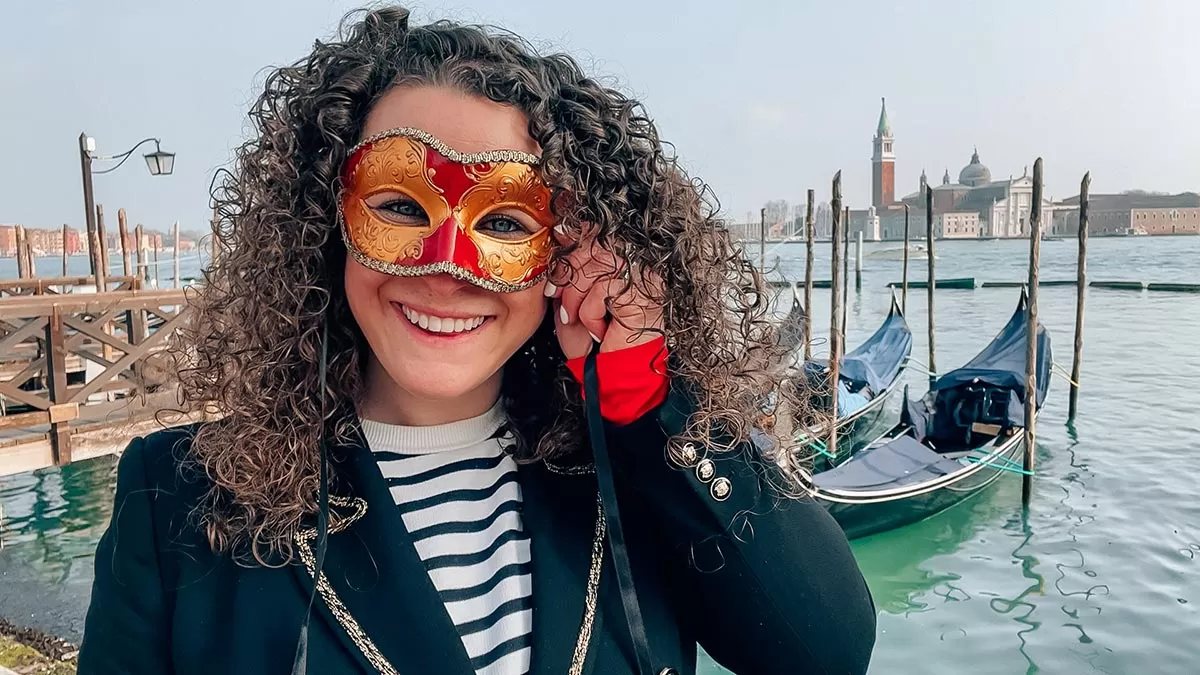
Me with my Venetian mask I made
To really appreciate this art form and the patience and mastery required to make the perfect mask, I joined this mask-making workshop with a master artisan to learn about the history of this ancient tradition.
You can choose from a production class or a decoration class, or do both. In the production workshop, learn how to make your own paper-mâché mask from scratch, and in the decoration class, you learn how to paint and decorate your mask. No matter which option you choose, you get to take home your creation. Join the same workshop I did here.
To learn more about Carnevale, make sure you watch my video which includes everything you need to know about the history of carnival, traditional events and the story behind its traditional masks.
12. Go to a Carnival masquerade ball
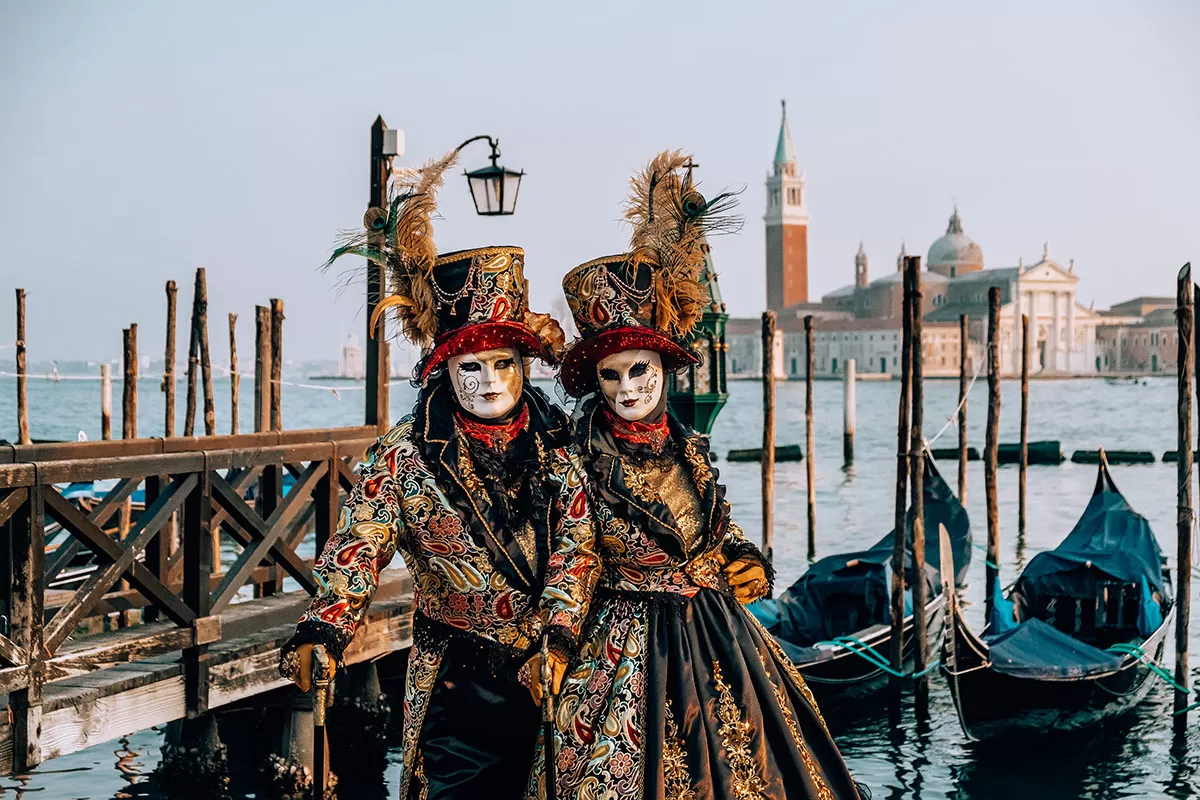 Buongiorno, signora maschera!”. (Hello, Mis Mask) This is how people addressed each other during the golden era of carnival, and still today, the reason being is that you can’t recognise the other person nor their gender, so you everyone Mrs mask!
Buongiorno, signora maschera!”. (Hello, Mis Mask) This is how people addressed each other during the golden era of carnival, and still today, the reason being is that you can’t recognise the other person nor their gender, so you everyone Mrs mask!
With your own Venetian mask you made during the workshop or a more elaborate one crafted by a local artisan, there’s no better way to experience Venice and get into the carnival spirit than by attending a masquerade ball!
Carnaval is hosted each year in February leading up to Lent. There is a Venetian proverb that goes: “Chi no le fa de Carneval, le fa de Quaresema” meaning, Those who do not do crazy things at Carnival, do them during Lent.
To celebrate Carnival in style you can attend masquerade balls like Mascheranda, which takes place in a stunning 18th-century palace on the grand canal, hosted by none other than Casanova.
For more details or to reserve your ticket including costume hire, click here.
13. Stay at Ca’ Bonfadini Historic Experience
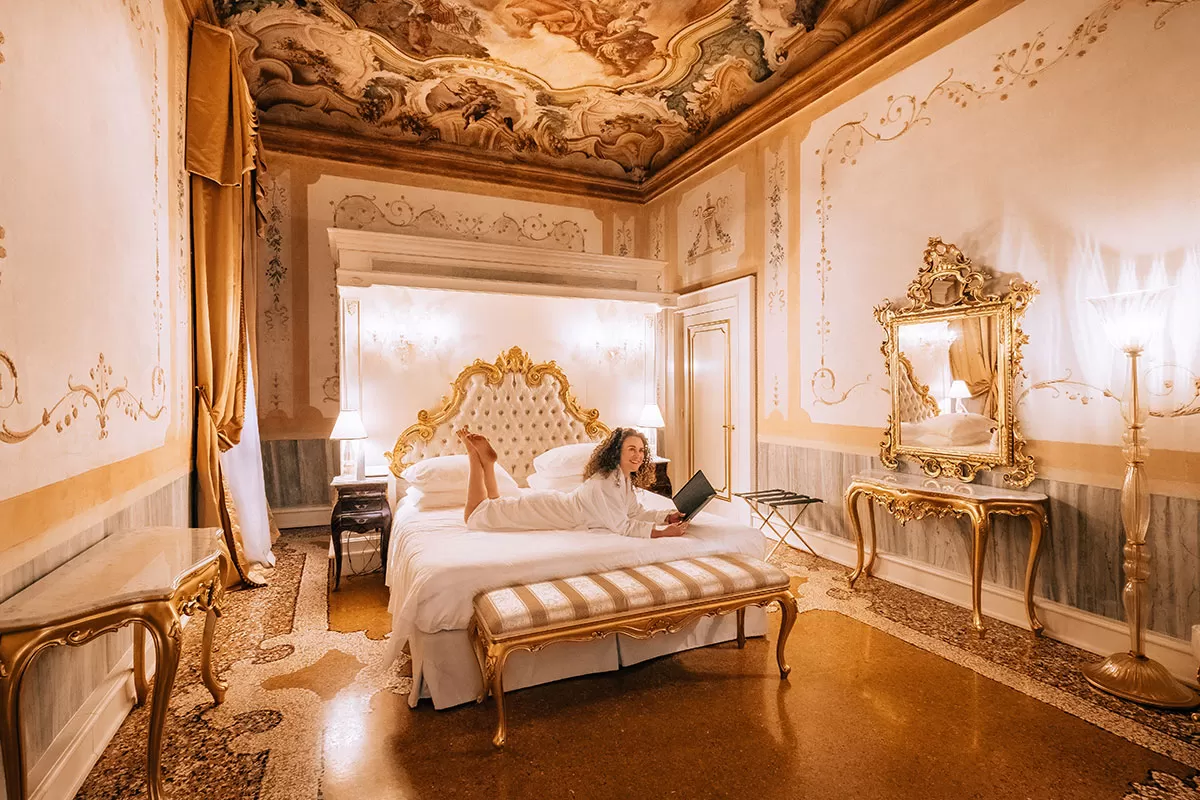 Imagine sleeping in a lavish palace with frescoed walls and ceilings, where every room tells a unique and special story and every ornament and piece of furniture is designed by a local artisan. Well, that’s exactly what staying at Ca’ Bonfadini Historic Experience feels like. This isn’t just a 5-star hotel, this is a museum that invites you to explore every corner of every room.
Imagine sleeping in a lavish palace with frescoed walls and ceilings, where every room tells a unique and special story and every ornament and piece of furniture is designed by a local artisan. Well, that’s exactly what staying at Ca’ Bonfadini Historic Experience feels like. This isn’t just a 5-star hotel, this is a museum that invites you to explore every corner of every room.
Set over 3 floors, the building dates back to 1661 and was owned by the noble Bonfadini family. Later, when the Serenissima aka the Venetian Republic fell in 1797, the Bonfadini family left and moved to the mainland. It was then that the palace was subdivided and part of it was occupied by the Vivante family. It wasn’t until 1815 that they then bought the entire building and developed and enriched it with stunning frescoes that you still see today.
Each room is unique with its own story to tell. For example, I stayed in the Camera degli Sposi, which translates to the Newlyweds room. This was where Pietro Bonfadini stayed with his newly wedded wife Orsetta Giovannelli.
Ca’ Bonfadini Historic Experience books out in advance, to check availability you can book your stay direct and use promo code INTREPID (case sensitive) for a special get 10% discount OFF your stay in 2022. Alternatively, book your stay here.
Find out more about my stay at Ca’ Bonfadini Historic Experience in my full review here.
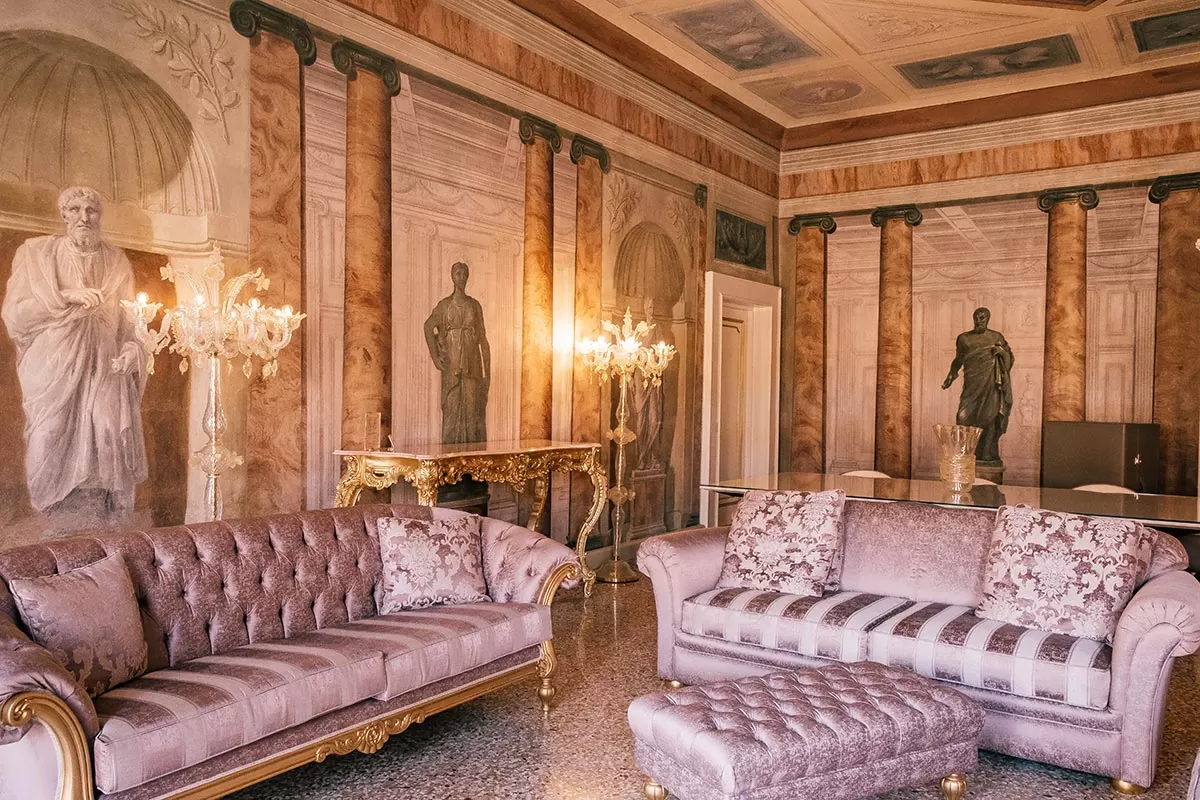

14. See the impressive Tribuna at Palazzo Grimani
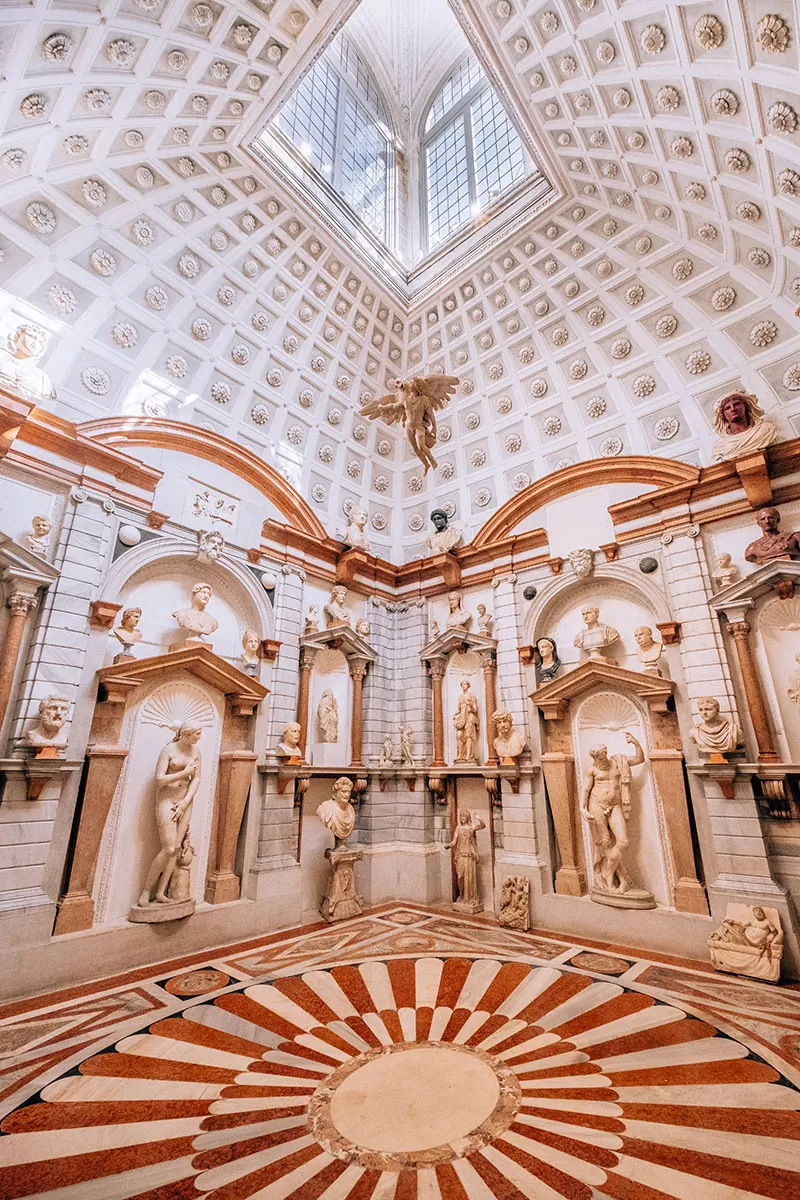 Palazzo Grimani is a state museum that houses one of the most enchanting rooms in Venice. The original medieval building was built where the canals San Severo and Santa Maria Formosa meet and was purchased by Antonio Grimani who became a doge in 1521. In the early 1600s, the palazzo was passed on to Antonio’s two grandsons, Vettore Grimani and Giovanni Grimani.
Palazzo Grimani is a state museum that houses one of the most enchanting rooms in Venice. The original medieval building was built where the canals San Severo and Santa Maria Formosa meet and was purchased by Antonio Grimani who became a doge in 1521. In the early 1600s, the palazzo was passed on to Antonio’s two grandsons, Vettore Grimani and Giovanni Grimani.
The two brothers wanted to modernise the building and decorate it with frescoes and stucco. Eventually, they added a monumental staircase and a collection of antiques, including sculptures, marbles, vases, bronzes and gems, in the rooms of the palace.
Between 1563 and 1565 the monumental staircase was decorated by a young Federico Zuccari, who had trained in Rome. He added allegorical frescoes, referring to the virtues of his client Giovanni, grotesques and stucco reliefs with mythological creatures. The final result looks very similar to the Scala d’Oro in the Doge’s Palace.
While there are several rooms of interest, the Tribuna, also known as the Antiquarium is home to over 100 ancient sculptures, making it the most beautiful of them all. This incredible space is illuminated only from above and was inspired by the Pantheon in Rome. Hanging in the centre of the room is a Roman replica of a late Hellenistic model of the Abduction of Ganymede.
15. Scala Contarini del Bovolo and Sala del Tintoretto
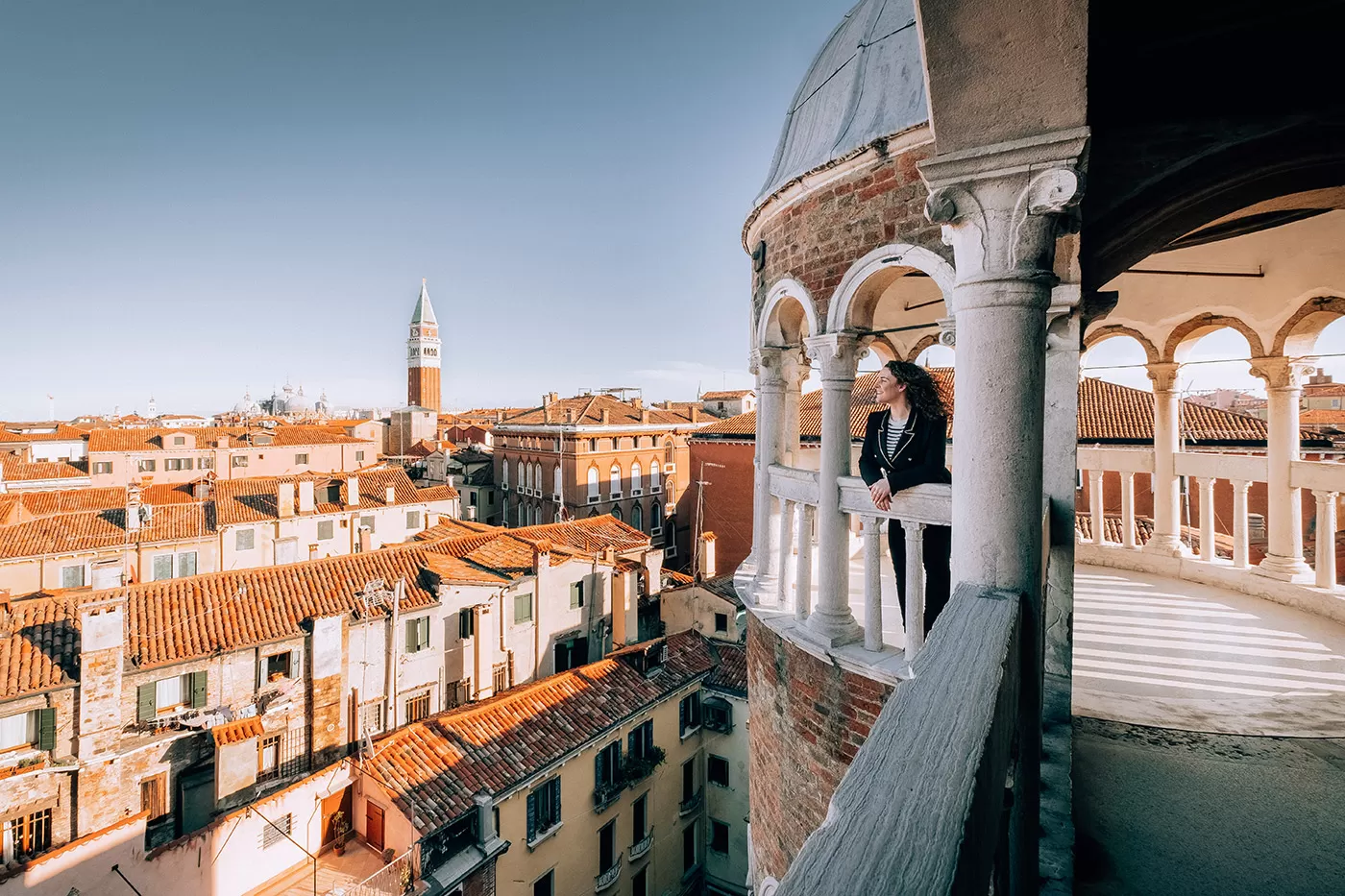 Located in a small, less-travelled calle (street) is Palazzo Contarini del Bovolo. It may not be located on the Grand Canal but its position is still important being equal distance from both the Rialto – the city’s commercial hub, and Piazza San Marco – the political centre of the Republic.
Located in a small, less-travelled calle (street) is Palazzo Contarini del Bovolo. It may not be located on the Grand Canal but its position is still important being equal distance from both the Rialto – the city’s commercial hub, and Piazza San Marco – the political centre of the Republic.
In the late 15th century, important renovations updated the complex thanks to its new owner Pietro Contarini who bought the palace in 1489. The Contarini family owned the building during the eighteenth century. At the beginning of the nineteenth century, the property was passed to Domenico Emery of Toulon, and it was at that stage that Arnaux Marseille, known as “the Maltese”, converted Palazzo Contarini into a lodging house.
This palazzo is best known for its elegant 26-meter high cylindrical tower and spiral staircase that climbs the external wall, this is known as the Scala Contarini del Bovolo. In the Venetian language, “bovolo” means snail.
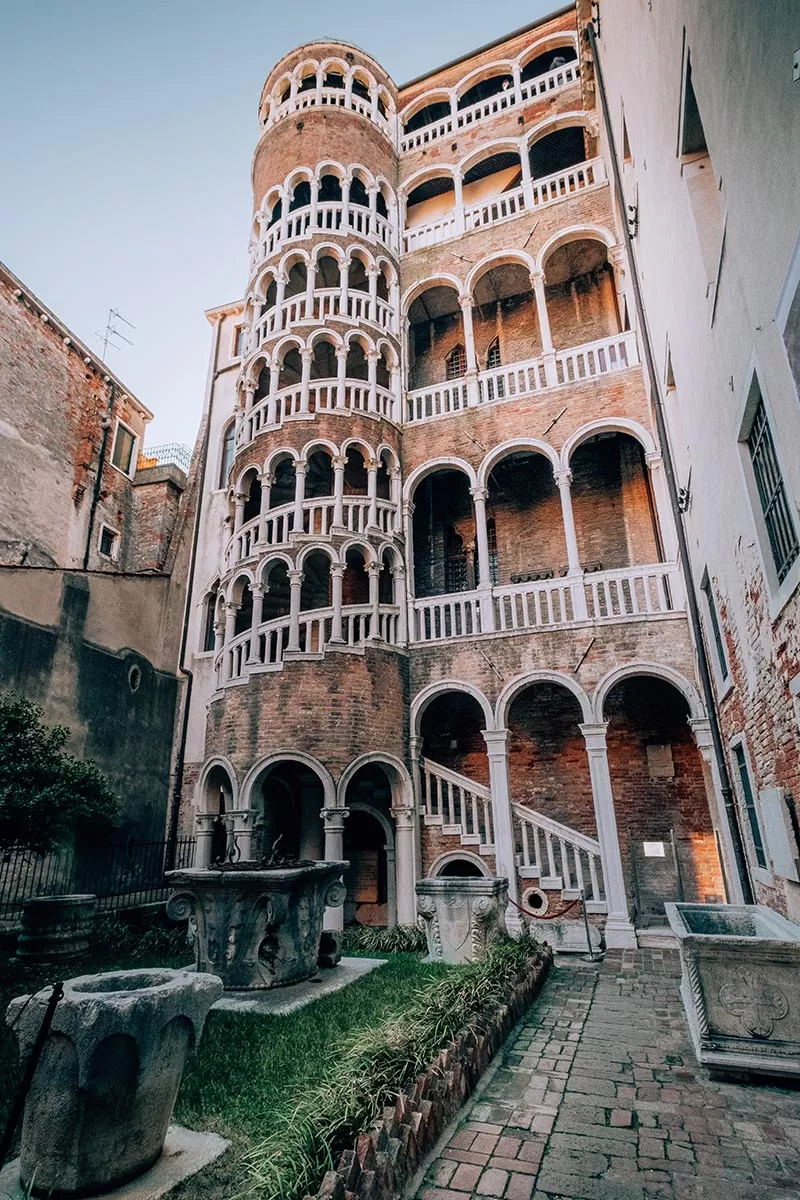 The staircase leads to an arcade where you’ll see an impressive view of the Venetian skyline including St Marks’ bell tower and on a clear day, the Dolomites.
The staircase leads to an arcade where you’ll see an impressive view of the Venetian skyline including St Marks’ bell tower and on a clear day, the Dolomites.
During the time it was a lodging house, one of the guests, German astronomer Wilhelm Tempel, discovered comet C/1859 and the Merope Nebula of the Pleiades from the top of this tower.
To visit Scala Contarini del Bovolo, booking is essential as it includes a timed entry.
16. See Venice’s orignal pavement at Madonna dell’Orto
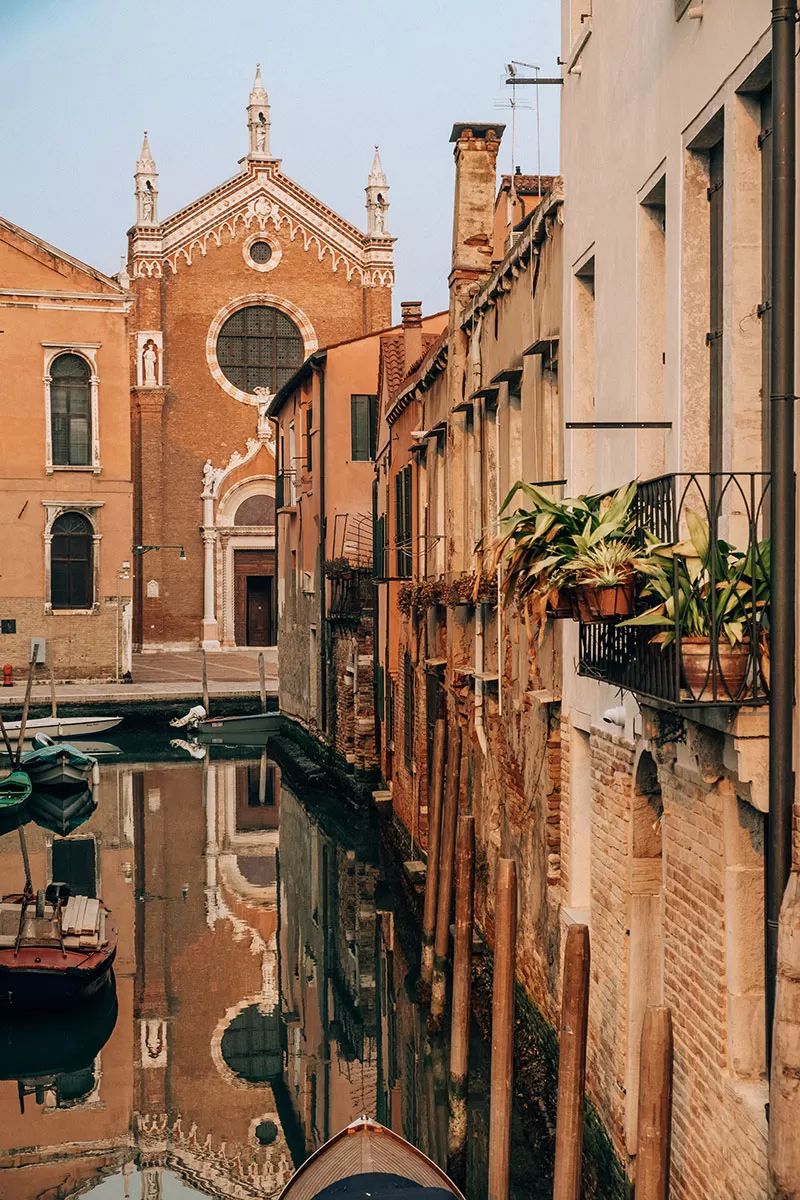 Located in the quiet north eastern sestiere of Cannaregio is Chiesa della Madonna dell’Orto. Founded in 1350 by the order of “Umiliati”, this church is dedicated to God, the Virgin Mary and St. Christopher who is the protector of travellers and ferry sailors.
Located in the quiet north eastern sestiere of Cannaregio is Chiesa della Madonna dell’Orto. Founded in 1350 by the order of “Umiliati”, this church is dedicated to God, the Virgin Mary and St. Christopher who is the protector of travellers and ferry sailors.
Its name literally translates to Church of the Madonna in the Vegetable garden which was inspired by a miracle statue of the Madonna found in a nearby vegetable garden. It belonged to Giovanni De Santi who left the statue there at first unfinished. The statue caught the attention of the citizens when the artist’s bride saw some weird flashlights coming from the statue. It soon became a cult object which forced the church to buy the statue.
De Santi was given the right to be buried in front of the statue wherever they placed it as well as being paid 150 ducati (a huge sum of money for the time).
The Church is one of the most beautiful examples of gothic architecture in Venice, the façade and the cloister was made in 1460-1464.
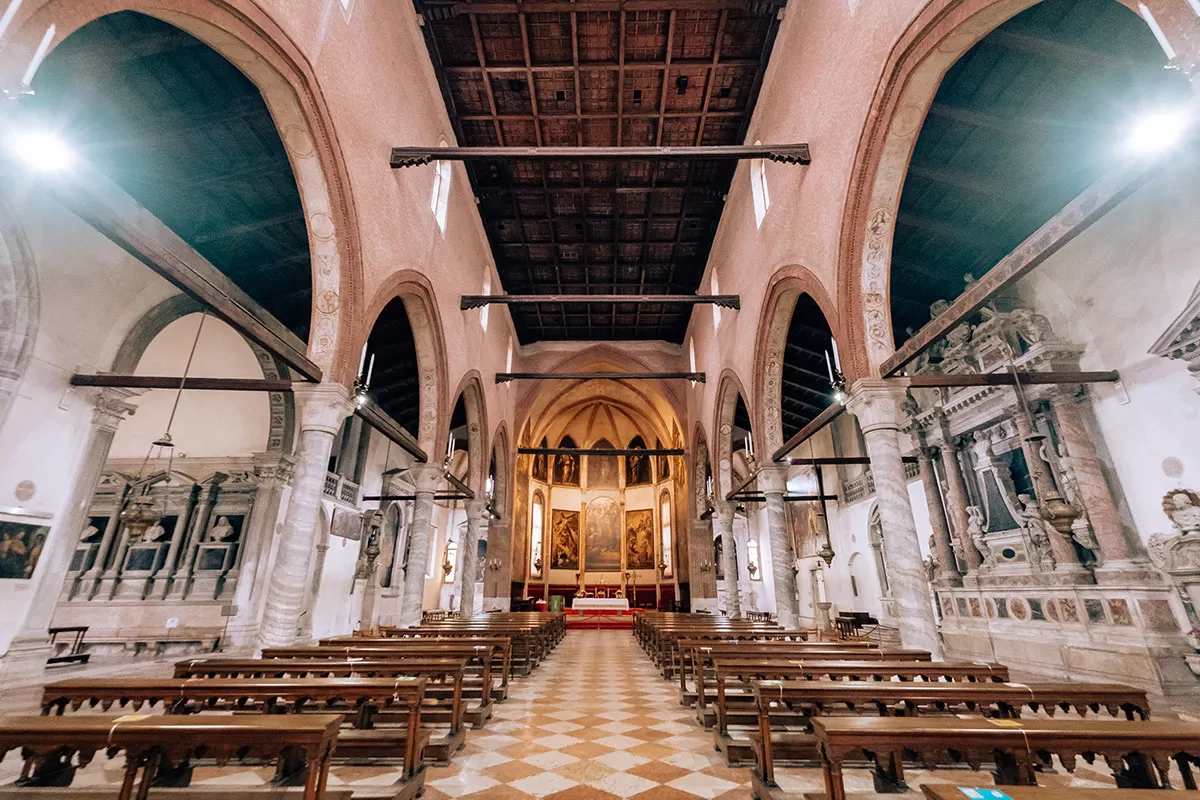 There are three main reasons to visit this church. First, in the front of the church in the large square is the only place in Venice where you can see the original brick pavement that once lined all the streets in Venice.
There are three main reasons to visit this church. First, in the front of the church in the large square is the only place in Venice where you can see the original brick pavement that once lined all the streets in Venice.
Secondly, inside the Church are 10 large paintings by famous Venetian painter Tintoretto who lived and worked nearby. These include Presentation of Virgin at Temple, The Last Judgment and The beheading of St. Paul.
Last but not least, Tintoretto is buried here alongside his 10 pieces of artwork.
Entrance to the church is by donation which is 3 euros and it’s definitely worth it.
17. See the stunning mosaics inside Church of Santa Maria and San Donato
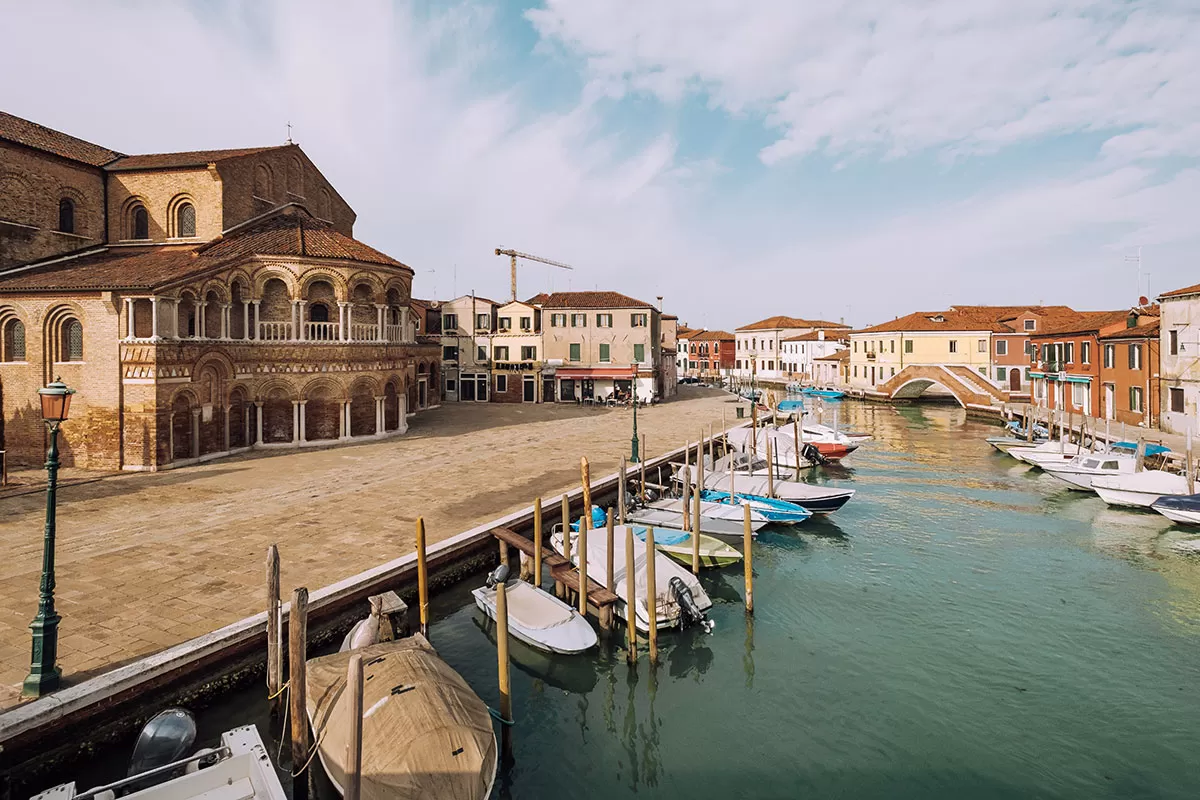
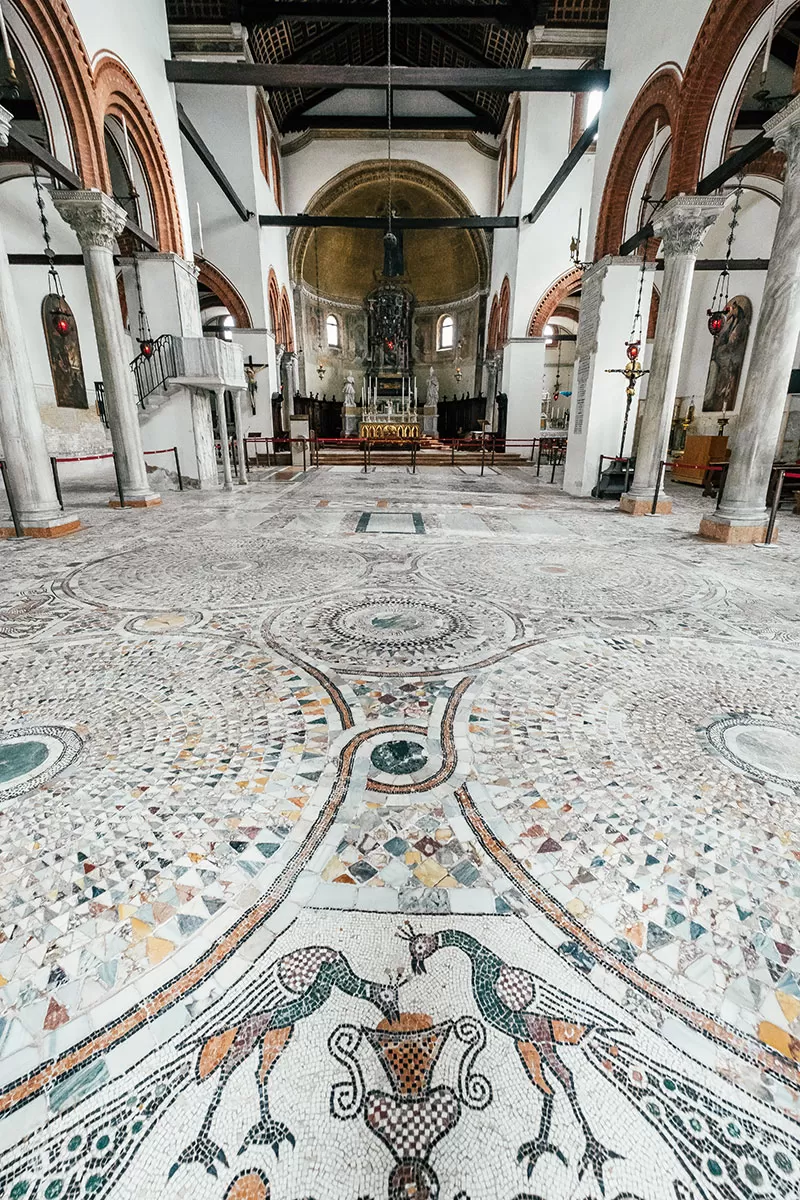 Located on the island of Murano is the Church of Santa Maria and San Donato. The original church was dedicated to the Virgin Mary in the seventh century and founded by the Muriani and Muraneschi families who settled on Murano from mainland Altino.
Located on the island of Murano is the Church of Santa Maria and San Donato. The original church was dedicated to the Virgin Mary in the seventh century and founded by the Muriani and Muraneschi families who settled on Murano from mainland Altino.
The church you see today was completely rebuilt between 1125 and 1140 in a Veneto-Byzantine style. At that time it received the precious relics of the dragon-slaying bishop Saint Donatus of Euroea (Arezzo) which are behind the altar
What makes this church unique is its colourful and impressive twelfth-century floor mosaics that were laid at the same time as those in the Basilica di San Marco.
There are two kinds of mosaic: tessellatum and sectile. Those in the tessellatum style are formed by little squares that create figures and symbolic elements of human vices and virtues.
While those in the sectile style appear as little marble slabs cut in geometric shapes that are used to create abstract representations of the highest religious symbolism.
18. See the inner workings of Torre dell’orologio (Clock Tower)
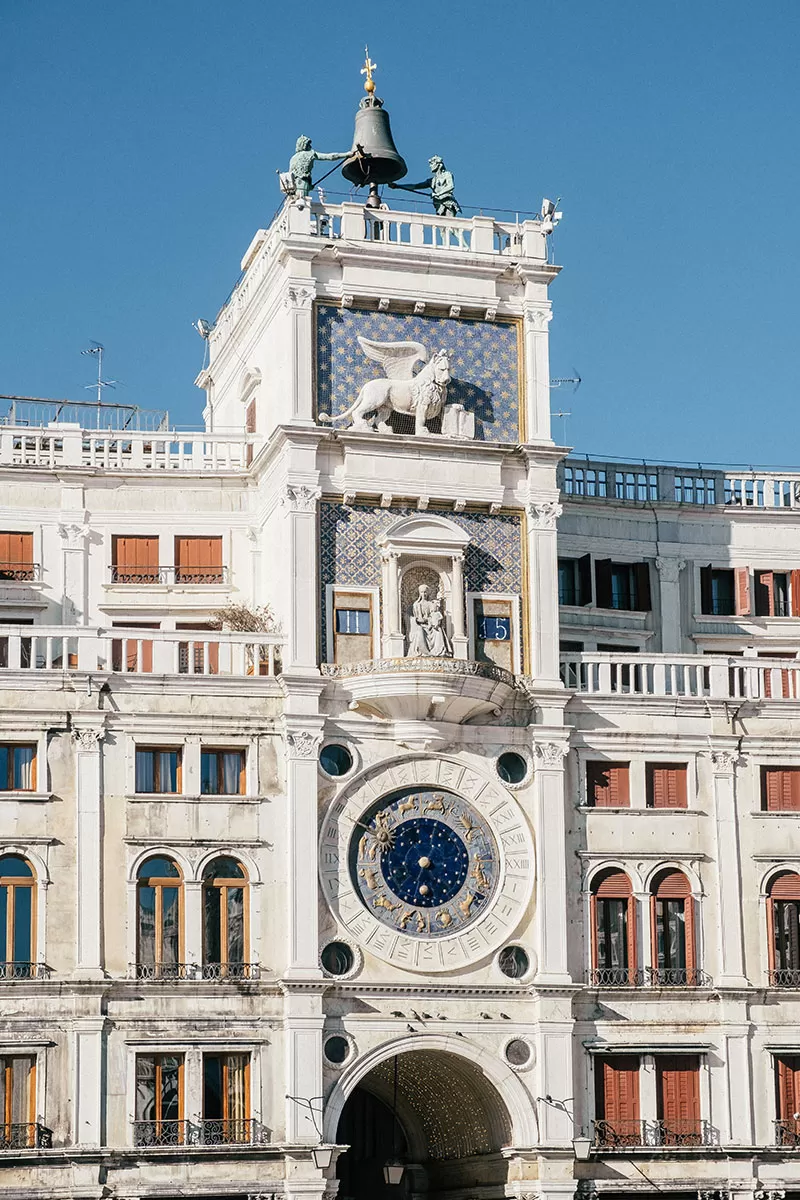 Keeping time for over 500 years is the beautiful 15th century Torre dell’Orologio, (Clock Tower) and its astronomical clock covered in gold-leafed, that tracks lunar phases. This monument is truly a masterpiece of technology and engineering.
Keeping time for over 500 years is the beautiful 15th century Torre dell’Orologio, (Clock Tower) and its astronomical clock covered in gold-leafed, that tracks lunar phases. This monument is truly a masterpiece of technology and engineering.
Located in St. Mark’s Square, the Clock Tower plays a key role in the overall urban layout of the city and is an essential point of focus in Piazza San Marco. Located above a triumphal archway that leads to the Rialto Bridge, this monument marks the access to the city’s main commercial artery; the Merceria which means “goods “, because that’s exactly where “goods” were sold.
The clock tower was placed in this exact location because it is the only place in the square that can be seen from the St. Mark’s basin. This way, incoming boats could see both the time and phrases of the moon so they could safely plan their sea voyages.
What’s interesting about this clock is that the digits change in increments of 5 minutes; not at the top of each hour but 2 minutes before and 2 minutes afterwards, this ensures that it doesn’t “compete” for attention when St Mark’s Bell Tower (Italian: Campanile di San Marco) sounds.
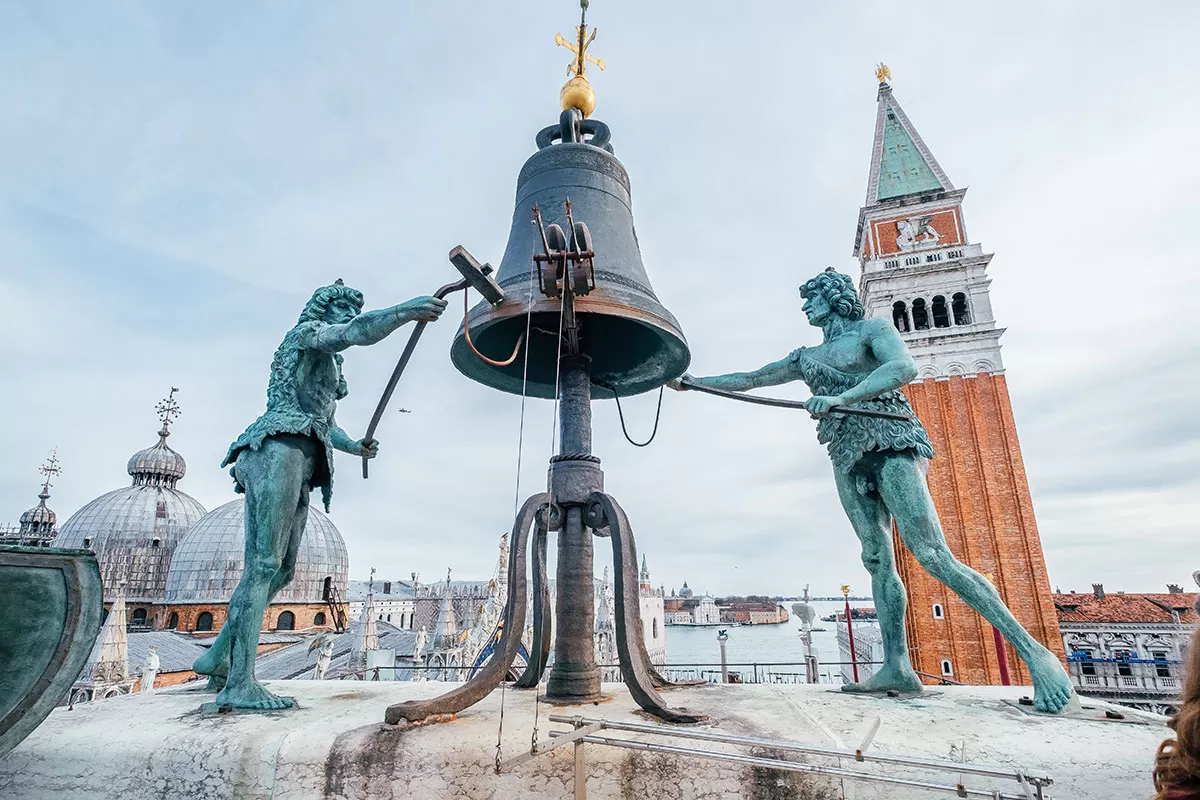 Ringing the bell are the two hardest-working men in Venice who haven’t moved from their post since the clock was built. There are ‘Do Mori’ (or Two Moors) and are named so because they are made of bronze, and over time, their colour changed to a darker tone: but they actually have European faces.
Ringing the bell are the two hardest-working men in Venice who haven’t moved from their post since the clock was built. There are ‘Do Mori’ (or Two Moors) and are named so because they are made of bronze, and over time, their colour changed to a darker tone: but they actually have European faces.
The entire structure works like clockwork thanks to an impressive and complicated system of gear wheels located within a large cruciform metal framework at the centre of the Tower. This tower is also where the clock-keeper and his family lived, the last one left in 1999, after which his role was replaced with an automatic system.
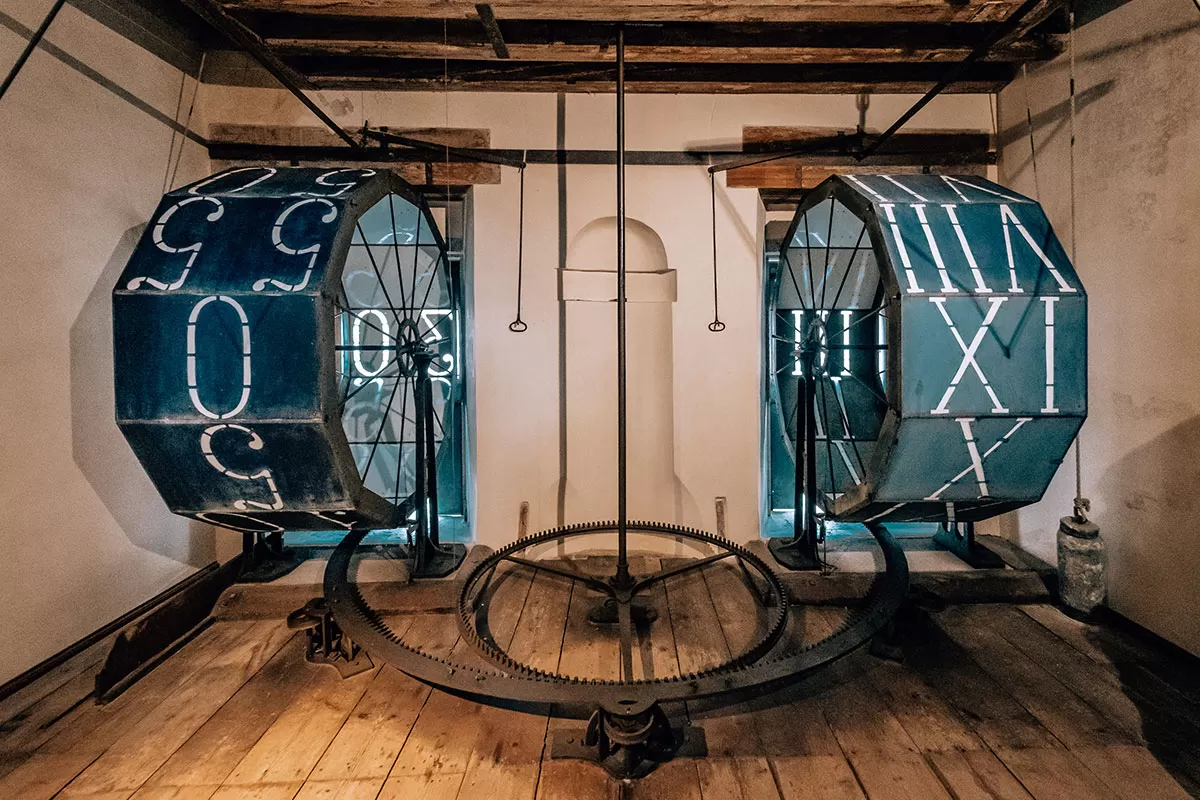 On a more morbid note, when public executions took place between the two columns, one of Theodore and the other of the winged lion, the condemned were forced to face the clock tower so they would see the hour of their death.
On a more morbid note, when public executions took place between the two columns, one of Theodore and the other of the winged lion, the condemned were forced to face the clock tower so they would see the hour of their death.
In fact, when someone, such as a child misbehaves or does something they shouldn’t, there is even a Venetian expression that goes: Ti faccio vedere io che ore sono!, meaning ‘I’ll show you what time it is!
What many visitors don’t know is that you can actually book a special guided tour so you can see the inner workings of this fabulous timepiece. But not only that, you get special access to the terrace and rooftop where you get up close and personal with the Two Moors. From here, you’ll see Venice from a truly unique perspective.
A visit to the Clock Tower is included in the Venice Museum pass for an additional fee. You need to book your visit well in advance, either online for an additional booking fee or by going directly to Museo Correr (Correr Museum) located at the opposite end of Piazza San Marco.
19. Visit the colourful island of Burano
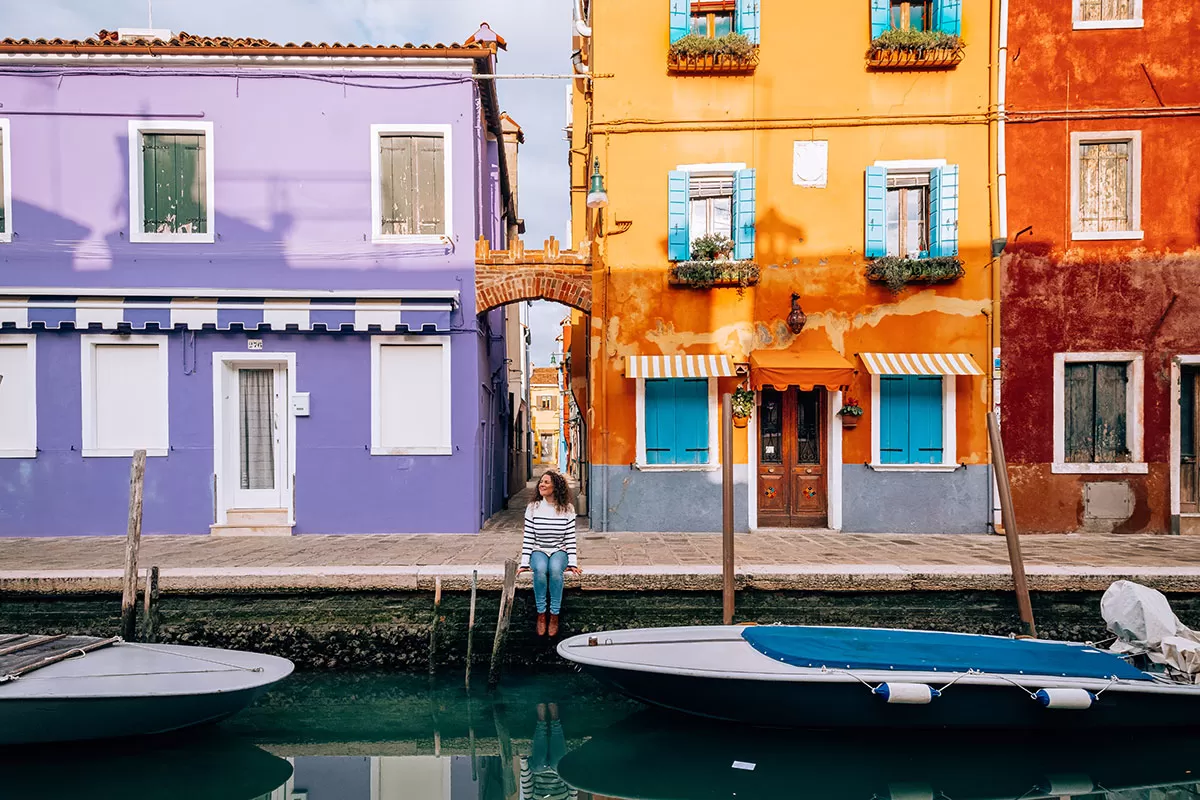 Located at the northern end of the Venetian lagoon is the cheerfully colourful island of Burano. Many people visit Burano on a day trip, but there’s so much more to enjoy and discover on this famously vibrant cluster of tiny islands, which is why I’ve created a detailed video guide and Burano travel guide and how to best experience it. If you’re short on time, I recommend joining this wonderful walking tour with Silvia, who was born and raised here on the island.
Located at the northern end of the Venetian lagoon is the cheerfully colourful island of Burano. Many people visit Burano on a day trip, but there’s so much more to enjoy and discover on this famously vibrant cluster of tiny islands, which is why I’ve created a detailed video guide and Burano travel guide and how to best experience it. If you’re short on time, I recommend joining this wonderful walking tour with Silvia, who was born and raised here on the island.
20. Visit Torcello, the lagoon’s first inhabited island
An Island that doesn’t get nearly enough attention is Torcello. Today, only 8 people live on Torcello, which is located at the northern end of the Venetian Lagoon near Burano. But it was here that the history of Venice began!
Torcello was first settled in the year 452 and is considered to be the parent island from which Venice was eventually populated.
After the downfall of the Western Roman Empire, Torcello was one of the first lagoon islands to be successively populated by the Veneti who fled the terra ferma (mainland) to seek safety from constant barbarian invasions, especially after Attila the Hun had destroyed the city of Altinum and all surrounding settlements in 452. Altinum was an ancient town of the Veneti 15 km Southeast of modern Treviso, close to the mainland shore of the Lagoon of Venice.
Torcello quickly grew as an important political and trading centre. By the 10th century, it had a population of approximately 25,000 people and an impressive Basilica to host them.
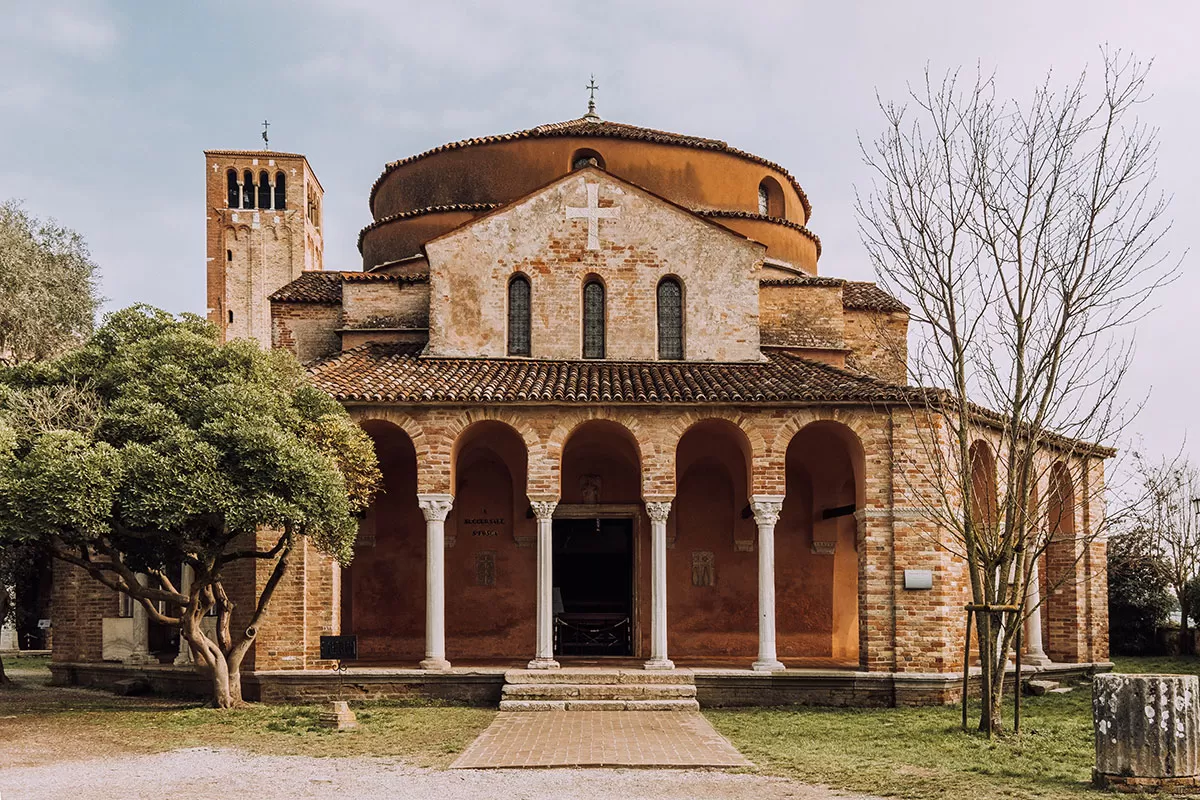 In pre-Medieval times, Torcello was a much more powerful trading centre than Venice. This was due to the area salt marshes, where its salines became Torcello’s economic backbone. As a result, its harbour quickly grew into an important re-export market in the profitable east-west trade, which was largely controlled by Byzantium at the time
In pre-Medieval times, Torcello was a much more powerful trading centre than Venice. This was due to the area salt marshes, where its salines became Torcello’s economic backbone. As a result, its harbour quickly grew into an important re-export market in the profitable east-west trade, which was largely controlled by Byzantium at the time
After a series of outbreaks of the plague, a further serious issue for Torcello specifically was that the swamp area of the lagoon around the island increased by the 14th century, due to the lowering of the land level. Navigation in the laguna morta (dead lagoon) was impossible and before long, traders ceased calling at the island. The increase of swamps also caused malaria and by the end 14th century, a significant number of people moved to either Murano, Burano or Venice. Today, Torcello now has a full-time population of around 10 people, including the parish priest.
Cross Ponte del diavolo
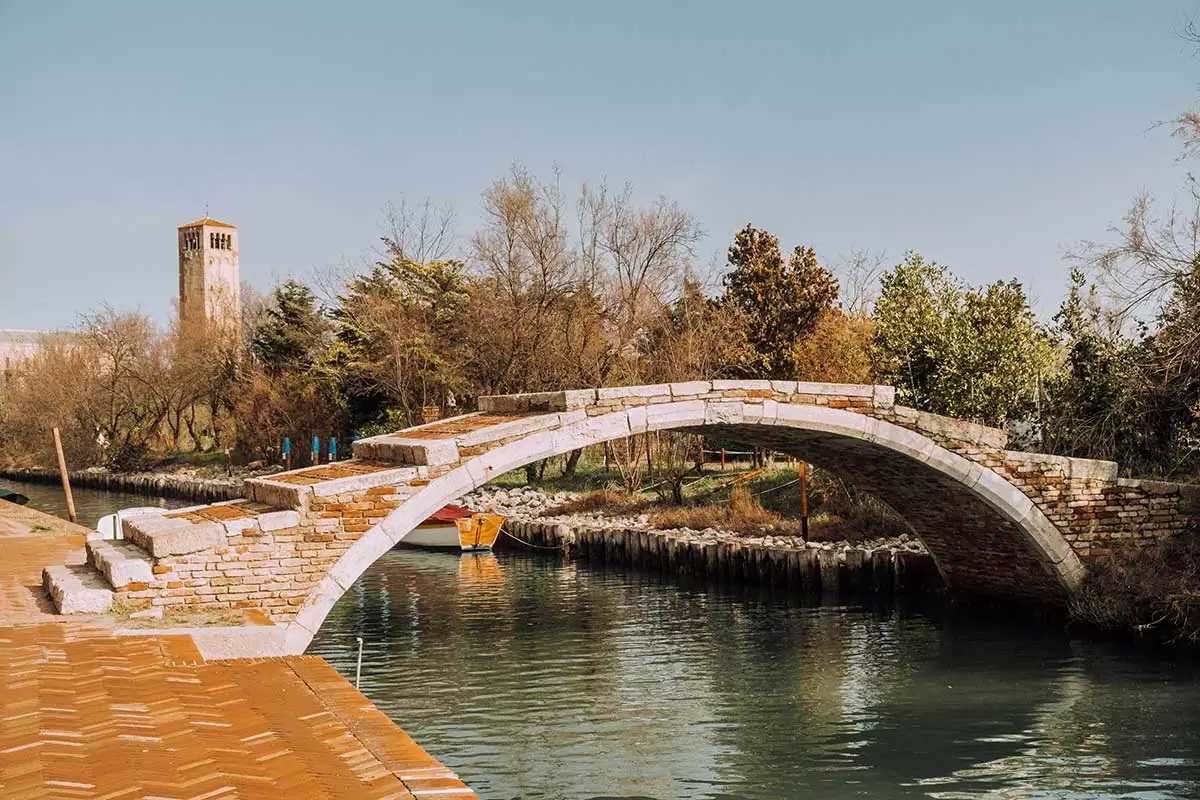 One of the two bridges of Torcello is the Ponte del diavolo (Devil’s bridge) that crosses the Maggiore Canal, the waterway that connects the historic centre of Torcello with the lagoon. It dates back to the fifteenth century but recent archaeological investigations have established that its foundations are grafted onto pre-existing foundations, from the thirteenth century.
One of the two bridges of Torcello is the Ponte del diavolo (Devil’s bridge) that crosses the Maggiore Canal, the waterway that connects the historic centre of Torcello with the lagoon. It dates back to the fifteenth century but recent archaeological investigations have established that its foundations are grafted onto pre-existing foundations, from the thirteenth century.
What makes Devil’s Bridge special is its shape without railings, typical of how Venetian ancient bridges were once built. Together with the Ponte Chiodo (Nail’s Bridge) in Cannaregio, these are the only two bridges in the lagoon that still maintain their ancient form.
The origin of the name is uncertain. Some say that “Diavoli” (devils) was the nickname of a local family; while others believe the name comes from a local legend about a Venetian girl, a witch, and an Austrian soldier.
Sit on Attila’s Throne
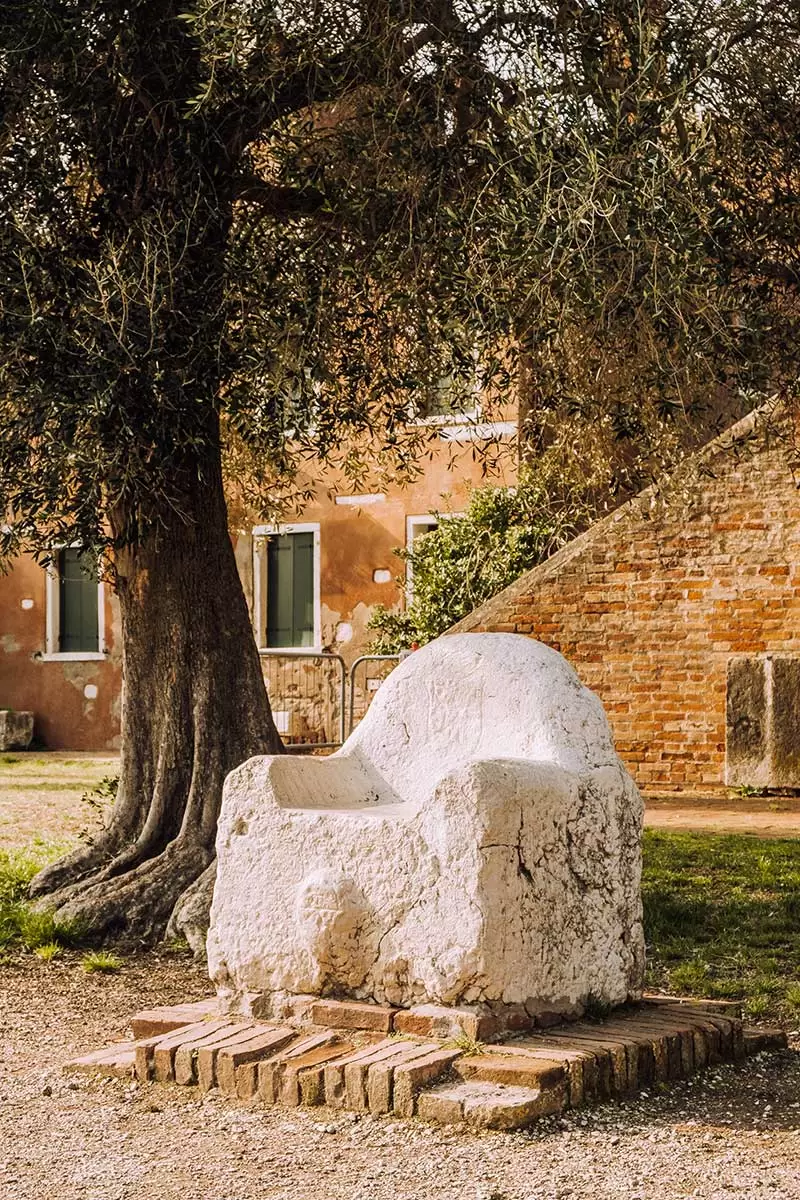 Located in front of Basilica di Santa Maria Assunta is Attila’s Throne – an ancient stone chair. It has, however, nothing to do with the king of the Huns, as it was put her around 100 years after his death and was most likely the podestà’s or the bishop’s chair.
Located in front of Basilica di Santa Maria Assunta is Attila’s Throne – an ancient stone chair. It has, however, nothing to do with the king of the Huns, as it was put her around 100 years after his death and was most likely the podestà’s or the bishop’s chair.
There are several legends about the throne’s history. The most famous is that whoever sits on the throne will return to Torcello. Another legend says that Attila himself used the throne. However, the throne was most likely the seat of power for the Magister militum, who was the governor of the island.
21. See the lagoon’s oldest mosaics Basilica di Santa Maria Assunta (Torcello)
Founded in 639, Basilica di Santa Maria Assunta is the lagoon’s oldest Byzantine basilica. The most important artistic element and the main reason to visit is to see the mosaics inside the cathedral, which are the earliest remaining mosaics in the Venetian lagoon.
Not to be missed is the mosaic of the Last Judgment found on the entrance wall of the church. One particular section of this immense and apocalyptic depiction, actually inspired Dante Alighieri, the father of the Italian language who wrote the La Divina Commedia, the Divine Comedy, almost a century later.
In the subdivision of penalties, which Dante includes in the Divine Comedy, there are seven compartments with a condemned soul for each of the seven deadly sins. These correspond to the circles in the Divine Comedy.
You can also head to the top of the campanile (bell tower) where you’ll get a fantastic view over the lagoon.
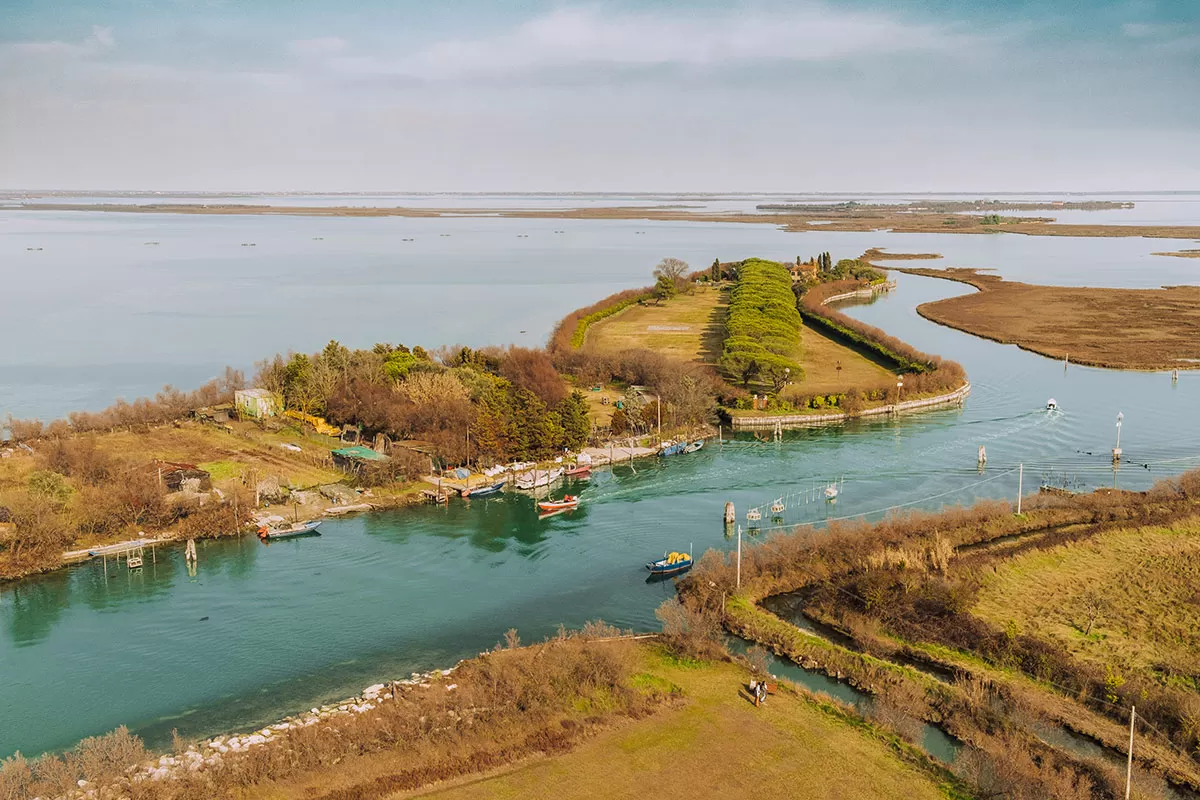
Accommodation
During my month in Venice, I start in various locations. Here is where I stayed and recommend.
Where to stay in Venice
Near St. Mark’s Square with canal view
During my first few days in Venice, I stayed in this one-bedroom apartment overlooking a quiet canal. The kitchen is full-equipped, the bedroom doubles as a lounge area with a couch and TV, and the bathroom is spacious. Click here to check availability and book your stay.
Rialto Apartment with view of the Grand Canal and Rialto bridge
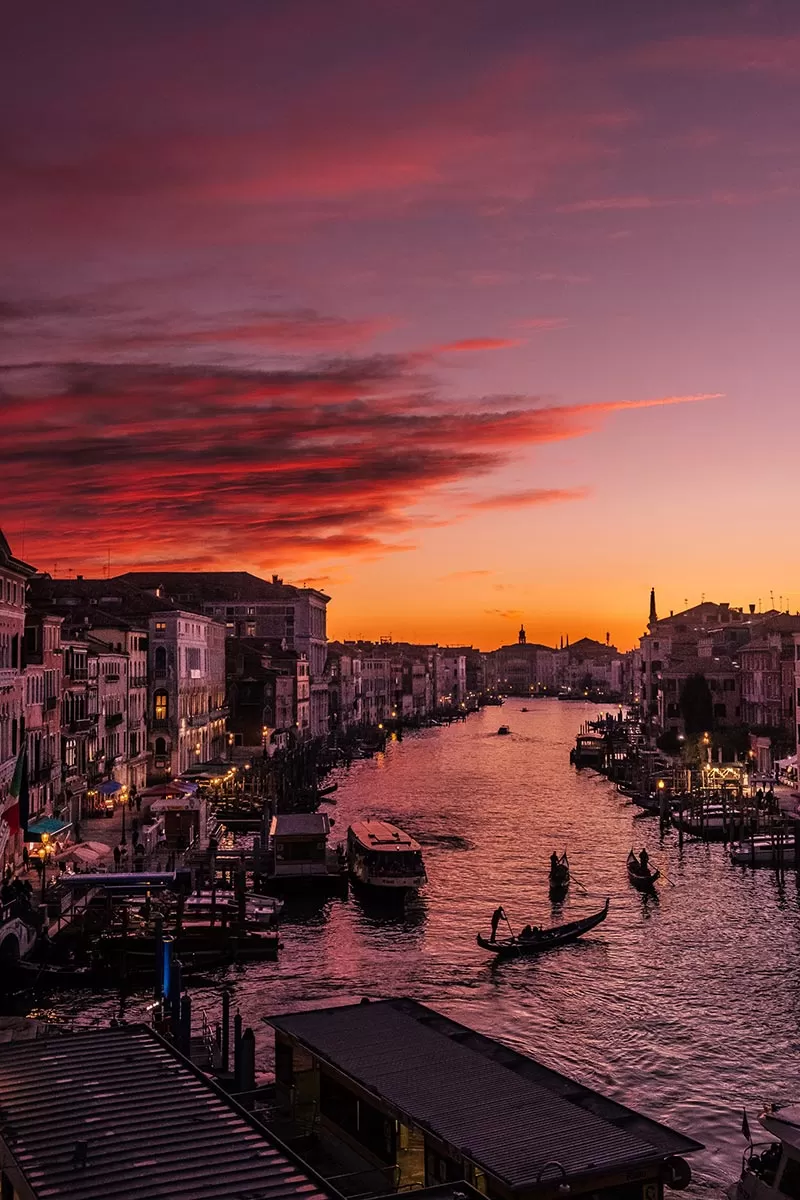
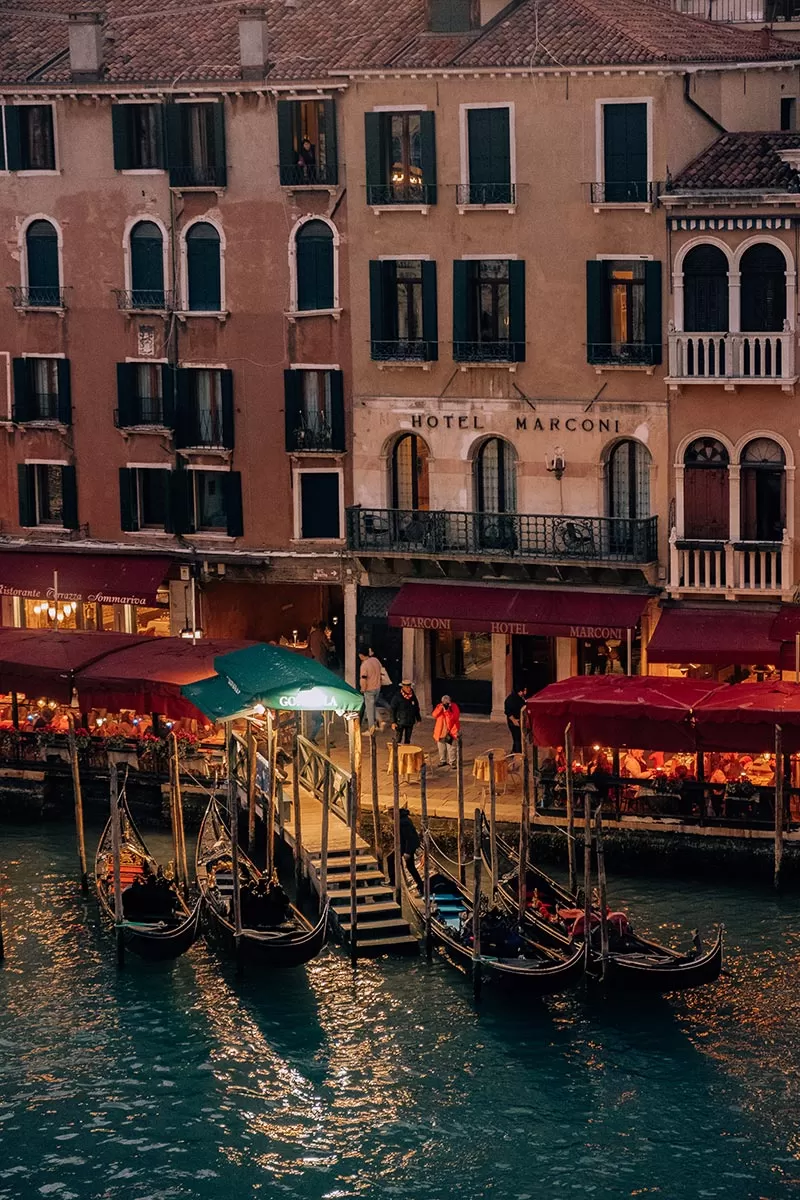
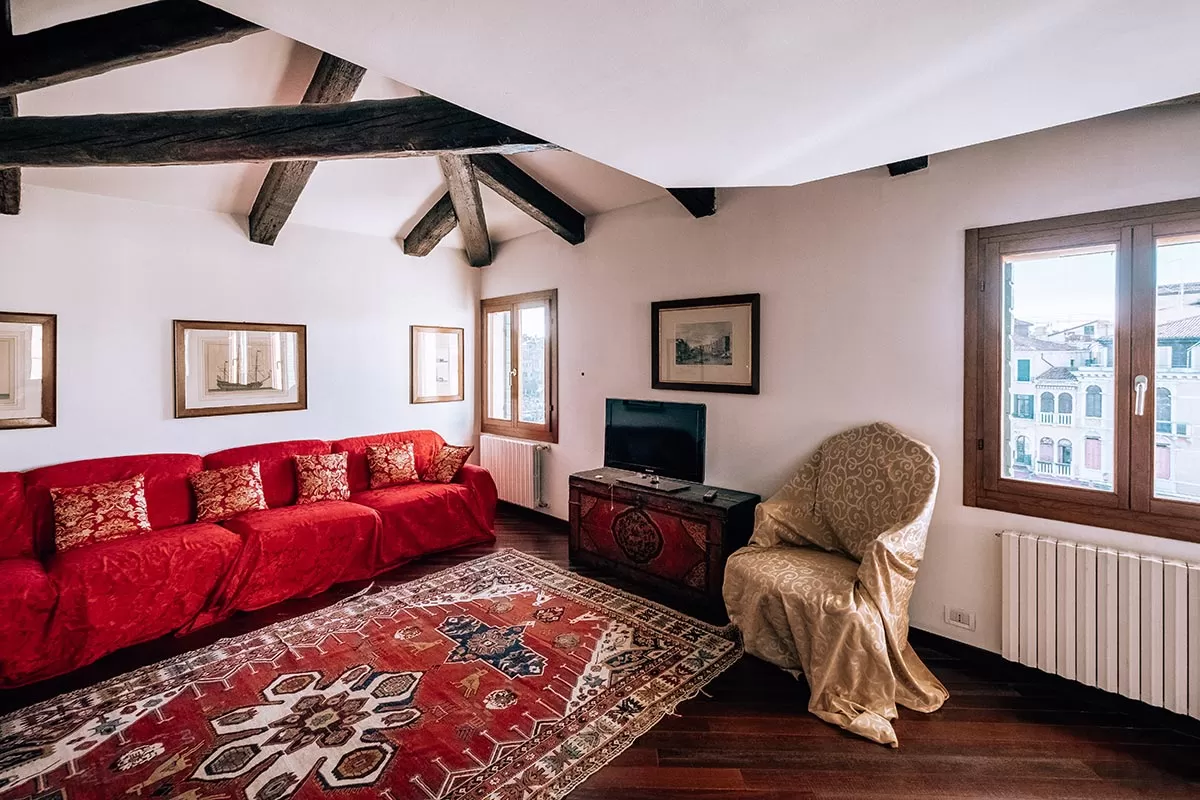
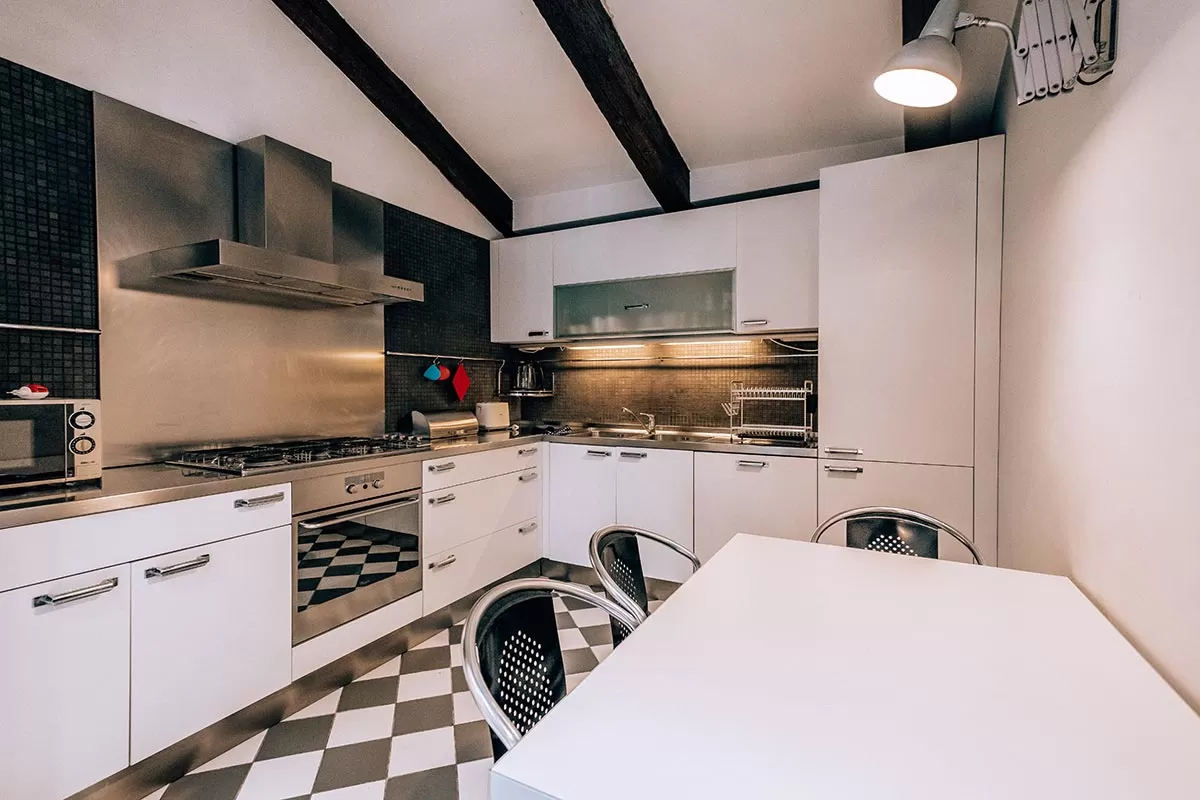 It’s not every day you get to wake up in front of the Rialto bright. So, when I saw this luxurious and spacious apartment overlooking the Grand Canal and the Rialto bridge, I couldn’t resist. Not only does it have a view to die for, but there is also a fully equipped kitchen and a separate washer and dryer. There is a large bedroom and ensuite bathroom and a second separate toilet. The large lounge area has a huge sofa and TV and a large dining table. The only downside (if you’re mobility impaired) is that being on the top floor you have to climb 4 flights of stairs as Venice rarely has lifts/elevators in its buildings. Click here to check availability and book your stay.
It’s not every day you get to wake up in front of the Rialto bright. So, when I saw this luxurious and spacious apartment overlooking the Grand Canal and the Rialto bridge, I couldn’t resist. Not only does it have a view to die for, but there is also a fully equipped kitchen and a separate washer and dryer. There is a large bedroom and ensuite bathroom and a second separate toilet. The large lounge area has a huge sofa and TV and a large dining table. The only downside (if you’re mobility impaired) is that being on the top floor you have to climb 4 flights of stairs as Venice rarely has lifts/elevators in its buildings. Click here to check availability and book your stay.
Overlooking St. Mark’s Cathedral and Bell Tower (Campanile di San Marco)
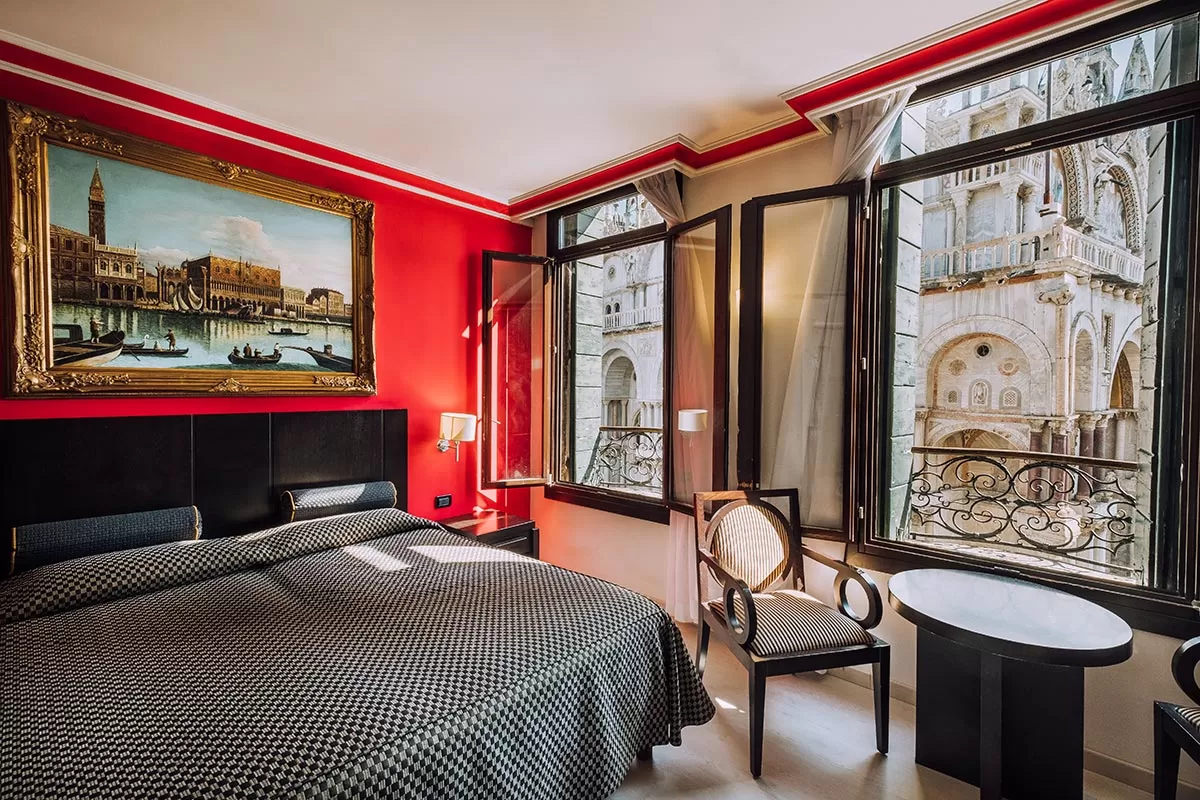
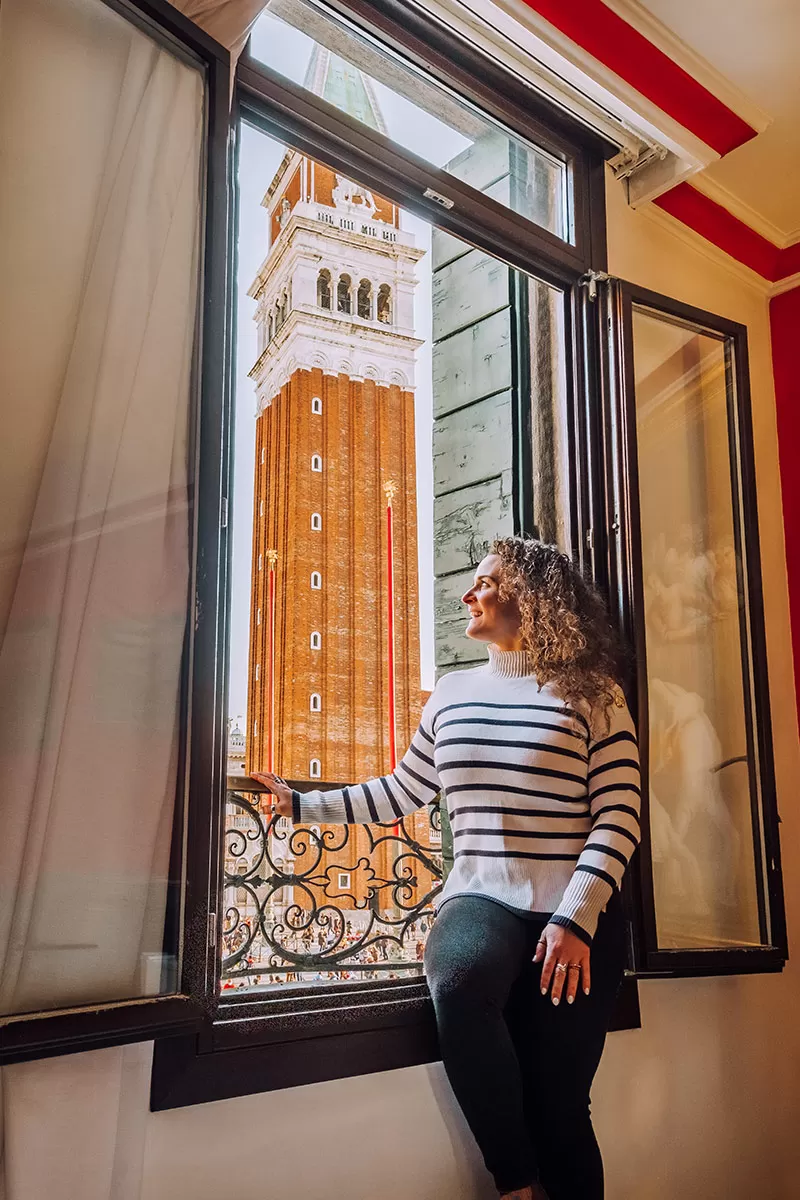 To end my month-long stay in Venice, I stayed in this room overlooking St. Mark’s Square which gives you a unique perspective of the St. Mark’s cathedral and bell tower and the waterfront. The room is decorated with colourful Venetian-themed paintings. There is a TV and small fridge and a separate, large bathroom. Click here to check availability and book your stay.
To end my month-long stay in Venice, I stayed in this room overlooking St. Mark’s Square which gives you a unique perspective of the St. Mark’s cathedral and bell tower and the waterfront. The room is decorated with colourful Venetian-themed paintings. There is a TV and small fridge and a separate, large bathroom. Click here to check availability and book your stay.
For more accommodation recommendations, see my guide to the best hotels in Venice for every budget
Where to stay in Murano
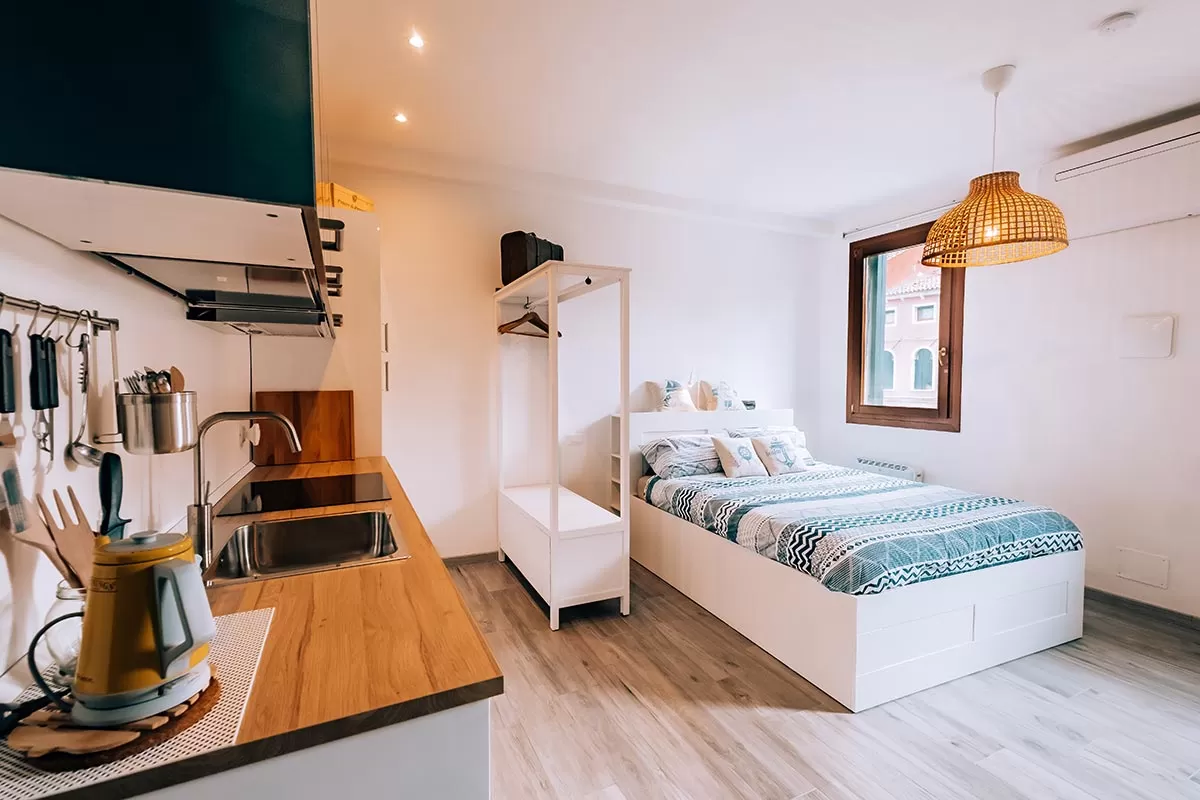
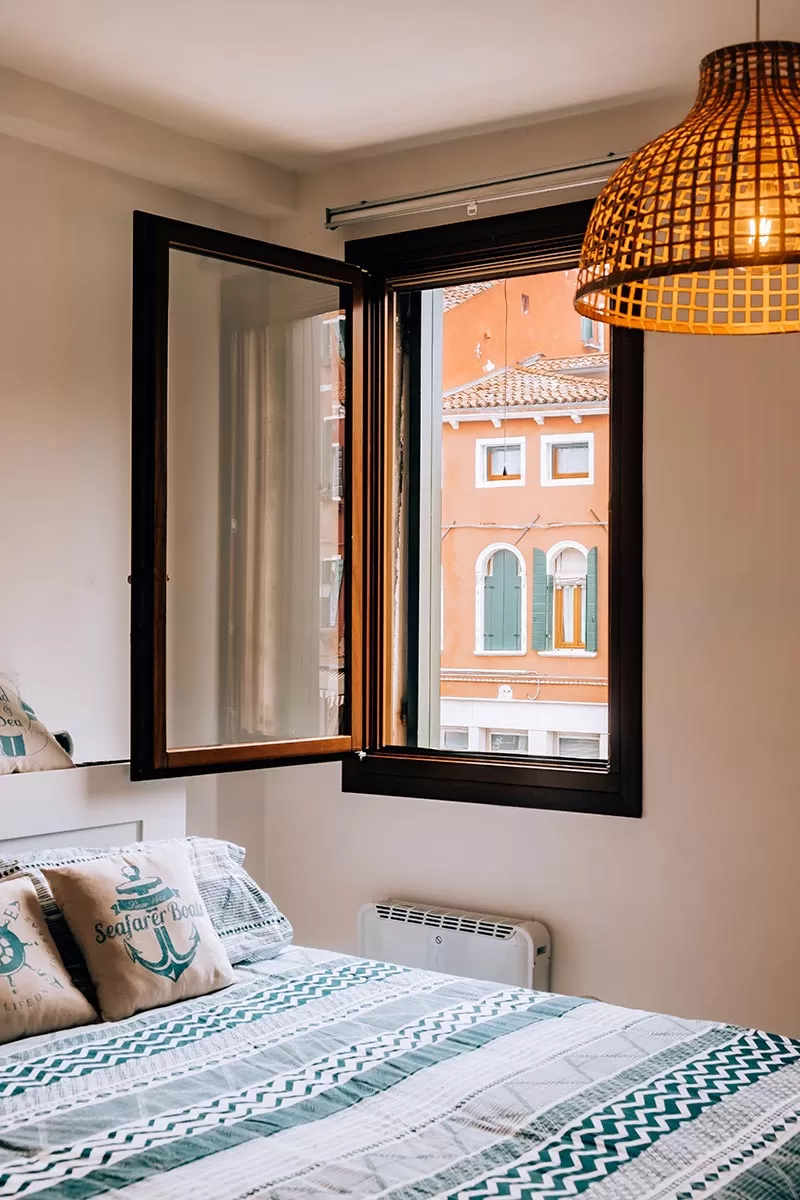
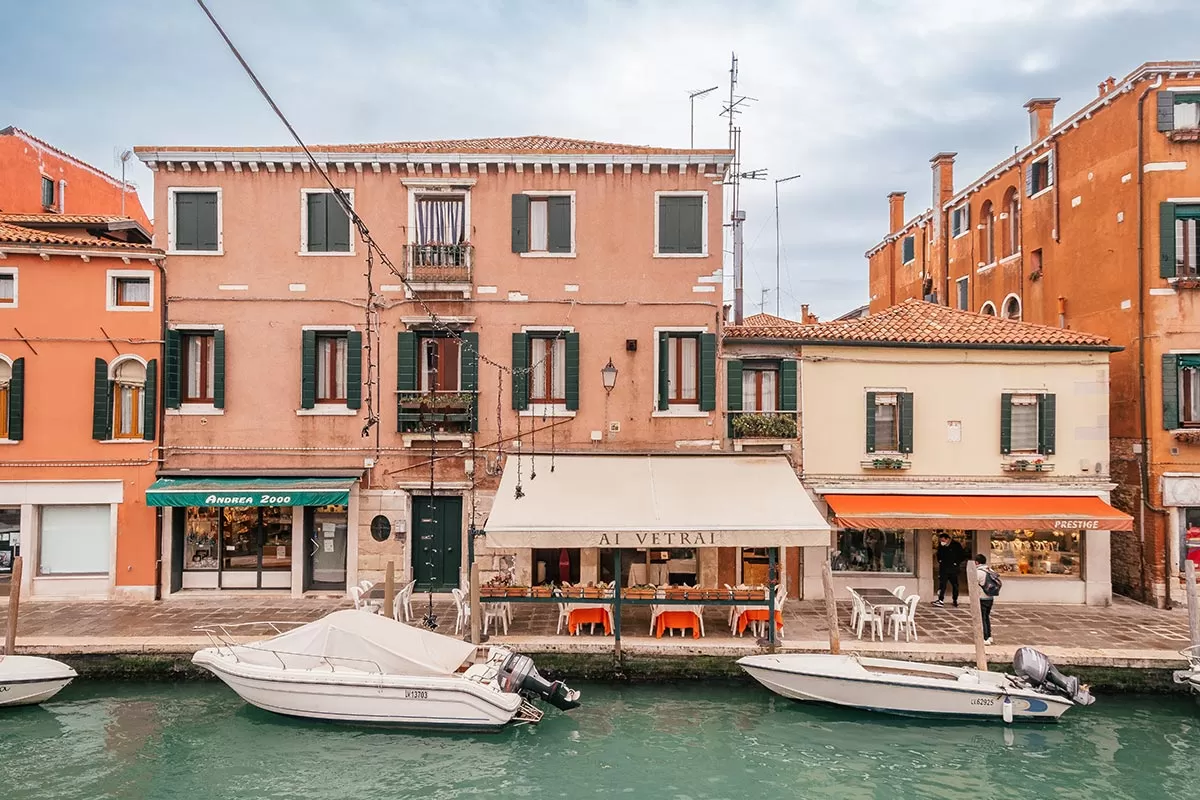
View from studio apartment in Murano
Located on one of Murano’s main canals, Fondamenta dei Vetrai, is this cosy and beautifully decorated studio apartment with stunning canal views. It’s conveniently located just a few doors down from the supermarket and Murano Colonna waterbus stop. I loved my stay here. The host, Elletra, was very welcoming and accommodating. Click here to check availability and book your stay.
Where to stay in Burano
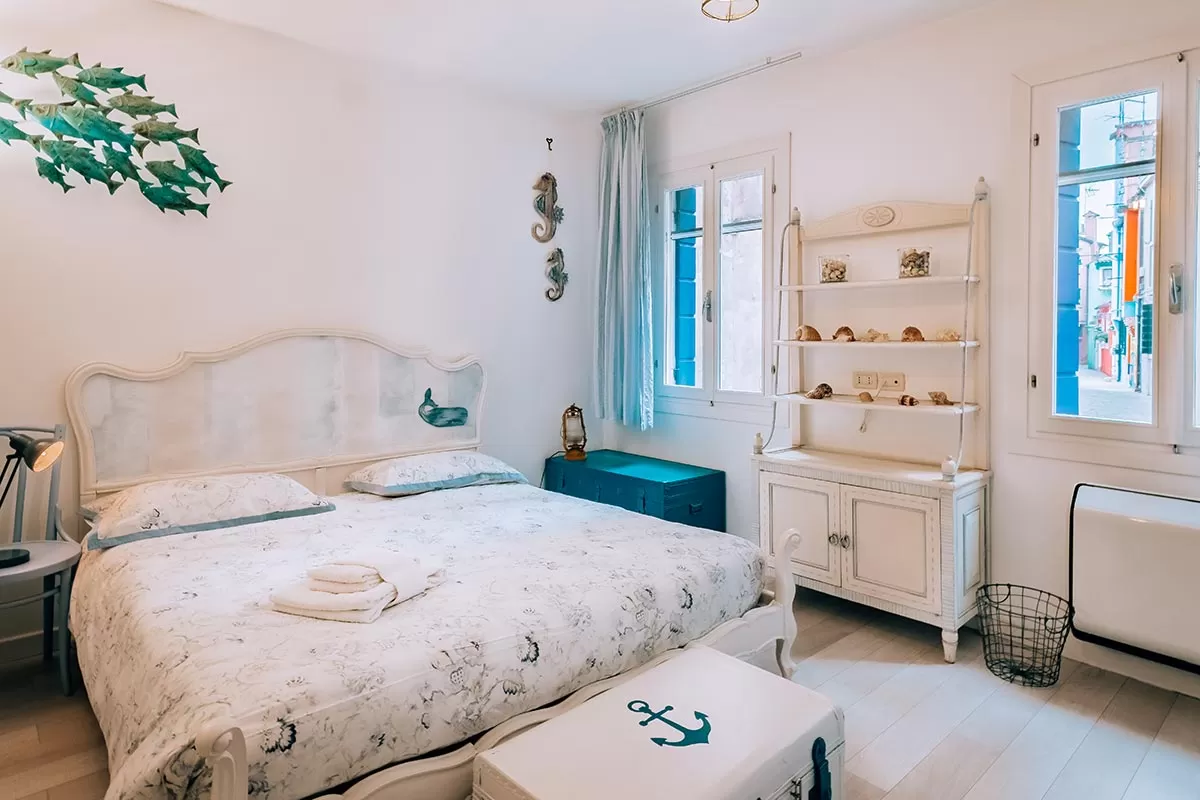
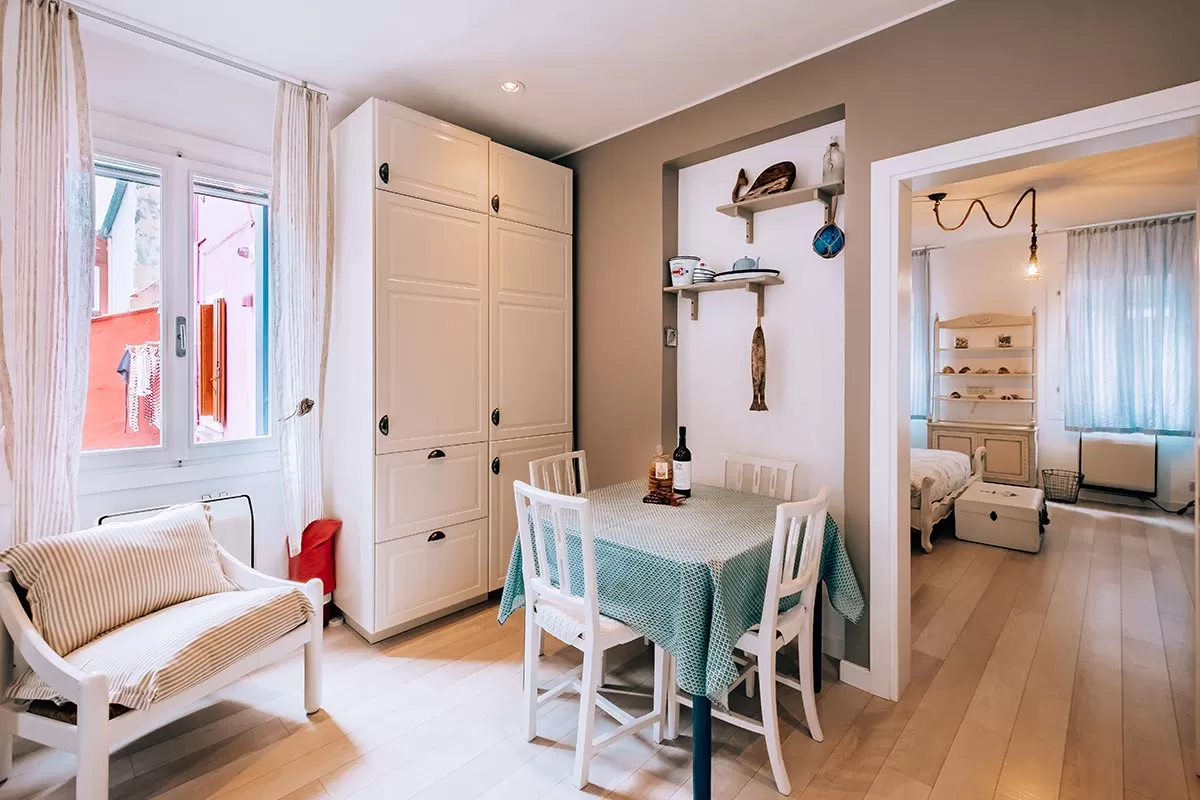 I stayed in Burano for five days and this wonderful nautical-themed house was perfect. Not only does sit have a bright peach exterior (in theme with the colourful island) it has everything you need. It’s perfect for a single occupant, a couple or a small family. There is a washer and dryer, a large bed and two bunk beds. The kitchen is fully equipped and even has a dishwasher. It’s located just one street behind the main street so it’s lovely and quiet. Click here to check availability and book your stay.
I stayed in Burano for five days and this wonderful nautical-themed house was perfect. Not only does sit have a bright peach exterior (in theme with the colourful island) it has everything you need. It’s perfect for a single occupant, a couple or a small family. There is a washer and dryer, a large bed and two bunk beds. The kitchen is fully equipped and even has a dishwasher. It’s located just one street behind the main street so it’s lovely and quiet. Click here to check availability and book your stay.
Allora, Eccoci qua! (So, there we have it!) My complete guide to unique things to do, see and experience in Venice. Which one of these did you enjoy the most? Do you have any questions? Let me know in the comments below.
Don’t be treated like a tourist. Learn Italian with my 80/20 method
Travelling to Italy? Don’t be treated like a tourist! Live your best travel experiences and learn Italian for less than the cost of eating at a tourist trap restaurant or a taxi driver who has “taken you for a ride”. I’ve made it easy for you to master the Italian language so you can create lifelong memories as you mingle with locals, get local tips, avoid tourist traps, and make new friends. Who knows, you may be even be invited over for afternoon tea by a lovely Sicilian family like I was! Read all about how speaking Italian changed my life and check out my online Italian video course here.
Here’s what my students are saying:

I really enjoyed the Intrepid Italian course, it certainly exceeded my expectations. The learning methodology is great, and easy to follow and found that I progressed much faster in the last 4 weeks than I ever did on my own or using other language apps. Grazie mille Michele, I can’t wait until I can put my new skills into action! – Roma Small
Click here for instant access!
Don’t miss these Italy travel guides
- 33 Italy Travel Tips That Will Save You Time, Money and Disappointment
- 12 BEST Things to do in Burano, Italy (Tips from a Local Guide)
- 29 Amazing Day Trips from Rome By Train, Car & Guided Tour
- Rome Tips and Tricks: 27 Things You Should Know Before You Go to Rome
- Top 10 Things to Do in Rome That Aren’t On Your List
- Top 10 Absolute Best Views of Rome That Will Blow Your Mind
- Domus Aurea: Visit Rome’s Secret Hidden Palace
- Self-Guided Trastevere Walking Tour: Where to See Rome’s Most Beautiful Streets
- Absolute Best Things to do in Verona, Italy | 26 Must-See Attractions
- Top 7 Authentic Tours and Experiences in Rome [Run by Locals]
- Lakes, Mountains & Castles: 21 Best Things to do in Trento, Italy
- Italy Fun Facts: 126 Unique Things You Didn’t Know About Italy
- 36 Wonderful Things to do in Umbria, Italy (PLUS Map of Umbria)
- Where to Stay in Rome | Best Hotels and Best Neighborhoods to Stay in Rome
- Where to Stay in Verona: Best Hotels in Verona Neighbourhoods
- Where to Stay in Venice | Best Hotels in Venice for Every Budget
- 29 Amazing Day Trips from Rome By Train, Car & Guided Tour
- 27 Best Things to Do in Trieste, Italy (PLUS Map, BEST Tours & Day Trips)
- THE 15 BEST Hotels in Trieste, Italy [2023 Edition]
- What it’s like Staying at DoubleTree by Hilton Trieste
Planning a trip and need travel insurance? Get a free quote from World Nomads here.
Like it? Pin it for later!
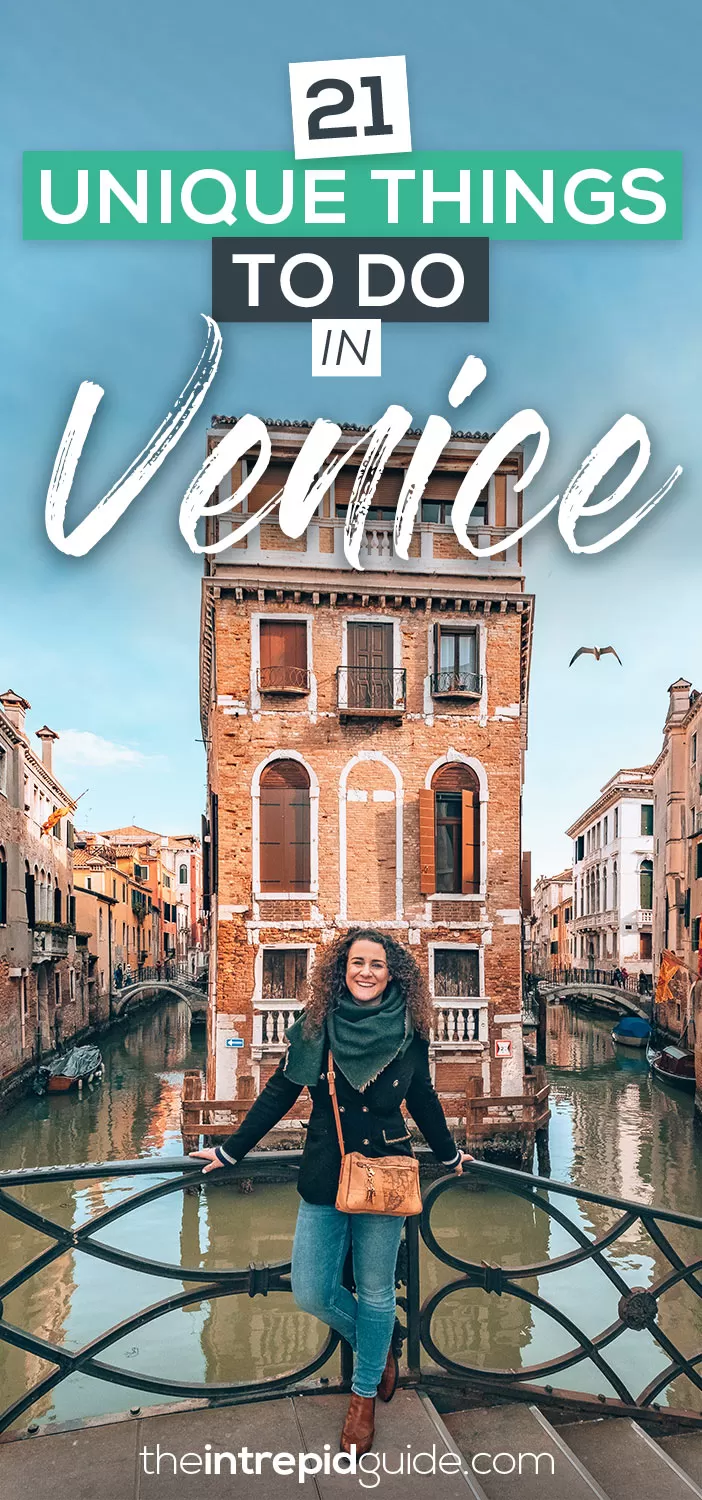
Over to you!
Have you visited any of these places? What other unique things in Venice would you recommend?
Let me know using the comments section below or join me on social media to start a conversation.
Thanks for reading and I hope you enjoyed this post.
Like what you see? Subscribe using the form below to have all of my posts delivered directly to your email.

